

How to Write a Book Report (Guide, Examples & Templates)
Don’t let a book report intimidate you. With this step-by-step guide, you’ll learn how to write a book report that not only meets your teacher’s expectations but also reflects your unique perspective.
Get ready to ace your assignment.
What Is a Book Report?

Table of Contents
A book report is a summary and analysis of a book that you have read. It provides a detailed account of the book’s content, its main themes, characters, and plot, as well as your personal reflections on the book.
Book reports are typically assigned to help students practice their reading comprehension and writing skills.
A book report differs from a book review.
While a book review focuses on the reader’s opinions and is often found in newspapers or magazines, a book report is more structured and provides a straightforward summary and analysis of the text.
It helps teachers gauge students’ understanding and interpretation of the book.
Types of Book Reports
Understanding the different types of book reports is essential as each has a unique focus and structure.
Here, we break down the main types:
Summary Book Report
A summary book report focuses on providing a concise summary of the book’s main points. It covers the key elements such as the plot, characters, and main themes without going into too much detail.
Key Elements:
- Overview of the main plot points.
- Brief descriptions of main characters.
- Discussion of the central themes.
Character Analysis Book Report
This type of book report delves into the analysis of one or more characters from the book. It examines their traits, motivations, and development throughout the story.
- Detailed analysis of main characters.
- Exploration of character motivations and actions.
- Discussion of character development.
Theme Analysis Book Report
A theme analysis book report focuses on the central themes of the book.
It explores how the author conveys these themes and how they are developed throughout the narrative.
- Identification of major themes.
- Analysis of how these themes are portrayed.
- Examples from the text to support the analysis.
Comparative Book Report
A comparative book report compares two or more books, examining their similarities and differences. This type of report often requires a deeper level of analysis and critical thinking.
- Comparison of plot elements.
- Analysis of character similarities and differences.
- Examination of themes across the books.
What Should Go Into a Book Report?
When writing a book report, it’s important to include several key elements to ensure it is comprehensive and informative.
Each element serves a specific purpose in providing a thorough analysis of the book.
- Title and Author : Start with the book’s title and the author’s name. This sets the stage for your report and provides the necessary context for the reader.
- Plot Summary : Provide a brief summary of the book’s plot. Focus on the main events and avoid excessive details or spoilers.
- Characters : Describe the main characters and their roles in the story. Discuss their personalities, motivations, and development.
- Themes : Discuss the main themes and messages of the book. Explain how these themes are conveyed and their significance.
- Personal Reflection : Share your thoughts and opinions about the book. Discuss how it affected you, what you liked or disliked, and any lessons you learned.
- Conclusion : Summarize your overall impressions and the book’s impact on you. Provide a final recommendation and discuss whether you would suggest this book to others.
Book Report Outline
Creating an outline before writing your book report can help organize your thoughts and ensure you cover all necessary points.
Here’s a detailed outline to follow:
- Title and Author
- Publication Date
- Brief introduction to the book’s context or background
- Brief overview of the main events
- Major turning points
- Resolution of the story
- Main characters and their descriptions
- Character development and growth
- Important relationships between characters
- Central themes
- How they are portrayed
- Examples from the text to support your analysis
- Your opinion on the book
- How it affected you
- Any connections you made with the book
- Overall impressions
- Recommendation
- Final thoughts on the book’s impact
Next, we’ll go over how to write a book report in detail (covering all the steps). Then, I’ll give you a few templates and share a few full examples.
How to Write a Book Report
Writing a book report involves several steps that ensure a thorough analysis and clear presentation of your thoughts.
Below, we provide a step-by-step guide with detailed explanations for each step.
Step 1: Read the Book
Reading the book thoroughly is the first and most crucial step.
As you read, take notes on the main plot points, character developments, and significant quotes.
Highlight sections that you find particularly important or that you might want to reference in your report. This will make it easier to recall details when you start writing.
Step 2: Understand the Assignment
Make sure you understand the specific requirements of your book report assignment.
Different teachers may have different expectations regarding the length and content of the report.
Pay attention to the required length, format, and specific points that need to be covered. Understanding these requirements will help you tailor your report to meet the expectations.
Step 3: Create an Outline
Use the book report outline provided above to organize your thoughts and structure your report.
This will help you stay on track and ensure that you cover all necessary points
An outline serves as a roadmap for your report.
In addition to the outline above, I’ve also added a few templates later in this article that you can use.
Step 4: Write the Introduction
The introduction sets the stage for your report. Begin with the book’s title, author, and genre.
Provide some background information about the book, such as its publication date and any relevant historical context.
This could be information about the author’s inspiration, the historical period in which the book was written, or its reception at the time of publication.
Step 5: Summarize the Plot
Write a brief summary of the book’s plot. Focus on the main events and turning points, but avoid giving away any spoilers.
The plot summary should be concise yet comprehensive.
It’s a balancing act, for sure, but you’ll get better with a little practice.
Reading the examples in this guide will help you understand the balance you need.
Step 6: Analyze the Characters
Character analysis involves examining the traits, motivations, and growth of the main characters.
Describe the main characters and their roles in the story. Discuss how they develop throughout the book and what their actions reveal about them.
Discuss how they interact with one another and how they change over the course of the story.
Highlight any significant relationships or conflicts that contribute to their development.
Step 7: Discuss the Themes
Themes are the underlying messages or central ideas in the book.
Identify the central themes of the book and explain how they are portrayed.
Use specific examples and quotes from the text to illustrate your points. Explain why these themes are important and how they contribute to the overall meaning of the book.
Step 8: Reflect on the Book
Share your personal thoughts and opinions about the book. Discuss how it affected you and what you learned from it.
Talk about what you liked or disliked, any emotions it evoked, and any lessons you took away.
This section is an opportunity to connect your personal experiences with the content of the book.
Step 9: Write the Conclusion
The conclusion wraps up your report. Summarize your overall impressions of the book.
Provide a final recommendation and discuss whether you would suggest this book to others. This helps readers understand the impact of the book and its relevance.
Step 10: Proofread and Edit
Review your book report for any grammatical errors or typos. Make sure your writing is clear and concise.
Check for grammatical mistakes, spelling errors, and clarity.
Ensure that your writing flows smoothly and that your points are clearly communicated.
Before we go into the book report templates, check out this video on how to write a book report:
Book Report Templates
As promised, here are the book report templates you can use as your outline and inspiration.
Template 1: Summary Book Report
Title : Author : Genre : Publication Date :
Plot Summary : (Brief overview of the main events)
Characters : (Descriptions of the main characters)
Themes : (Discussion of the central themes)
Personal Reflection : (Your opinion and how the book affected you)
Conclusion : (Overall impressions and recommendation)
Template 2: Character Analysis Book Report
Character Analysis : (Detailed analysis of one or more characters)
Template 3: Theme Analysis Book Report
Theme Analysis : (Detailed analysis of the central themes)
Book Report Examples
Let’s go over some examples to show you exactly how to write a book report.
Keep in mind that I purposely made these examples shorter than you’ll probably want to write to save time and space in this blog post.
Example 1: Summary Book Report
Title : To Kill a Mockingbird Author : Harper Lee Genre : Fiction Publication Date : 1960
Plot Summary : The story is set in the 1930s in the fictional town of Maycomb, Alabama. It follows Scout Finch, her brother Jem, and their father Atticus Finch, a lawyer who defends a black man accused of raping a white woman. The book explores themes of racial injustice, moral growth, and empathy.
Characters :
- Scout Finch : The narrator and protagonist.
- Atticus Finch : Scout’s father, a lawyer, and moral backbone of the story.
- Jem Finch : Scout’s older brother.
- Tom Robinson : The black man accused of rape.
- Racial Injustice : The unfair treatment of black people in the legal system.
- Moral Growth : The development of Scout and Jem’s understanding of right and wrong.
- Empathy : Understanding others’ perspectives.
Personal Reflection : To Kill a Mockingbird deeply moved me. The themes of racial injustice and moral growth are still relevant today. The characters are well-developed, and the story is powerful and thought-provoking.
Conclusion : Overall, To Kill a Mockingbird is a must-read. It offers valuable lessons on empathy and justice. I highly recommend it.
Example 2: Character Analysis Book Report
Title : Harry Potter and the Sorcerer’s Stone Author : J.K. Rowling Genre : Fantasy Publication Date : 1997
Plot Summary : Harry Potter discovers he is a wizard on his 11th birthday. He attends Hogwarts School of Witchcraft and Wizardry, makes friends, and uncovers the truth about his parents’ deaths. He confronts the dark wizard Voldemort.
Character Analysis :
- Harry Potter : An orphaned boy who learns he is a wizard. Brave, loyal, and determined.
- Hermione Granger : Harry’s intelligent and resourceful friend. Known for her knowledge and quick thinking.
- Ron Weasley : Harry’s loyal and humorous friend. Comes from a large, loving family.
- Friendship : The bond between Harry, Hermione, and Ron.
- Courage : Harry’s bravery in the face of danger.
- Identity : Harry discovering who he is and his place in the wizarding world.
Personal Reflection : Harry Potter and the Sorcerer’s Stone is an enchanting and exciting read. The characters are relatable and well-developed. The themes of friendship and courage resonate deeply.
Conclusion : This book is a fantastic start to the Harry Potter series. It’s engaging and full of wonder. Highly recommended for all ages.
Example 3: Theme Analysis Book Report
Title : The Great Gatsby Author : F. Scott Fitzgerald Genre : Fiction Publication Date : 1925
Plot Summary : Set in the 1920s, the novel follows Nick Carraway as he observes the life of his mysterious neighbor, Jay Gatsby. Gatsby’s pursuit of the American Dream leads to his tragic downfall.
- Jay Gatsby : Wealthy and mysterious protagonist.
- Nick Carraway : The narrator and Gatsby’s neighbor.
- Daisy Buchanan : Gatsby’s love interest.
- Tom Buchanan : Daisy’s wealthy and arrogant husband.
Theme Analysis :
- The American Dream : The novel critiques the idea of the American Dream, showing its corruption and unattainability.
- Class and Society : Explores the differences and conflicts between social classes.
- Love and Obsession : Gatsby’s love for Daisy borders on obsession, leading to his demise.
Personal Reflection : The Great Gatsby is a poignant exploration of the American Dream and its flaws. The characters are complex, and the themes are timeless and thought-provoking.
Conclusion : This classic novel is a critical examination of society and ambition. It’s a must-read for anyone interested in American literature.
How to Write a Book Report for Different Grades
Book reports vary in complexity depending on the grade level.
Younger students focus on basic comprehension, while older students are expected to provide deeper analysis and critical thinking. Here’s a guide for writing book reports tailored to different grade levels.
Third-grade book reports should be simple and focus on the basics.
Encourage students to summarize the plot and discuss their favorite parts of the book.
For third graders, a book report helps develop reading comprehension and writing skills. Reports should include the title, author, and a brief summary.
- Title and Author : Clearly state the title and the author’s name.
- Plot Summary : Provide a simple summary of the book’s plot.
- Favorite Characters : Describe one or two characters they liked.
- Personal Opinion : Share what they liked best about the book.
Title : Charlotte’s Web Author : E.B. White
Plot Summary : This is a story about a pig named Wilbur and his friendship with a spider named Charlotte. Charlotte helps save Wilbur from being slaughtered by writing words in her web.
Favorite Characters : Wilbur is kind and brave. Charlotte is smart and caring.
Personal Opinion : I liked the book because it shows the importance of friendship.
Fifth-grade book reports should be more detailed. Students should discuss characters, plot, and themes in more depth.
Fifth-grade book reports aim to build analytical skills.
They should include a summary, character analysis, and personal reflections.
- Title and Author : Include the book’s title and the author’s name.
- Plot Summary : Provide a detailed summary of the book.
- Character Analysis : Discuss the main characters and their roles.
- Themes : Identify and explain the main themes.
- Personal Reflection : Share personal thoughts and opinions about the book.
Title : The Lion, the Witch and the Wardrobe Author : C.S. Lewis
Plot Summary : Four siblings discover a magical land called Narnia inside a wardrobe. They join forces with Aslan, a great lion, to defeat the White Witch and bring peace to Narnia.
- Peter : The oldest, brave and protective.
- Susan : Practical and nurturing.
- Edmund : Initially betrays his siblings but redeems himself.
- Lucy : Curious and kind-hearted.
- Good vs. Evil : The battle between Aslan and the White Witch.
- Redemption : Edmund’s journey from betrayal to heroism.
Personal Reflection : I enjoyed the book’s magical elements and the message of bravery and redemption.
Eighth graders should write more complex book reports, including detailed analyses of themes and characters, as well as personal reflections.
Eighth-grade book reports help students develop critical thinking.
They should provide a comprehensive analysis of the book’s elements.
- Plot Summary : Provide a detailed summary with major plot points.
- Character Analysis : Discuss the main and secondary characters, their development, and relationships.
- Theme Analysis : Identify and explore the main themes with examples from the text.
- Personal Reflection : Share personal thoughts, connections, and lessons learned.
- Conclusion : Summarize your overall impressions and provide a final recommendation.
Title : The Outsiders Author : S.E. Hinton
Plot Summary : The novel follows the lives of two rival groups, the Greasers and the Socs, in a small American town. It focuses on Ponyboy Curtis and his struggles with class conflict, violence, and identity.
- Ponyboy Curtis : The sensitive and thoughtful protagonist.
- Johnny Cade : Ponyboy’s best friend, whose tragic fate impacts everyone.
- Dallas Winston : A hardened Greaser with a soft spot for Johnny.
- Cherry Valance : A Soc girl who befriends Ponyboy and shows him the common humanity between their groups.
- Class Conflict : The tension between the Greasers and the Socs.
- Violence and Its Consequences : The impact of violence on individuals and communities.
- Identity and Belonging : Ponyboy’s journey to understand himself and where he fits in.
Personal Reflection : The book’s portrayal of class conflict and the search for identity resonated with me. It made me think about how we often judge others based on superficial differences instead of our shared humanity.
Conclusion : The Outsiders is a powerful novel that highlights the importance of empathy and understanding. I highly recommend it for its compelling story and thought-provoking themes.
High School
High school book reports should demonstrate a deeper understanding of the book.
They should include a detailed analysis of themes, characters, and plot, as well as personal reflections and critical evaluations.
Ultimately, high school book reports prepare students for more advanced literary analysis.
- Plot Summary : Provide a detailed summary with key plot points and resolution.
- Character Analysis : Discuss the main and secondary characters, their development, motivations, and relationships.
- Theme Analysis : Identify and explore the main themes with textual evidence and examples.
- Symbolism and Motifs : Analyze significant symbols and recurring motifs in the book.
- Personal Reflection : Share personal insights, connections, and critical evaluations.
- Conclusion : Summarize your overall impressions, provide a final recommendation, and discuss the book’s broader impact.
Title : 1984 Author : George Orwell
Plot Summary : Set in a dystopian future, 1984 follows Winston Smith, a member of the oppressive Party, as he navigates a world of constant surveillance and propaganda. Winston’s growing disillusionment leads him to rebel against the Party, but he ultimately faces severe consequences.
- Winston Smith : The protagonist who struggles with his sense of individuality in a totalitarian society.
- Julia : Winston’s love interest who shares his disdain for the Party.
- O’Brien : A high-ranking Party member who deceives Winston.
- Totalitarianism and Oppression : The dangers of absolute power and the loss of individual freedom.
- Surveillance and Privacy : The impact of constant surveillance on personal freedom.
- Truth and Reality : The manipulation of truth and reality by those in power.
Symbolism and Motifs :
- Big Brother : Represents the Party’s control and surveillance.
- The Glass Paperweight : Symbolizes Winston’s desire to connect with the past.
- Room 101 : Represents the ultimate torture and manipulation of individuals.
Personal Reflection : 1984 is a chilling depiction of a dystopian society. It made me reflect on the importance of individual freedoms and the dangers of unchecked power.
Conclusion : Orwell’s 1984 is a timeless warning about the perils of totalitarianism. Its themes are still relevant today, making it a must-read for understanding the value of freedom and truth.
University-level book reports should be highly analytical and include extensive critical evaluations.
They should also incorporate scholarly sources and references.
At this level, book reports should be at their most sophisticated and in-depth.
- Plot Summary : Provide a comprehensive summary with detailed plot points and resolution.
- Character Analysis : Discuss the main and secondary characters, their development, motivations, relationships, and conflicts.
- Theme Analysis : Identify and explore the main themes with detailed textual evidence and scholarly analysis.
- Symbolism and Motifs : Examine significant symbols, recurring motifs, and their meanings.
- Literary Devices : Analyze the author’s use of literary devices such as metaphor, irony, and foreshadowing.
- Personal Reflection and Critical Evaluation : Share personal insights, connections, critical evaluations, and discuss the book’s broader impact.
- Conclusion : Summarize your overall impressions, provide a final recommendation, and discuss the book’s significance in literature.
Title : Beloved Author : Toni Morrison
Plot Summary : Set after the American Civil War, Beloved tells the story of Sethe, an escaped slave haunted by the ghost of her dead daughter. The novel explores Sethe’s struggles with her past and the impact of slavery on her identity and relationships.
- Sethe : The protagonist, whose traumatic past influences her present.
- Denver : Sethe’s daughter, who seeks to understand her mother’s pain.
- Beloved : The ghost of Sethe’s dead daughter, embodying the haunting legacy of slavery.
- Paul D : A former slave who helps Sethe confront her past.
- Slavery and Its Aftermath : The lasting impact of slavery on individuals and families.
- Motherhood and Sacrifice : The complexities of maternal love and sacrifice.
- Memory and Trauma : The struggle to confront and reconcile with traumatic memories.
- The Color Red : Symbolizes both life and death, pain and passion.
- The Tree on Sethe’s Back : Represents the scars of slavery and the resilience of the human spirit.
- The Ghost : Embodies the haunting presence of the past.
Literary Devices :
- Non-linear Narrative : Represents the scattered pieces of memory and trauma.
- Imagery : Vivid descriptions that evoke the emotional and physical landscapes of the characters.
- Symbolism : Deepens the themes and emotional impact of the story.
Personal Reflection and Critical Evaluation : Beloved is a profound exploration of the legacy of slavery. Its complex characters and themes offer deep insights into the human condition. The novel’s non-linear narrative and rich symbolism challenge readers to engage with the text on multiple levels.
Conclusion : Toni Morrison’s Beloved is a masterpiece of American literature. Its exploration of trauma, memory, and resilience is both powerful and moving. Highly recommended for its literary merit and historical significance.
Final Thoughts: How to Write a Book Report
Congratulations! You’ve learned how to craft an engaging and insightful book report.
Keep honing these skills, and you’ll find that analyzing and discussing books will enhance your appreciation for literature and improve your overall writing ability.
Read This Next
- How to Write a Book Title in an Essay (+48 Examples)
- How to Write an Abstract (Ultimate Guide + 13 Examples)
- How to Write a Thesis Statement (Full Guide + 60 Examples)
- How to Write a Good Conclusion Paragraph (+30 Examples)
- Oreo Opinion Writing [Tips, Guide, & Examples]
Hamilton College

- Main Idea Worksheets
- Capitalization
- Alphabet Coloring Pages
- Preschool Letter Worksheets
- Bubble Letters
- 5 Letter Words
- Words for Kids (A-Z Word Lists)
- Days of the Week
- Phonemic Awareness Worksheets
- Phonics Worksheets
- Sight Words
- Kindergarten Spelling
- 1st Grade Spelling
- 2nd Grade Spelling
- 3rd Grade Spelling
- Anchor Charts
- All About Me Templates
- Christmas Worksheets
- Cursive Writing
- Frayer Model Templates
- Fun Fact Friday
- Main Idea Graphic Organizers
- Noun Worksheet Maker
- Printable Lined Paper
- Reading Logs
- Sight Words Bingo
- Writing Prompts
- By grade, concept, theme
- By Common Core Standards
- By NGLS Standards
Book Report Templates
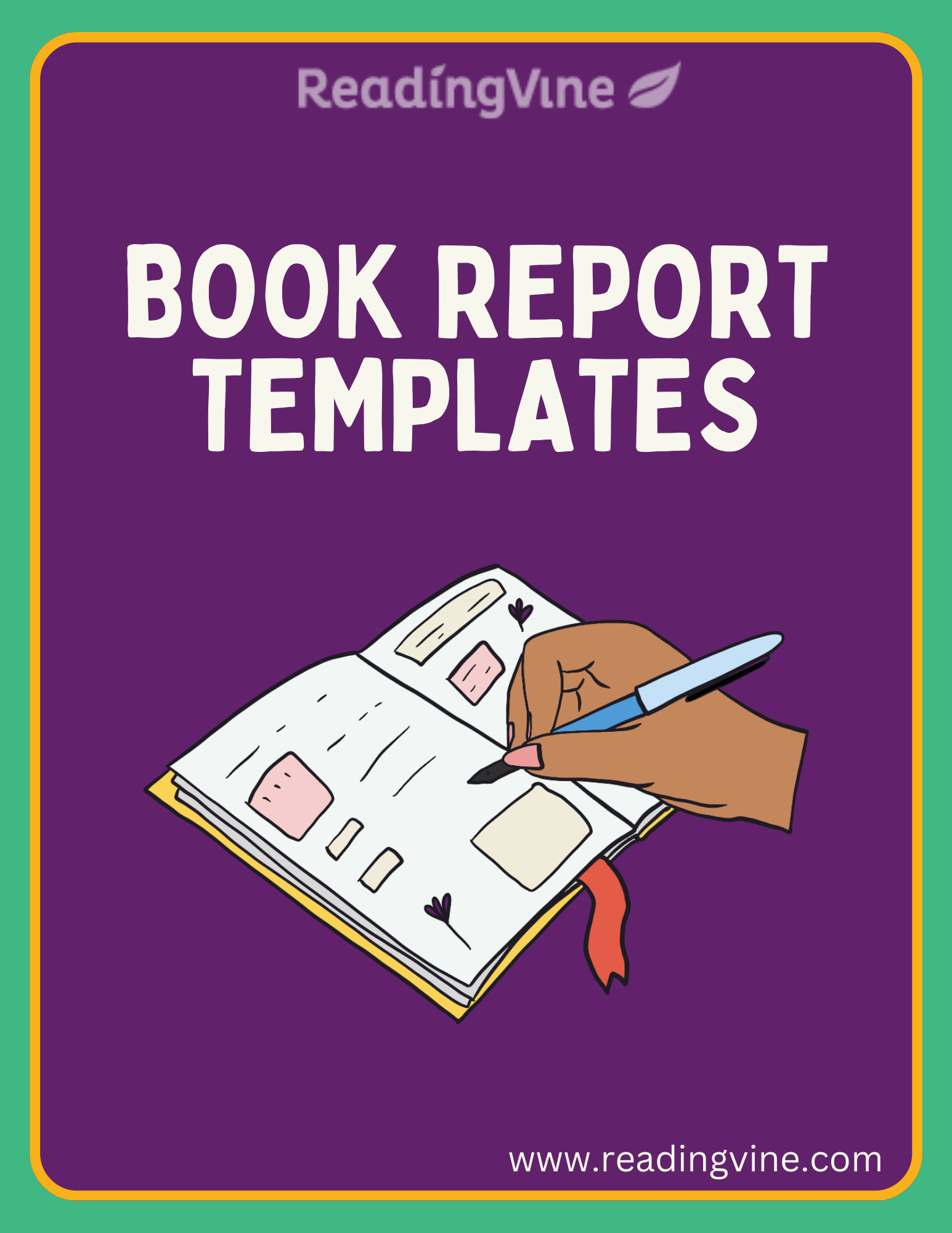
Book reports often ask students to summarize, reflect, and share their ideas. We’ve created a series of book report templates that you can use or adapt based on a variety of learning needs. While this task may reflect individual preferences and insights, it can be collaborative. Students can share in gallery walks, small groups, or large groups. Displaying book reports near your classroom library can allow you to curate a more meaningful classroom book collection and allow peers to interact in an unexpected way. Some of the earliest work with longer writing tasks is cultivated through the experience of crafting a book report. No matter how young your learners may be, fostering a love of reading and providing opportunities for children to write about what they read is critical.
Book Report Templates (Printable PDFs)
One of the most important steps of helping students understand how to craft a book report lies in their ability to choose the books they read and how they want to report on what they’ve learned. It is always useful to review book report options together in class in order to create a firm foundation that students can return to again and again. Since book reports can be a staple task in many elementary school classrooms, offering choice in how students craft and create reports will make the experience more engaging.
We’ve created a variety of printable book report templates below for different learners. For instance, we have an English language and Spanish language book report template that students can use to document character names, setting, and reflect on their favorite parts of a text! Additionally, we’ve crafted book report organizers for fiction and nonfiction texts, so you can appeal to learners who love different genres and make your curriculum more inclusive. Finally, we’ve also created a few options for those students who need more challenge. In these book reports, students extract quotes of significance, analyze them, and offer their insights on what the text teaches readers.
All of our book report templates encourage students to reflect on their interest in the text. This is critical for their reflection and ability to connect with their reading experiences.
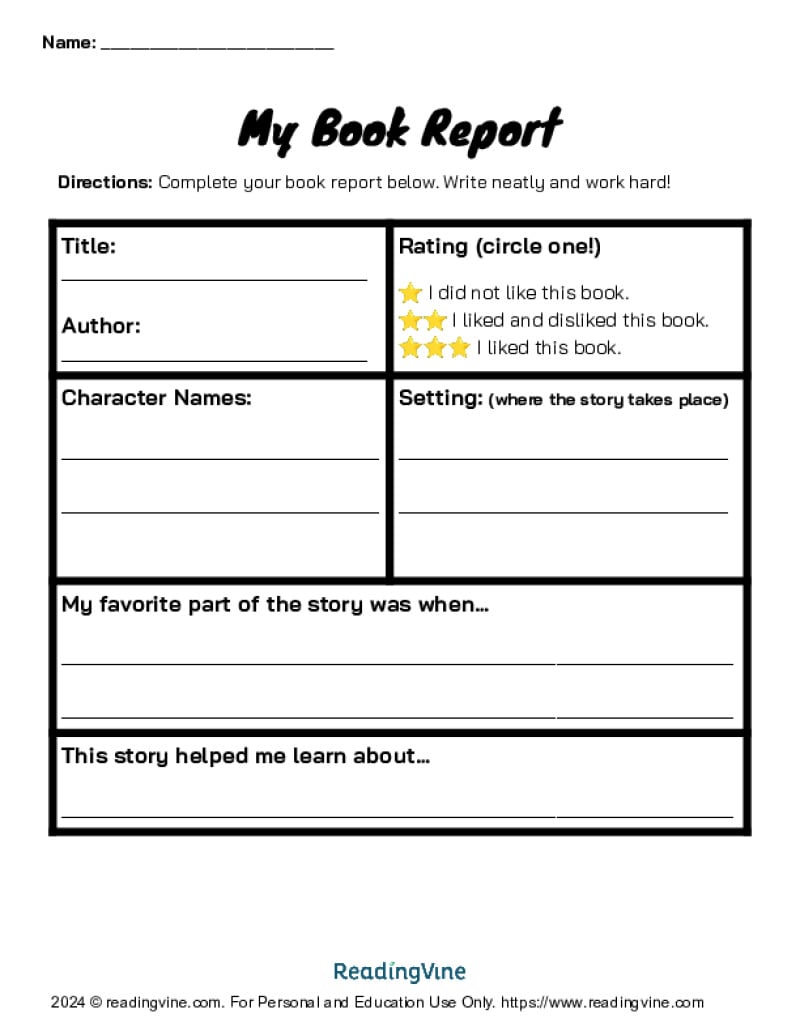
Students complete the book report by writing the title, author, Character names, setting and their favorite part of the story.
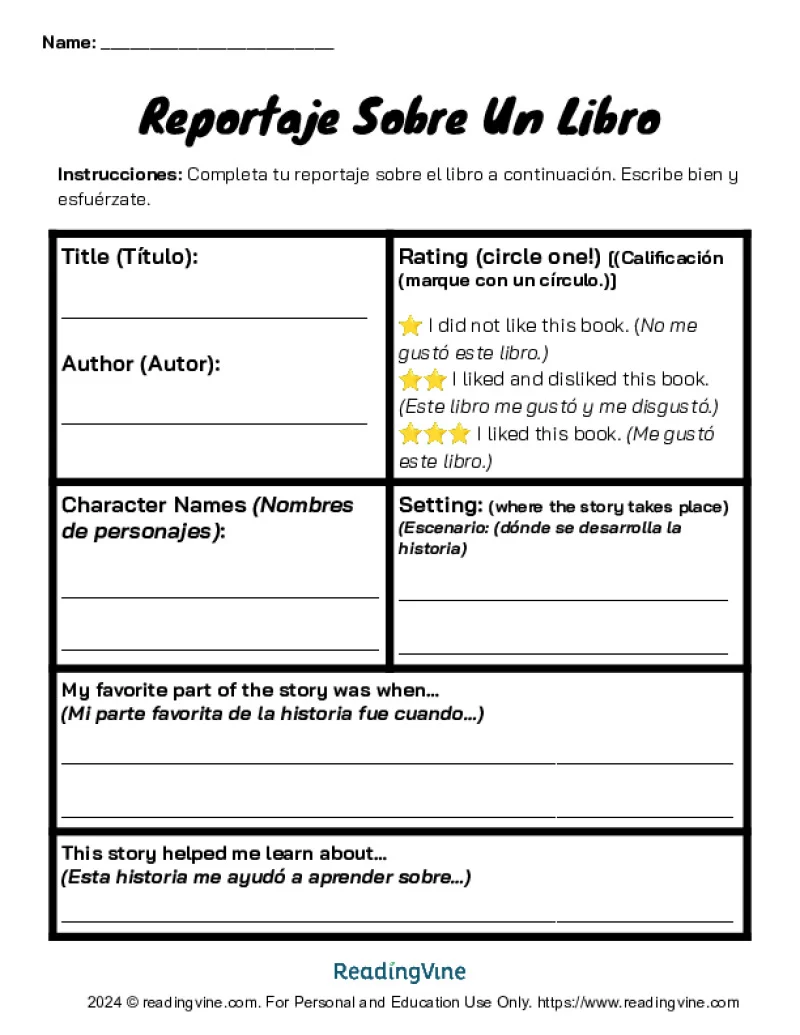
This is the same book report template but in Spanish.
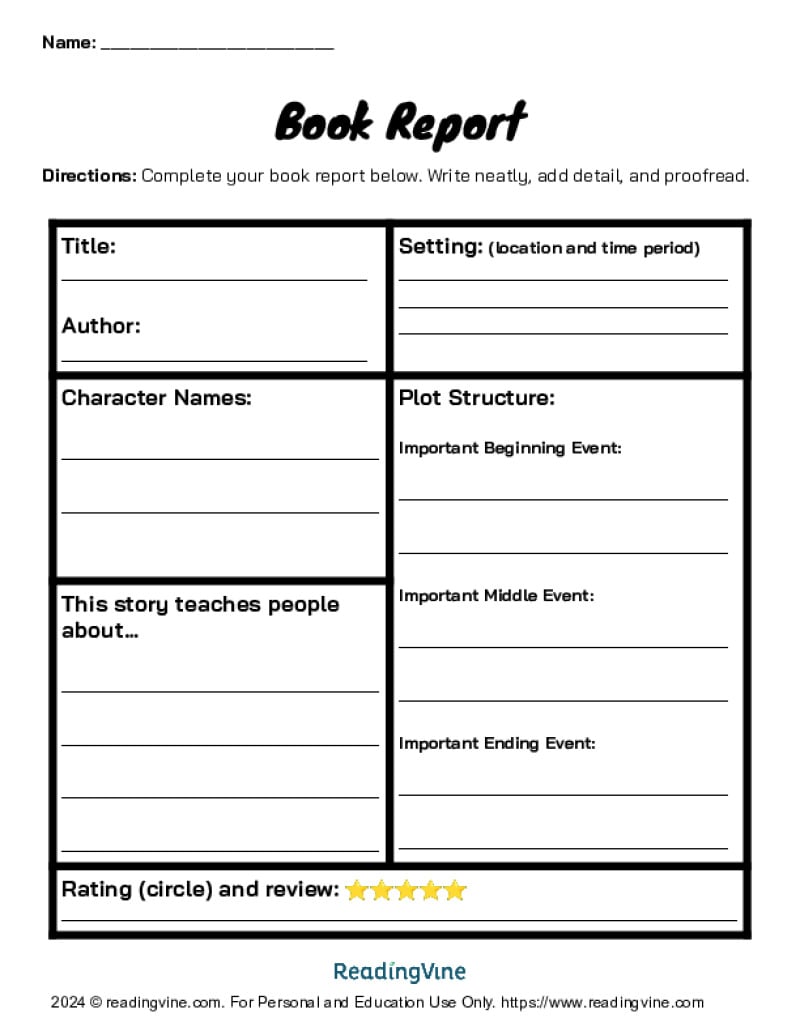
With this template, 4th - 5th grade students enter the title, author, character names but also enter the plot structure and what the story can teach people. Students also rate the book.
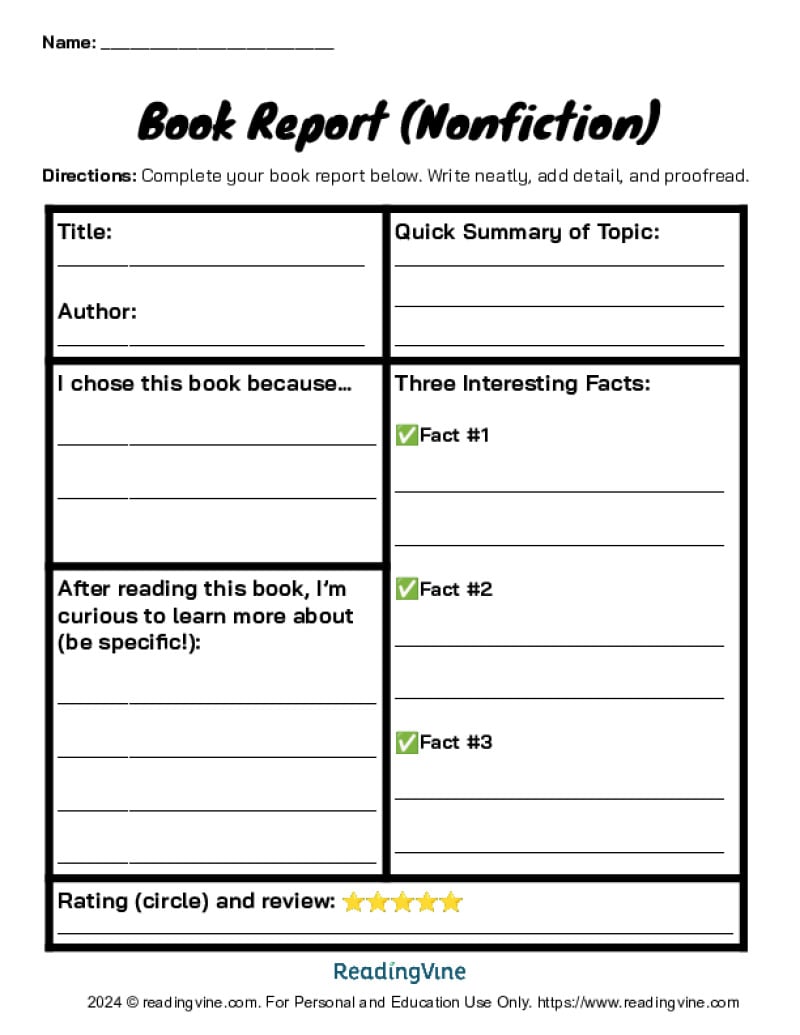
A template for nonfiction books. The student enters basic book information plus three interesting facts and what they are most curious about after reading the book.
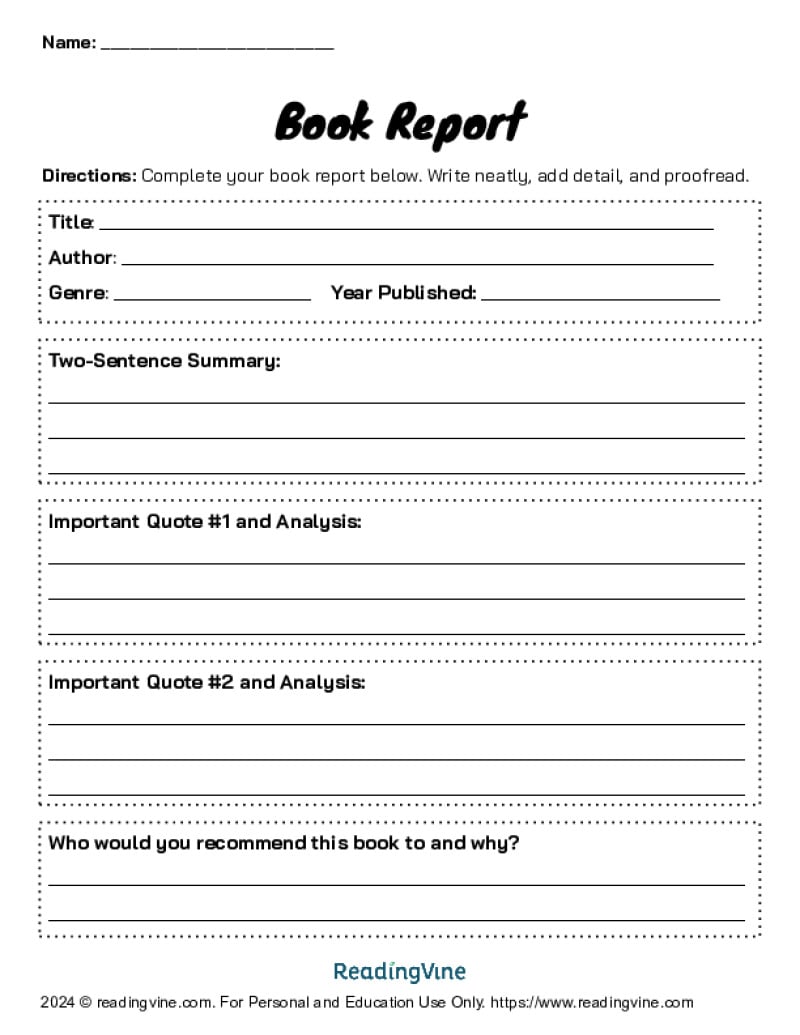
With this 6-8th grade template, students write a two-sentence summary, important quotes and whether they recommend the book and why.

Students explain, in two sentences, what the text is about, identify three important events in the text, and choose one quote they think is most important and then analyze its importance.

- Ask LitCharts AI
- Discussion Question Generator
- Essay Prompt Generator
- Quiz Question Generator

- Literature Guides
- Poetry Guides
- Shakespeare Translations
- Literary Terms
How to Write a Book Report
Use the links below to jump directly to any section of this guide:
Book Report Fundamentals
Preparing to write, an overview of the book report format, how to write the main body of a book report, how to write a conclusion to a book report, reading comprehension and book reports, book report resources for teachers .
Book reports remain a key educational assessment tool from elementary school through college. Sitting down to close read and critique texts for their content and form is a lifelong skill, one that benefits all of us well beyond our school years. With the help of this guide, you’ll develop your reading comprehension and note-taking skills. You’ll also find resources to guide you through the process of writing a book report, step-by-step, from choosing a book and reading actively to revising your work. Resources for teachers are also included, from creative assignment ideas to sample rubrics.
Book reports follow general rules for composition, yet are distinct from other types of writing assignments. Central to book reports are plot summaries, analyses of characters and themes, and concluding opinions. This format differs from an argumentative essay or critical research paper, in which impartiality and objectivity is encouraged. Differences also exist between book reports and book reviews, who do not share the same intent and audience. Here, you’ll learn the basics of what a book report is and is not.
What Is a Book Report?
"Book Report" ( ThoughtCo )
This article, written by a professor emeritus of rhetoric and English, describes the defining characteristics of book reports and offers observations on how they are composed.
"Writing a Book Report" (Purdue OWL)
Purdue’s Online Writing Lab outlines the steps in writing a book report, from keeping track of major characters as you read to providing adequate summary material.
"How to Write a Book Report" ( Your Dictionary )
This article provides another helpful guide to writing a book report, offering suggestions on taking notes and writing an outline before drafting.
"How to Write a Successful Book Report" ( ThoughtCo )
Another post from ThoughtCo., this article highlights the ten steps for book report success. It was written by an academic advisor and college enrollment counselor.
What’s the Difference Between a Book Report and an Essay?
"Differences Between a Book Report & Essay Writing" ( Classroom)
In this article from the education resource Classroom, you'll learn the differences and similarities between book reports and essay writing.
"Differences Between a Book Report and Essay Writing" (SeattlePi.com)
In this post from a Seattle newspaper's website, memoirist Christopher Cascio highlights how book report and essay writing differ.
"The Difference Between Essays and Reports" (Solent Online Learning)
This PDF from Southampton Solent University includes a chart demonstrating the differences between essays and reports. Though it is geared toward university students, it will help students of all levels understand the differing purposes of reports and analytical essays.
What’s the Difference Between a Book Report and a Book Review?
"How to Write a Book Review and a Book Report" (Concordia Univ.)
The library at Concordia University offers this helpful guide to writing book report and book reviews. It defines differences between the two, then presents components that both forms share.
"Book Reviews" (Univ. of North Carolina)
The University of North Carolina at Chapel Hill’s writing guide shows the step-by-step process of writing book reviews, offering a contrast to the composition of book reports.
Active reading and thoughtful preparation before you begin your book report are necessary components of crafting a successful piece of writing. Here, you’ll find tips and resources to help you learn how to select the right book, decide which format is best for your report, and outline your main points.
Selecting and Finding a Book
"30 Best Books for Elementary Readers" (Education.com)
This article from Education.com lists 30 engaging books for students from kindergarten through fifth grade. It was written by Esme Raji Codell, a teacher, author, and children's literature specialist.
"How to Choose a Good Book for a Report (Middle School)" (WikiHow)
This WikiHow article offers suggestions for middle schoolers on how to choose the right book for a report, from getting started early on the search process to making sure you understand the assignment's requirements.
"Best Book-Report Books for Middle Schoolers" (Common Sense Media)
Common Sense Media has compiled this list of 25 of the best books for middle school book reports. For younger students, the article suggests you check out the site's "50 Books All Kids Should Read Before They're 12."
"50 Books to Read in High School" (Lexington Public Library)
The Lexington, Kentucky Public Library has prepared this list to inspire high school students to choose the right book. It includes both classics and more modern favorites.
The Online Computer Library Center's catalogue helps you locate books in libraries near you, having itemized the collections of 72,000 libraries in 170 countries.
Formats of Book Reports
"Format for Writing a Book Report" ( Your Dictionary )
Here, Your Dictionary supplies guidelines for the basic book report format. It describes what you'll want to include in the heading, and what information to include in the introductory paragraph. Be sure to check these guidelines against your teacher's requirements.
"The Good Old Book Report" (Scholastic)
Nancy Barile’s blog post for Scholastic lists the questions students from middle through high school should address in their book reports.
How to Write an Outline
"Writer’s Web: Creating Outlines" (Univ. of Richmond)
The University of Richmond’s Writing Center shows how you can make use of micro and macro outlines to organize your argument.
"Why and How to Create a Useful Outline" (Purdue OWL)
Purdue’s Online Writing Lab demonstrates how outlines can help you organize your report, then teaches you how to create outlines.
"Creating an Outline" (EasyBib)
EasyBib, a website that generates bibliographies, offers sample outlines and tips for creating your own. The article encourages you to think about transitions and grouping your notes.
"How to Write an Outline: 4 Ways to Organize Your Thoughts" (Grammarly)
This blog post from a professional writer explains the advantages of using an outline, and presents different ways to gather your thoughts before writing.
In this section, you’ll find resources that offer an overview of how to write a book report, including first steps in preparing the introduction. A good book report's introduction hooks the reader with strong opening sentences and provides a preview of where the report is going.
"Step-by-Step Outline for a Book Report" ( Classroom )
This article from Classroom furnishes students with a guide to the stages of writing a book report, from writing the rough draft to revising.
"Your Roadmap to a Better Book Report" ( Time4Writing )
Time4Writing offers tips for outlining your book report, and describes all of the information that the introduction, body, and conclusion should include.
"How to Start a Book Report" ( ThoughtCo)
This ThoughtCo. post, another by academic advisor and college enrollment counselor Grace Fleming, demonstrates how to write a pithy introduction to your book report.
"How to Write an Introduction for a Book Report" ( Classroom )
This brief but helpful post from Classroom details what makes a good book report introduction, down to the level of individual sentences.
The body paragraphs of your book report accomplish several goals: they describe the plot, delve more deeply into the characters and themes that make the book unique, and include quotations and examples from the book. Below are some resources to help you succeed in summarizing and analyzing your chosen text.
Plot Summary and Description
"How Do You Write a Plot Summary?" ( Reference )
This short article presents the goals of writing a plot summary, and suggests a word limit. It emphasizes that you should stick to the main points and avoid including too many specific details, such as what a particular character wears.
"How to Write a Plot for a Book Report" ( The Pen & The Pad )
In this article from a resource website for writers, Patricia Harrelson outlines what information to include in a plot summary for a book report.
"How to Write a Book Summary" (WikiHow)
Using Harry Potter and the Sorcerer’s Stone as an example, this WikiHow article demonstrates how to write a plot summary one step at a time.
Analyzing Characters and Themes
"How to Write a Character Analysis Book Report" ( The Pen & The Pad )
Kristine Tucker shows how to write a book report focusing on character. You can take her suggestions as they are, or consider incorporating them into the more traditional book report format.
"How to Write a Character Analysis" (YouTube)
The SixMinuteScholar Channel utilizes analysis of the film Finding Nemo to show you how to delve deeply into character, prioritizing inference over judgment.
"How to Define Theme" ( The Editor's Blog )
Fiction editor Beth Hill contributes an extended definition of theme. She also provides examples of common themes, such as "life is fragile."
"How to Find the Theme of a Book or Short Story" ( ThoughtCo )
This blog post from ThoughtCo. clarifies the definition of theme in relation to symbolism, plot, and moral. It also offers examples of themes in literature, such as love, death, and good vs. evil.
Selecting and Integrating Quotations
"How to Choose and Use Quotations" (Santa Barbara City College)
This guide from a college writing center will help you choose which quotations to use in your book report, and how to blend quotations with your own words.
"Guidelines for Incorporating Quotes" (Ashford Univ.)
This PDF from Ashford University's Writing Center introduces the ICE method for incorporating quotations: introduce, cite, explain.
"Quote Integration" (YouTube)
This video from The Write Way YouTube channel illustrates how to integrate quotations into writing, and also explains how to cite those quotations.
"Using Literary Quotations" (Univ. of Wisconsin-Madison)
This guide from the University of Wisconsin-Madison’s Writing Center helps you emphasize your analysis of a quotation, and explains how to incorporate quotations into your text.
Conclusions to any type of paper are notoriously tricky to write. Here, you’ll learn some creative ways to tie up loose ends in your report and express your own opinion of the book you read. This open space for sharing opinions that are not grounded in critical research is an element that often distinguishes book reports from other types of writing.
"How to Write a Conclusion for a Book Report" ( Classroom )
This brief article from the education resource Classroom illustrates the essential points you should make in a book report conclusion.
"Conclusions" (Univ. of North Carolina)
The University of North Carolina at Chapel Hill’s Writing Center lays out strategies for writing effective conclusions. Though the article is geared toward analytical essay conclusions, the tips offered here will also help you write a strong book report.
"Ending the Essay: Conclusions" (Harvard College Writing Center)
Pat Bellanca’s article for Harvard University’s Writing Center presents ways to conclude essays, along with tips. Again, these are suggestions for concluding analytical essays that can also be used to tie up a book report's loose ends.
Reading closely and in an engaged manner is the strong foundation upon which all good book reports are built. The resources below will give you a picture of what active reading looks like, and offer strategies to assess and improve your reading comprehension. Further, you’ll learn how to take notes—or “annotate” your text—making it easier to find important information as you write.
How to Be an Active Reader
"Active Reading Strategies: Remember and Analyze What You Read" (Princeton Univ.)
Princeton University’s McGraw Center for Teaching and Learning recommends ten strategies for active reading, and includes sample diagrams.
"Active Reading" (Open Univ.)
The Open University offers these techniques for reading actively alongside video examples. The author emphasizes that you should read for comprehension—not simply to finish the book as quickly as possible.
"7 Active Reading Strategies for Students" ( ThoughtCo )
In this post, Grace Fleming outlines seven methods for active reading. Her suggestions include identifying unfamiliar words and finding the main idea.
"5 Active Reading Strategies for Textbook Assignments" (YouTube)
Thomas Frank’s seven-minute video demonstrates how you can retain the most important information from long and dense reading material.
Assessing Your Reading Comprehension
"Macmillan Readers Level Test" (MacMillan)
Take this online, interactive test from a publishing company to find out your reading level. You'll be asked a number of questions related to grammar and vocabulary.
"Reading Comprehension Practice Test" (ACCUPLACER)
ACCUPLACER is a placement test from The College Board. This 20-question practice test will help you see what information you retain after reading short passages.
"Reading Comprehension" ( English Maven )
The English Maven site has aggregated exercises and tests at various reading levels so you can quiz your reading comprehension skills.
How to Improve Your Reading Comprehension
"5 Tips for Improving Reading Comprehension" ( ThoughtCo )
ThoughtCo. recommends five tips to increase your reading comprehension ability, including reading with tools such as highlighters, and developing new vocabulary.
"How to Improve Reading Comprehension: 8 Expert Tips" (PrepScholar)
This blog post from PrepScholar provides ideas for improving your reading comprehension, from expanding your vocabulary to discussing texts with friends.
CrashCourse video: "Reading Assignments" (YouTube)
This CrashCourse video equips you with tools to read more effectively. It will help you determine how much material you need to read, and what strategies you can use to absorb what you read.
"Improving Reading Comprehension" ( Education Corner )
From a pre-reading survey through post-reading review, Education Corner walks you through steps to improve reading comprehension.
Methods of In-text Annotation
"The Writing Process: Annotating a Text" (Hunter College)
This article from Hunter College’s Rockowitz Writing Center outlines how to take notes on a text and provides samples of annotation.
"How To Annotate Text While Reading" (YouTube)
This video from the SchoolHabits YouTube channel presents eleven annotation techniques you can use for better reading comprehension.
"5 Ways To Annotate Your Books" ( Book Riot )
This article from the Book Riot blog highlights five efficient annotation methods that will save you time and protect your books from becoming cluttered with unnecessary markings.
"How Do You Annotate Your Books?" ( Epic Reads )
This post from Epic Reads highlights how different annotation methods work for different people, and showcases classic methods from sticky notes to keeping a reading notebook.
Students at every grade level can benefit from writing book reports, which sharpen critical reading skills. Here, we've aggregated sources to help you plan book report assignments and develop rubrics for written and oral book reports. You’ll also find alternative book report assessment ideas that move beyond the traditional formats.
Teaching Elementary School Students How to Write Book Reports
"Book Reports" ( Unique Teaching Resources )
These reading templates courtesy of Unique Teaching Resources make great visual aids for elementary school students writing their first book reports.
"Elementary Level Book Report Template" ( Teach Beside Me )
This printable book report template from a teacher-turned-homeschooler is simple, classic, and effective. It asks basic questions, such as "who are the main characters?" and "how did you feel about the main characters?"
"Book Reports" ( ABC Teach )
ABC Teach ’s resource directory includes printables for book reports on various subjects at different grade levels, such as a middle school biography book report form and a "retelling a story" elementary book report template.
"Reading Worksheets" ( Busy Teacher's Cafe )
This page from Busy Teachers’ Cafe contains book report templates alongside reading comprehension and other language arts worksheets.
Teaching Middle School and High School Students How to Write Book Reports
"How to Write a Book Report: Middle and High School Level" ( Fact Monster)
Fact Monster ’s Homework Center discusses each section of a book report, and explains how to evaluate and analyze books based on genre for students in middle and high school.
"Middle School Outline Template for Book Report" (Trinity Catholic School)
This PDF outline template breaks the book report down into manageable sections for seventh and eighth graders by asking for specific information in each paragraph.
"Forms for Writing a Book Report for High School" ( Classroom )
In this article for Classroom, Elizabeth Thomas describes what content high schoolers should focus on when writing their book reports.
"Forms for Writing a Book Report for High School" ( The Pen & The Pad )
Kori Morgan outlines techniques for adapting the book report assignment to the high school level in this post for The Pen & The Pad .
"High School Book Lists and Report Guidelines" (Highland Hall Waldorf School)
These sample report formats, grading paradigms, and tips are collected by Highland Hall Waldorf School. Attached are book lists by high school grade level.
Sample Rubrics
"Book Review Rubric Editable" (Teachers Pay Teachers)
This free resource from Teachers Pay Teachers allows you to edit your book report rubric to the specifications of your assignment and the grade level you teach.
"Book Review Rubric" (Winton Woods)
This PDF rubric from a city school district includes directions to take the assignment long-term, with follow-up exercises through school quarters.
"Multimedia Book Report Rubric" ( Midlink Magazine )
Perfect for oral book reports, this PDF rubric from North Carolina State University's Midlink Magazine will help you evaluate your students’ spoken presentations.
Creative Book Report Assignments
"25 Book Report Alternatives" (Scholastic)
This article from the Scholastic website lists creative alternatives to the standard book report for pre-kindergarteners through high schoolers.
"Fresh Ideas for Creative Book Reports" ( Education World )
Education World offers nearly 50 alternative book report ideas in this article, from a book report sandwich to a character trait diagram.
"A Dozen Ways to Make Amazingly Creative Book Reports" ( We Are Teachers )
This post from We Are Teachers puts the spotlight on integrating visual arts into literary study through multimedia book report ideas.
"More Ideas Than You’ll Ever Use for Book Reports" (Teachnet.com)
This list from Teachnet.com includes over 300 ideas for book report assignments, from "interviewing" a character to preparing a travel brochure to the location in which the book is set.
"Fifty Alternatives to the Book Report" (National Council of Teachers of English)
In this PDF resource from the NCTE's English Journal, Diana Mitchell offers assignment ideas ranging from character astrology signs to a character alphabet.
- PDFs for all 136 Lit Terms we cover
- Downloads of 1985 LitCharts Lit Guides
- Teacher Editions for every Lit Guide
- Explanations and citation info for 41,909 quotes across 1985 books
- Downloadable (PDF) line-by-line translations of every Shakespeare play
Need something? Request a new guide .
How can we improve? Share feedback .
LitCharts is hiring!

- Quizzes, saving guides, requests, plus so much more.

Book reports may be a staple of elementary and middle school education, but they are far less frequently assigned in the higher grades. High school ELA teacher Nancy Barile thinks that should change. Students in 6th grade and above can learn a lot when they are challenged to use higher order thinking skills to understand and interpret the literature they read via a good old-fashioned high school book report template.
To start, Barile recommends that students choose the books they want to write about themselves—with teacher approval, of course. See the book list at the end of this article for engaging young adult titles and book report ideas, including books with thematic elements that are particularly appealing to older readers.
Writing the Report
To structure the book reports, Barile recommends eight sections of analysis that will “require students to provide evidence of their choices and reasoning, which helps them think more deeply about what they have read.” For each section, students should give examples from the book to back up their analysis. The below book report template can help.
If your students need to review the elements of fiction before beginning this assignment, Teaching Powerful Writing is a great resource. This collection of personal narratives and writing activities highlights different writing techniques and covers literary elements such as voice, using flashback, and point of view.
Book Report Breakdown
Students should identify the setting of the novel and explain why the setting is important.
- How are the time and place significant to the events of the story?
- How does the setting contribute to the overall meaning of the novel?
2. CHARACTERIZATION
Beginning with the protagonist and then moving on to the supporting characters, students should discuss the characterizations in their novel.
- Is the character well-developed, or are they a stock or stereotypical character?
- Is the character static (unchanging throughout the story) or dynamic (changes by the end of the novel)?
- What personality traits does the character possess, and how does this affect the outcome of the novel?
- Do the character's inner thoughts and feelings reflect their outward actions? Explain.
3. POINT OF VIEW
Students should identify the novel’s point of view and why it is significant.
- What advantages does telling the story in (first person/second person/third person) have? Why?
- Why do you think the author chose this point of view?
4. CONFLICT
What is the primary conflict in the novel? Is it human vs. human, human vs. nature, human vs. society, or human vs. themselves? Your students should delve into conflict much more deeply than they may have in the past. If their story has more than one major conflict, they should detail the additional conflicts as well.
- Explain the conflict and how the protagonist deals with it.
- Does the protagonist overcome the conflict? Or do they succumb to it?
Students should identify the theme of the novel and the specific meaning of the book they chose. They should avoid stock themes such as “Don’t judge a book by its cover” and think more critically on their author’s message.
- What was the author’s purpose in writing the book?
What are the symbols in the novel and how are they significant?
- How do the symbols help develop the story and contribute to the overall meaning of the book?
7. FORESHADOWING
Students should identify the foreshadowing in their novel and give examples from the text.
- Did you know what was going to come? Why?
- Were there any hints as to what might occur?
- Why do you think the author chose to use or not use foreshadowing?
Finally, students should evaluate the ending of the book.
- Was the ending justified? (Was the ending viable and believable?)
- Was it a satisfactory ending that fit the rest of the novel?
- Was there a catharsis of some kind? Explain.
If your students follow this structure in their book report, it will help them explore each of the elements of fiction in a very specific way. As Barile discovered in her decades of teaching: “Students who explain, interpret, and synthesize what they have read gain a deeper understanding and appreciation of literature.”
Shop great classroom titles for book reports below! You can find all books and activities at The Teacher Store .
Additional Resources
- A List of Writing Contests in 2022 | Exciting Prizes!
- Em Dash vs. En Dash vs. Hyphen: When to Use Which
- Book Proofreading 101: The Beginner’s Guide
- Screenplay Editing: Importance, Cost, & Self-Editing Tips
- Screenplay Proofreading: Importance, Process, & Cost
- Script Proofreading: Rates, Process, & Proofreading Tips
- Manuscript Proofreading | Definition, Process & Standard Rates
- 14 Punctuation Marks: Examples & Free Guide on How to Use
- Tips to Write Better if English Is Your Second Language
- Novel Proofreading | Definition, Significance & Standard Rates
- The Top 10 Literary Devices: Definitions & Examples
- Top 101 Bone-Chilling Horror Writing Prompts
- Top 10 Must-Try Writing Prompt Generators in 2024
- 100+ Creative Writing Prompts for Masterful Storytelling
- Best 101 Greatest Fictional Characters of All Time
- Top 10 eBook Creator Tools in 2024: Free & Paid
- 50 Timeless and Unforgettable Book Covers of All Time
- What Is Flash Fiction? Definition, Examples & Types
- Discover the Best Book Review Sites of 2024: Top 10 Picks
- 80 Enchanting Christmas Writing Prompts for Your Next Story
Your Guide to the Best eBook Readers in 2024
- Top 10 Book Review Clubs of 2024 to Share Literary Insights
- 2024’s Top 10 Self-Help Books for Better Living
- Writing Contests 2023: Cash Prizes, Free Entries, & More!
- Top 10 Book Writing Apps of 2024: Free & Paid!
- Top 10 Book Marketing Services of 2024: Features and Costs
- 10 Best Book Publishing Companies in 2024
- What Is a Book Teaser and How to Write It: Tips and Examples
- Audiobook vs. EBook vs. Paperback in 2024: (Pros & Cons)
- Top 10 Book Writing Software, Websites, and Tools in 2024
- How to Get a Literary Agent in 2024: The Complete Guide
- An Easy Guide to the Best Fonts & Font Sizes for Your Book
- Top 10 Book Promotion Services for 2024’s Authors
- Alpha Readers: Where to Find Them and Alpha vs. Beta Readers
- Author Branding 101: How to Build a Powerful Author Brand
How to Write a Book Report | Steps, Examples & Free Template
- A Guide on How to Write a Book Synopsis: Steps and Examples
- How to Write a Book Review (Meaning, Tips & Examples)
- Book Title Generators: Top 10 Book Name Generators of 2024
- 50 Top Literary Agents in the USA for Authors in 2024
- Building an Author Website: The Ultimate Guide with Examples
- Top 10 Book Printing Services for Authors in 2024
- 10 Best Free Online Grammar Checkers: Features and Ratings
- How to Write a Poem: Step-by-Step Guide to Writing Poetry
- What Is a Poem? Poetry Definition, Elements, & Examples
- 2024’s 10 Best Paraphrasing Tools for All (Free & Paid)
- Top 10 AI Detector Tools in 2024 (Free & Paid)
- Top 10 Book Editing Software in 2024 (Free & Paid)
- What Is an Adverb? Definition, Types, Differences & Examples
- What Are Large Language Models and How They Work: Explained!
- What Is an Adjective? Definition, Usage & Examples
- Top 10 Hardcover Book Printing Services [2024 Update]
- 15 Types of Poems Everyone Should Know About
- 2024’s Top 10 Setting Generators to Create Unique Settings
- Different Types of Characters in Stories That Steal the Show
- Top 10 Screenplay & Scriptwriting Software (Free & Paid)
- 10 Best AI Text Generators of 2024: Pros, Cons, and Prices
- Top 10 Must-Try Character Name Generators in 2024
- How to Track Changes in Google Docs: A 7-Step Guide
- 10 Best AI Text Summarizers in 2024 (Free & Paid)
- 2024’s 10 Best Punctuation Checkers for Error-Free Text
- Top 10 AI Humanizers of 2024 [Free & Paid Tools]
- Top 10 AI Rewriters for Perfect Text in 2024 (Free & Paid)
- 10 Best Plot Generators for Powerful Storytelling in 2024
- 11 Best Story Structures for Writers (+ Examples!)
- Writing Contests 2024: Cash Prizes & Free Entries!
Pre-Publishing Steps
- Book Cover Design: An Introduction
- What is a Book Copyright Page?
- 8 Pre-Publishing Steps to Self-Publish Your Book
- 7 Essential Elements of a Book Cover Design
- How to Copyright Your Book in the US, UK, & India
- How to Format a Book in 2024: 7 Tips for Print & EBooks
- Beta Readers: Why You Should Know About Them in 2024
- How to Publish a Book in 2024: A Beginners’ Guide
- ISBN Guide 2024: What Is an ISBN and How to Get an ISBN
Self Publishing Guide
- How to Hire a Book Editor in 5 Practical Steps
- Self-Publishing Options for Writers
- How to Promote Your Book Using a Goodreads Author Page
- What Makes Typesetting a Pre-Publishing Essential for Every Author?
- 4 Online Publishing Platforms To Boost Your Readership
- How to Find the Perfect Book Editor for Your Manuscript
- Typesetting: An Introduction
- Quick Guide to Novel Editing (with a Self-Editing Checklist)
- Quick Guide to Book Editing [Complete Process & Standard Rates]
- 10 Best Self-Publishing Companies of 2024: Price & Royalties
- What Is Amazon Self-Publishing? Pros, Cons & Key Insights
- Manuscript Editing in 2024: Elevating Your Writing for Success
- Self-Publishing vs. Traditional Publishing: 2024 Guide
- How to Publish a Book on Amazon: 8 Easy Steps [2024 Update]
- 10 Best Book Cover Design Services of 2024: Price & Ratings
- A Beginner’s Guide to Self-Publishing a Book in 2024
- Learn How Much Does It Cost to Self-Publish a Book in 2024
- What are Print-on-Demand Books? Cost and Process in 2024
- What Are the Standard Book Sizes for Publishing Your Book?
- Top 10 EBook Conversion Services for 2024’s Authors
- How to Copyright a Book in 2024 (Costs + Free Template)
- How to Market Your Book on Amazon to Maximize Sales in 2024
Traditional Publishing
- How to start your own online publishing company?
- 8 Tips To Write Appealing Query Letters
- How to Write a Query Letter (Examples + Free Template)
Writing Tips
- How to Create Depth in Characters
- Starting Your Book With a Bang: Ways to Catch Readers’ Attention
- How to Write a Powerful Plot in 12 Steps
- Research for Fiction Writers: A Complete Guide
- Short stories: Do’s and don’ts
- How to Write Dialogue: 7 Rules, 5 Tips & 65 Examples
- How to Write a Novel in Past Tense? 3 Steps & Examples
- What Are Foil and Stock Characters? Easy Examples from Harry Potter
- How To Write Better Letters In Your Novel
- On Being Tense About Tense: What Verb Tense To Write Your Novel In
- How To Create A Stellar Plot Outline
- How to Punctuate Dialogue in Fiction
- On Being Tense about Tense: Present Tense Narratives in Novels
- The Essential Guide to Worldbuilding [from Book Editors]
- What Is Point of View: 1st, 2nd & 3rd POV with Examples
- How to Create Powerful Conflict in Your Story | Useful Examples
- How to Write a Book: A Step-by-Step Guide
- How to Write a Short Story: 6 Steps & Examples
- How To Craft a Murder Mystery Story
- How to Write a Novel: 8 Steps to Help You Start Writing
- What Is a Stock Character? 150 Examples from 5 Genres
- How to Write a Children’s Book: An Easy Step-by-Step Guide
- Joseph Campbell’s Hero’s Journey: Worksheet & Examples
- Novel Outline: A Proven Blueprint [+ Free Template!]
- Character Development: 7-Step Guide for Writers
- Foil Character: Definition, History, & Examples
- What Is NaNoWriMo? Top 7 Tips to Ace the Writing Marathon
- What Is the Setting of a Story? Meaning + 7 Expert Tips
- Theme of a Story | Meaning, Common Themes & Examples
- 5 Elements of a Short Story & 6 Stages of a Plot
- What Is a Blurb? Meaning, Examples & 10 Expert Tips
- What Is Show, Don’t Tell? (Meaning, Examples & 6 Tips)
- How to Write a Book Summary: Example, Tips, & Bonus Section
- How to Write a Book Description (Examples + Free Template)
- 10 Best Free AI Resume Builders to Create the Perfect CV
- A Complete Guide on How to Use ChatGPT to Write a Resume
- 10 Best AI Writer Tools Every Writer Should Know About
- 15 Best ATS-Friendly ChatGPT Prompts for Resumes in 2024
- How to Write a Book Title (15 Expert Tips + Examples)
- The 10 Best AI Story Generators: Features, Usage & Benefits
- 100 Novel and Book Ideas to Start Your Book Writing Journey
- Exploring Writing Styles: Meaning, Types, and Examples
- Mastering Professional Email Writing: Steps, Tips & Examples
- How to Write a Screenplay: Expert Tips, Steps, and Examples
- Business Proposal Guide: How to Write, Examples and Template
- Different Types of Resumes: Explained with Tips and Examples
- How to Create a Memorable Protagonist (7 Expert Tips)
- How to Write an Antagonist (Examples & 7 Expert Tips)
Writing for the Web: 7 Expert Tips for Web Content Writing
- What are the Parts of a Sentence? An Easy-to-Learn Guide
- How to Avoid AI Detection in 2024 (6 Proven Techniques!)
- How to Avoid Plagiarism in 2024 (10 Effective Strategies!)
- 10 Best Spell Checkers of 2024: Features, Accuracy & Ranking
- What Is Climax Of A Story & How To Craft A Gripping Climax
- What Is a Subject of a Sentence? Meaning, Examples & Types
- Object of a Sentence: Your Comprehensive Guide
- First-person Point of View: What Is It and Examples
- Second-person Point of View: What Is It and Examples
Still have questions? Leave a comment
Add Comment
Checklist: Dissertation Proposal
Enter your email id to get the downloadable right in your inbox!
Examples: Edited Papers
Need editing and proofreading services.

- Tags: Academic Writing , English as a Second Language / ESL , Writing Tips
Have a book report submission deadline and want to know how to write one? We’re here to help! Book reports are vital in academics, helping students sharpen their understanding and critical thinking, while for authors, they offer a deep dive into a text’s composition and stylistic elements.
In this article, we will understand how to write a good book report. It’s a skill that not only helps you get more out of what you’re reading but also lets you create a report that truly reflects how good the book is. Let’s get started!
Ace your assignment with a perfect book report! Learn more
Firstly, let us understand what is a book report.
What is a book report?
A book report is an in-depth analysis, an objective summary of a book’s main content and arguments. Book reports discuss a book’s content, structure, and themes. Far from just a recap of the plot outline , a book report examines the details of a book’s narrative, offering insights into the characters, themes of the story , and the author’s writing style.
Note: A book report is usually assigned to students from secondary schools to colleges. As per book report format, book reports are typically 500–1000 words long.
Elements of a book report
A proper book report outline consists of the following elements:
- Introduction: Think about how to start a book report with an engaging opening. Mention the book’s title, author, genre, and a brief plot summary. State your main theme or viewpoint.
- Content summary: Give a clear, summary of the plot. Highlight key events and turning points. Avoid spoilers.
- Analysis and perspective: Examine the key characters, their traits, motivations, development, and plot roles. Explore major themes, symbols, and motifs, and their narrative effect. Review the author’s style and perspective, and their impact on the story.
- Conclusion: Summarize your main points. Restate your overall impression of the book and possibly suggest who might enjoy it or what kind of readers would benefit from it.
- Citations and references (if necessary): If you have used external sources or have been influenced by other analyses, make sure to cite these references properly to avoid plagiarism.
By following this book report outline, your book report will be comprehensive, informative, and engaging.
How to write a book report
Before learning how to do a book report, it is important to remember that following a book report format is essential.
Here’s how to write a book report:
- Read the book carefully: Start by reading the book thoroughly. Take notes on key points, characters, themes, and any passages that stand out.
- Create an Outline: Organize your thoughts and notes into an outline. This will be your roadmap and will help keep your writing focused.
- Write the introduction: Begin with an engaging introduction that provides basic information about the book, including the title, author, and a brief synopsis.
- Develop the body: You can follow your outline or a book report template to write the body of your report. Discuss each element (plot, characters, themes, etc.) in separate paragraphs or sections.
- Conclude your report: Summarize your main points and offer your final thoughts and evaluation of the book.
- Review and revise: Finally, review and proofread your report for clarity, coherence, and correctness. Make sure to correct any grammatical mistakes and ensure your report flows logically.
Taking a look at a few examples of book reports will help you understand how to do a book report easily. So let’s explore some book report examples next.
Book report examples
Starting with book report examples, let’s look at a book report example on The Diary of a Young Girl by Anne Frank.
Introduction: Diary of a Young Girl by Anne Frank is a powerful and poignant diary that gives an intimate glimpse into the life of a Jewish teenager during the Holocaust.
Summary: The diary chronicles Anne Frank’s life from 1942 to 1944, during which she and her family hid from the Nazis in Amsterdam. The entries detail her daily life in the secret annex, her thoughts, fears, and hopes for a better future.
Analysis and themes: Anne’s diary is a testament to the resilience of the human spirit in the face of unimaginable adversity. Themes of hope, the cruelty of war, the innocence of youth, and the power of writing shine through her words.
Conclusion: Diary of a Young Girl is more than just a diary; it’s a moving narrative that brings to light the horrors of war and the timeless strength of hope and human dignity. Anne Frank’s voice continues to resonate with readers around the world, making this book a must-read for understanding history and humanity.
Now let’s look at a fiction book report example on Percy Jackson and the Lightning Thief by Rick Riordan.
Introduction: Percy Jackson and the Lightning Thief by Rick Riordan is a thrilling fantasy novel that introduces us to a world where Greek gods and mythology come to life in the modern era.
Summary: The story follows Percy Jackson, a young boy who discovers he is the son of Poseidon, the Greek god of the sea. After being accused of stealing Zeus’s lightning bolt, Percy embarks on a dangerous adventure across America to find the real thief and prevent a war among the gods.
Analysis and themes: Riordan’s novel is rich in Greek mythology and cleverly intertwined with modern-day settings and issues. Themes of identity, friendship, and bravery are prominent as Percy navigates the challenges of being a demigod. The book also explores the concept of good vs. evil and the importance of understanding one’s strengths and weaknesses.
Conclusion: Percy Jackson and the Lightning Thief is an engaging and imaginative novel that offers a fresh perspective on Greek mythology. It’s a captivating read for young adults, effectively combining action, humor, and life lessons, making it a standout in the genre of fantasy fiction.
Book report template
You can easily write a book report using our free book report template.
It’s clear that writing a book report is more than a mere academic exercise; it’s an opportunity to delve deeper into the world of literature and gain insights.
By using the provided template and examples as starting points, you’re well on your way to writing insightful and compelling book reports. Also, to make your book report perfect, we are always here to help you with our expert editing and proofreading services !
For more useful tips and resources, keep reading:
- Top 10 Best Print-on-Demand Book Companies in 2024
- Proven Book Marketing Techniques to Increase Sales in 2024
- 10 Best Book Cover Design Services of 2024: Price & Ratings
- Top 10 Online Book Editing Services of 2024
Found this article helpful?
Leave a Comment: Cancel reply
Your email address will not be published.
Your vs. You’re: When to Use Your and You’re
Your organization needs a technical editor: here’s why.
Subscribe to our Newsletter
Get carefully curated resources about writing, editing, and publishing in the comfort of your inbox.
How to Copyright Your Book?
If you’ve thought about copyrighting your book, you’re on the right path.
© 2024 All rights reserved
- Terms of service
- Privacy policy
- Partner with us
- Annual report
- Website content
- Marketing material
- Job Applicant
- Cover letter
- Resource Center
- Case studies
- PRO Courses Guides New Tech Help Pro Expert Videos About wikiHow Pro Upgrade Sign In
- EDIT Edit this Article
- EXPLORE Tech Help Pro About Us Random Article Quizzes Request a New Article Community Dashboard This Or That Game Happiness Hub Popular Categories Arts and Entertainment Artwork Books Movies Computers and Electronics Computers Phone Skills Technology Hacks Health Men's Health Mental Health Women's Health Relationships Dating Love Relationship Issues Hobbies and Crafts Crafts Drawing Games Education & Communication Communication Skills Personal Development Studying Personal Care and Style Fashion Hair Care Personal Hygiene Youth Personal Care School Stuff Dating All Categories Arts and Entertainment Finance and Business Home and Garden Relationship Quizzes Cars & Other Vehicles Food and Entertaining Personal Care and Style Sports and Fitness Computers and Electronics Health Pets and Animals Travel Education & Communication Hobbies and Crafts Philosophy and Religion Work World Family Life Holidays and Traditions Relationships Youth
- Browse Articles
- Learn Something New
- Quizzes Hot
- Happiness Hub
- This Or That Game
- Train Your Brain
- Explore More
- Support wikiHow
- About wikiHow
- Log in / Sign up
- Arts and Entertainment
A Beginner's Guide to Writing a Book Report (with Examples)
Last Updated: June 25, 2024 Fact Checked
- Researching
- Drafting the Report
- Reviewing & Revising
Sample Book Reports & Summaries
Expert q&a.
This article was co-authored by Jake Adams and by wikiHow staff writer, Raven Minyard, BA . Jake Adams is an academic tutor and the owner of Simplifi EDU, a Santa Monica, California based online tutoring business offering learning resources and online tutors for academic subjects K-College, SAT & ACT prep, and college admissions applications. With over 14 years of professional tutoring experience, Jake is dedicated to providing his clients the very best online tutoring experience and access to a network of excellent undergraduate and graduate-level tutors from top colleges all over the nation. Jake holds a BS in International Business and Marketing from Pepperdine University. There are 8 references cited in this article, which can be found at the bottom of the page. This article has been fact-checked, ensuring the accuracy of any cited facts and confirming the authority of its sources. This article has been viewed 1,423,506 times.
A book report is a short essay that summarizes and analyzes a work of fiction or nonfiction. Writing a book report may not seem fun at first, but it gives you a great chance to fully understand a work and its author. In this article, we’ll teach you everything you need to know about how to write a book report, from choosing a book and outlining to drafting and editing your final paper.
Things You Should Know
- Read the entire book and take notes on important themes, characters, and events. Use your notes to create an outline with evidence that supports your analysis.
- Include the title and author in your intro, then summarize the plot, main characters, and setting of the book.
- Analyze the author’s writing style, as well as the main themes and arguments of the book. Include quotes and examples to support your statements.
Researching Your Book Report

- For example, find out if your teacher wants you to include citations, such as page numbers from the book, in your report.
- Ask your teacher how much of your paper to devote to summary versus analysis. Most book reports are direct summaries with objective analysis rather than your personal opinions. In contrast, a book review or commentary is more opinion-driven.
- Some popular books for book reports include To Kill a Mockingbird by Harper Lee, Animal Farm by George Orwell, and The Hunger Games by Suzanne Collins. Choose a book at your grade level.

- Author: Who wrote the book? Do you know any other works by this author?
- Genre: Is the book fiction or nonfiction? If it’s fiction, is it historical, fantasy, horror, etc.? If it’s nonfiction, is it a biography, memoir, science, etc.?
- Audience: Who would find this book appealing? Is it intended for a specific age range or gender? Do you typically enjoy books like this?
- Title: Does the title catch your interest? Does it fit well with the book’s content?
- Book Cover/Illustrations: What does the book cover convey and does it accurately represent the book? How do you feel when you look at it? If the book has illustrations, what are they and do they hold your interest?

- Take breaks while reading to keep your attention sharp. Try to find a pace that is comfortable for you. If you get distracted after 15 minutes, read in 15-minute intervals. If you can go an hour, read for an hour at a time.
- Give yourself enough time to read the entire book. It’s very difficult to write a book report if you’ve just skimmed over everything. Don’t procrastinate!
- Don’t trust online book summaries. You can’t guarantee that they are accurate or true to the text.

- For example, look for a sentence that clearly describes a main setting in the book, such as “The castle was gloomy and made out of large black stones.”
Outlining Your Book Report

- Introduction: Introduce the title, author, and publication information. Include a brief overview of the book’s genre and main theme, and state your purpose for writing the report.
- Summary: Concisely summarize the plot or central idea, highlighting main events, characters, and conflicts. Focus on important aspects while avoiding spoilers.
- Analysis and Evaluation: Evaluate the author’s writing style and use of literary devices, like foreshadowing, metaphors, imagery, etc. Discuss the strengths and weaknesses of the book and use quotes and examples from the text.
- Themes and Messages: Identify the book’s main themes or messages and how they develop through the course of the book. Provide specific quotes and examples.
- Character Analysis: Analyze the main characters in the book, their development, and their relationships. Explain their motivations, personalities, and significance to the story. Provide examples and quotes to support your analysis.
- Personal Reflection: Depending on your teacher’s instructions, you might share your personal opinions and discuss what you liked and disliked about the book. Reflect on how the book relates to broader themes or issues.
- Conclusion: Summarize your main points and conclude with your final thoughts or reflections on the book.
- Bibliography: If required, include a works cited page or bibliography listing all the sources you used to write your book report.
- Outlining takes time, but it saves you more time once you reach the editing stage.
- Some people prefer to outline with pen and paper, while others just type up a list on the computer. Choose the method that works best for you.

- Be careful not to overuse quotes. If it seems like every other line is a quote, try to dial back. Aim to include a maximum of one quotation per paragraph. Quotes and examples should still take a backseat to your summary.

- For example, you’ll likely need to focus primarily on discussing the most important characters or the characters that appear most frequently in the text.
- When you are finished with your outline, go back through it to see if it makes sense. If the paragraphs don’t flow into one another, move them around or add/delete new ones until they do.
- Also, check to see if your outline covers all of the major elements of the book, such as the plot, characters, and setting.
Writing Your Book Report

- For example, a sentence summary might state, “This book is about the main character’s journey to Africa and what she learns on her travels.”
- Don’t take up too much space with your introduction. In general, an introduction should be 3-6 sentences long, though in rare cases, they may be longer or shorter.

- Use vivid language when you can and include plenty of details. For example, you might write, “The farm was surrounded by rolling hills.”

- For instance, if the main character moves to Africa, you might describe what happens before the move, how the move goes, and how they settle in once they arrive.

- For example, you might write that the main character is “a middle-aged woman who enjoys the finer things in life, such as designer clothes.” Then, connect this description to the plot summary by describing how her views change after her travels, if they do.
- Expect to introduce the characters in the same sentences and paragraphs as the plot introduction.

- You might write, “The author argues that travel gives you a new perspective. That is why her main characters all seem happier and more grounded after visiting new places.”
- For fiction, determine if the author is using the story to pass along a certain moral or lesson. For example, a book about an underdog athlete could encourage readers to take chances to pursue their dreams.

- For example, an author who uses lots of slang terms is probably going for a hip, approachable style.

- Some teachers require, or strongly suggest, that you include the author’s name and the book title in your concluding paragraph.
- When writing a conclusion , don’t introduce any new thoughts. Any important points should be made in your body paragraphs. Save the space for your recap.

Reviewing and Revising Your Book Report

- Before you submit your paper, make sure that you’ve spelled the author’s name and any character names correctly.
- Don’t trust your computer’s spell check to catch all the errors for you. Spell check can be helpful, but it isn’t perfect and can make mistakes.

- If you’re nervous about asking, try saying something like “It would be great if you could go over my book report and make sure that it reads smoothly.”
- Remember, no one’s first draft is perfect, so don’t get upset if someone suggests you do something differently. They want to help make your report the best it can be, so don’t take constructive criticism personally.

- For example, double-check that you are using the correct font, font size, and margins.
- Once you've finished proofreading, revising, and checking that you've addressed all the requirements, you're ready to submit your book report!

- Even though your book report is your own work, avoid using “I” too much. It can make your writing feel choppy. Thanks Helpful 0 Not Helpful 0
- It might be tempting to watch the movie or read the online notes instead of reading the book. Resist this urge! Your teacher will be able to tell the difference. Thanks Helpful 0 Not Helpful 0
Tips from our Readers
- Calm down and walk around if you get too frustrated while writing. If you write a book report while angry, you're more likely to misspell things!
- Choose a unique book. Harry Potter or Percy Jackson is an absolute no. Everyone chooses those. Try something different!
- Write when anything comes to mind! You don't want to lose your ideas!

- Give yourself plenty of time to write your report. Don’t wait until the last minute or you may feel rushed. Thanks Helpful 2 Not Helpful 0
- Stealing or using another person’s work is considered plagiarism and academic dishonesty. Make sure that the work you submit is all your own. Thanks Helpful 1 Not Helpful 0
You Might Also Like

- ↑ https://www.aresearchguide.com/write-book-report.html
- ↑ Jake Adams. Academic Tutor & Test Prep Specialist. Expert Interview. 24 July 2020.
- ↑ https://grammark.org/how-to-write-a-book-report/
- ↑ https://takelessons.com/blog/steps-to-writing-a-book-report
- ↑ https://www.infoplease.com/homework-help/homework-center-writing-book-report
- ↑ https://liberalarts.oregonstate.edu/wlf/what-setting
- ↑ https://www.tcc.edu/wp-content/uploads/archive/writing-center-handouts/essay-types-plot-summary.pdf
- ↑ https://www.cornerstone.edu/blog-post/six-steps-to-really-edit-your-paper/
About This Article

To write a book report, start by introducing the author and the name of the book and then briefly summarizing the story. Next, discuss the main themes and point out what you think the author is trying to suggest to the reader. Finally, write about the author’s style of writing, paying particular attention to word choice and the overall tone of the book. For tips on editing and polishing your paper before turning it in, keep reading! Did this summary help you? Yes No
- Send fan mail to authors
Reader Success Stories
Louise Pena
May 17, 2016
Did this article help you?
Ashley Egerage
Nov 13, 2017
Aug 20, 2016
Charlotte Arney
Mar 10, 2023
Nov 16, 2017

Featured Articles

Trending Articles

Watch Articles

- Terms of Use
- Privacy Policy
- Do Not Sell or Share My Info
- Not Selling Info
Don’t miss out! Sign up for
wikiHow’s newsletter
Instantly enhance your writing in real-time while you type. With LanguageTool
Get started for free
How To Write a Good Book Report in Seven Steps
Are you having trouble writing your book report? Don’t worry, you’ve come to the right place. We’re going to give you seven easy steps that’ll help you write the perfect book report.

Quick Summary on How To Write a Book Report
- As you read the book, highlight and take notes.
- Reread the instructions of the assignment.
- Organize your notes and create an outline.
- Write a compelling introduction.
- Include quotations, examples, and supporting evidence in the body paragraphs.
- Encapsulate the main point of your text in the conclusion.
- Edit and proofread.
What Is a Book Report?
A book report is an essay in which students explain and support their thoughts and views on a story, novel, or any other literary work.
There are several different types of book reports. Regardless of which type you’re writing, teachers and professors usually assign book reports as a way to ensure that their students have thoroughly understood the book. Below, we’ll go over how to write a good book report in seven easy steps.

How To Write a Book Report
1. as you read the book, highlight and take notes..
The first step of writing a good book report is to read the book, of course. However, it’s important to highlight and takes notes while reading it. Highlight anything that stands out to you or that evokes certain emotions. Write notes on patterns, themes, and characters. If you’re writing a book report on a nonfiction book, write notes on the major points of the book and what you think about them.
2. Revisit and reread the instructions of the assignment.
Once you’re done reading and taking notes, reread the instructions of the assignment. Find what it is you’re supposed to write about. Is it a character analysis? A plot summary? An exploration of themes and patterns, or something else? It’s also essential to follow the formatting guidelines, so make sure to use the correct font and spacing. If you have any questions, reach out to your teacher or professor.
3. Organize your notes and create an outline.
Gather your notes and arrange them into categories. Once you’ve completed this, write an outline and organize the categories to become the paragraphs of your book report. Jot down bullet points on what each paragraph will include and what part of the book can support it. As you start writing the book report, remain flexible. You don’t have to follow the outline exactly. You may realize that a few edits create a better flow.
4. Write a compelling introduction.
The introduction should be informative and catchy. You may want to start with a quote, climactic scene, or an unusual observation you had while reading the book. Towards the end of the introduction, you should write a one or two-sentence summary about the book, and then the last sentence should explain what exactly you’ll be writing about in the rest of the report.
Book Report Elements
Keep in mind that all book reports should contain:
- The name and author of the book.
- A thesis statement.
- If you're writing about a fiction book, mention the setting, time period, and characters.
- If you’re writing about a nonfiction book, mention the author’s main point in writing the book.
- Evidence to support your arguments.
5. Include quotations, examples, and supporting evidence in the body paragraphs.
The body paragraphs are where you can include quotations, examples, and supporting evidence that bring your book report together.
For example, let’s say you’re writing a character analysis. You believe that the character that everyone sees as the protagonist is actually the antagonist. You should write why you believe that and include specific scenarios that help prove your point.
Or if you’re writing about a non-fiction book, you could use the body paragraphs to write about why you agree or disagree with the author. Similarly, you’d have to use examples and evidence to support your argument.
It’s a good idea to start off with your most compelling, evidence-backed point. Leave the weakest arguments for the middle, and end with another strong point. Lastly, whether you’re writing about fiction or non-fiction, commenting on writing style and tone is recommended (especially if it’s explicitly requested in the instructions).
6. Encapsulate the main point of your text in the conclusion.
The conclusion is just as important as the introduction, so make sure to set aside enough time to write one (students tend to rush through this part). Use the concluding paragraph to pull all your arguments together. Reiterate again what the main point was about, and then briefly summarize the main idea of your book report.
7. Edit and proofread.
Now that you’ve completed the first draft of your book report, it’s time to reread and make edits if needed. Are there any paragraphs you can move around that’ll improve the rhythm of your writing? Do you have enough evidence to back up your claims? Is your introduction captivating and descriptive?
While you’re rereading the book report, you should also be looking for typos and spelling, grammar, and punctuation mistakes. If you want an extra set of eyes to look for all types of errors, you should use LanguageTool as your spelling and grammar checker. Not only will this advanced editor correct mistakes, but it supports more than twenty languages—meaning your book report will be perfect regardless of which language you’re writing it in.

Unleash the Professional Writer in You With LanguageTool
Go well beyond grammar and spell checking. Impress with clear, precise, and stylistically flawless writing instead.
Works on All Your Favorite Services
- Thunderbird
- Google Docs
- Microsoft Word
- Open Office
- Libre Office
We Value Your Feedback
We’ve made a mistake, forgotten about an important detail, or haven’t managed to get the point across? Let’s help each other to perfect our writing.
Purdue Online Writing Lab Purdue OWL® College of Liberal Arts
Writing a Book Report

Welcome to the Purdue OWL
This page is brought to you by the OWL at Purdue University. When printing this page, you must include the entire legal notice.
Copyright ©1995-2018 by The Writing Lab & The OWL at Purdue and Purdue University. All rights reserved. This material may not be published, reproduced, broadcast, rewritten, or redistributed without permission. Use of this site constitutes acceptance of our terms and conditions of fair use.
Book reports are informative reports that discuss a book from an objective stance. They are similar to book reviews but focus more on a summary of the work than an evaluation of it. Book reports commonly describe what happens in a work; their focus is primarily on giving an account of the major plot, characters, thesis, and/or main idea of the work. Most often, book reports are a K-12 assignment and range from 250 to 500 words.
Book reviews are most often a college assignment, but they also appear in many professional works: magazines, newspapers, and academic journals. If you are looking to write a book review instead of a book report, please see the OWL resource, Writing a Book Review .
Before You Read
Before you begin to read, consider what types of things you will need to write your book report. First, you will need to get some basic information from the book:
- Publisher location, name of publisher, year published
- Number of Pages
You can either begin your report with some sort of citation, or you can incorporate some of these items into the report itself.
Next, try to answer the following questions to get you started thinking about the book:
- Author: Who is the author? Have you read any other works by this author?
- Genre: What type of book is this: fiction, nonfiction, biography, etc.? What types of people would like to read this kind of book? Do you typically read these kinds of books? Do you like them?
- Title: What does the title do for you? Does it spark your interest? Does it fit well with the text of the book?
- Pictures/Book Jacket/Cover/Printing: What does the book jacket or book cover say? Is it accurate? Were you excited to read this book because of it? Are there pictures? What kinds are there? Are they interesting?
As You Read
While reading a work of fiction, keep track of the major characters. You can also do the same with biographies. When reading nonfiction works, however, look for the main ideas and be ready to talk about them.
- Characters: Who are the main characters? What happens to them? Did you like them? Were there good and bad characters?
- Main Ideas: What is the main idea of the book? What happens? What did you learn that you did not know before?
- Quotes: What parts did you like best? Are there parts that you could quote to make your report more enjoyable?
When You Are Ready to Write
Announce the book and author. Then, summarize what you have learned from the book. Explain what happens in the book, and discuss the elements you liked, did not like, would have changed, or if you would recommend this book to others and why. Consider the following items as well:
- Principles/characters: What elements did you like best? Which characters did you like best and why? How does the author unfold the story or the main idea of the book?
- Organize: Make sure that most of your paper summarizes the work. Then you may analyze the characters or themes of the work.
- Your Evaluation: Choose one or a few points to discuss about the book. What worked well for you? How does this work compare with others by the same author or other books in the same genre? What major themes, motifs, or terms does the book introduce, and how effective are they? Did the book appeal to you on an emotional or logical way?
- Recommend: Would you recommend this book to others? Why? What would you tell them before they read it? What would you talk about after you read it?
Revising/Final Copy
Do a quick double check of your paper:
- Double-check the spelling of the author name(s), character names, special terms, and publisher.
- Check the punctuation and grammar slowly.
- Make sure you provide enough summary so that your reader or instructor can tell you read the book.
- Consider adding some interesting quotes from the reading.
How to Write a Book Report With Examples in 4 Easy Steps
Learn how to write a book report with step-by-step instructions and examples. Master the essential components to create an insightful and engaging report easily.

Rijvi Ahmed
Last updated on Jun 21st, 2024
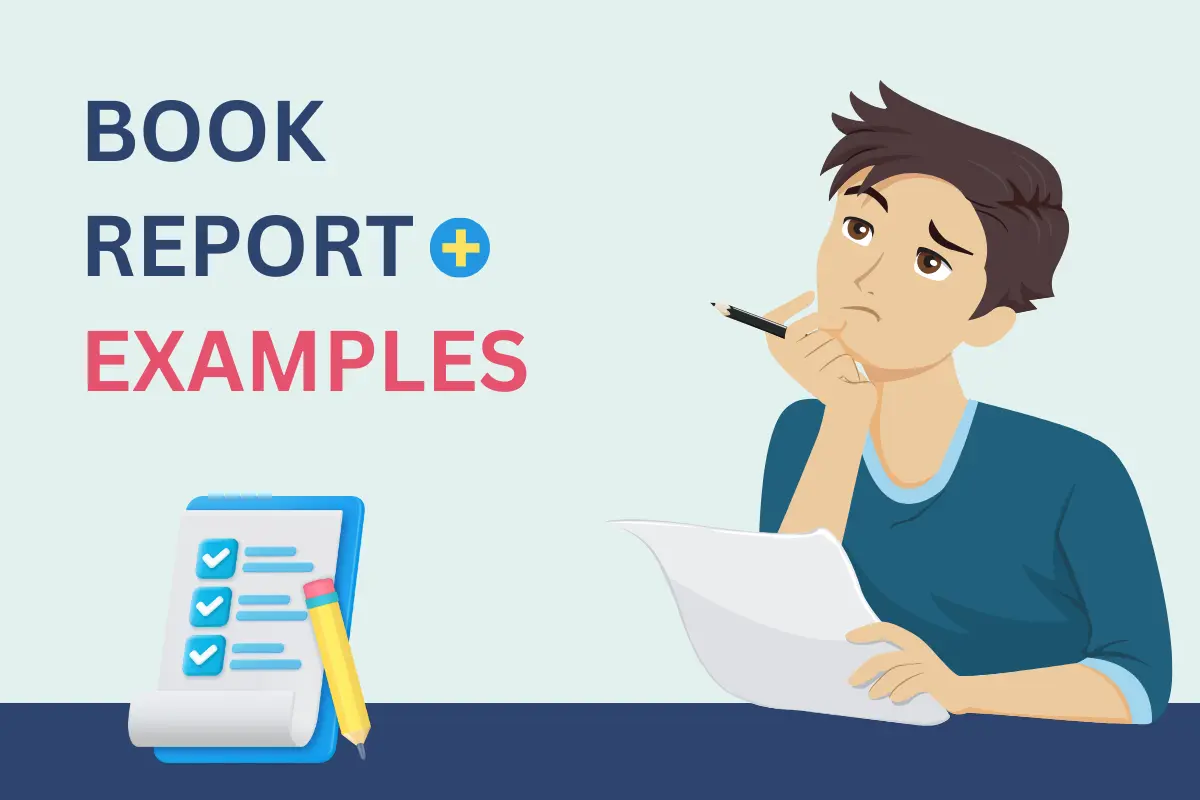
When you click on affiliate links on QuillMuse.com and make a purchase, you won’t pay a penny more, but we’ll get a small commission—this helps us keep up with publishing valuable content on QuillMuse. Read More .
Table of Contents
Do you have a book report to complete and want to know how to write a book report? We are right here for you! Book reports are useful in learning because they help students enhance their knowledge and critical thinking skills. At the same time, they give authors a detailed look at a text’s composition and stylistic aspects.
This essay will show us how to write a book report efficiently. It’s a skill that helps you not only get more out of what you’re reading but also write a report that accurately describes how great the book is. Let’s get started.
What is a book report?
You may ask, “What does a book report look like?” So, before we go into how to write a book report, let’s first define it. The report consists of the plot, characters, and style of the essays. It usually focuses on a single activity, but can also relate to a topic or theme. The report is usually a high school assignment designed to help students improve their communication and research skills. It also teaches students how to express themselves in many areas of their lives.
Book Report vs. Book Review
A book report and a book review are sometimes mistaken, although they are not the same. A book report summarizes a book’s content and analysis, whereas a book review evaluates its substance, style, and value. A book review is often written for a more advanced readership and is frequently published in a literary journal or newspaper.
What exactly is the aim of a book report?
There are some main purposes for writing a book report:
- Glance at the book to make it more readable.
- Provide enough information so that the reader may readily understand the text.
- Show the book’s style and tone.
- Encourage the reader or buyer to read and purchase the book.
- Discuss a book’s main parts.
- Provide a summary and evaluation of a piece of fiction.
Furthermore, creating a report helps the student enhance their analytical and communication skills. They can express themselves through creative or critical thinking in the texts they read.
Also Read: How to Write a Book About Your Life
What are the parts of a great book report?
Introduction including Title and Author : Consider how to start a book report with an appealing introduction. Mention the book’s title, author, and genre, and provide a brief storyline summary. Explain your major theme or point of view. Sometimes it includes the book’s publishing date.
Content summary : This part should include an overview of the book’s plot, including the main characters, setting, and conflict. Provide a succinct summary of the plot. Highlight important events and turning points. Avoid spoilers.
Analysis and perspective : Examine the main characters, including their characteristics, motives, development, and plot roles. Investigate important themes, symbols, and motifs, as well as how they affect the narrative. Examine the author’s writing style and perspective, as well as how they affect the plot.
Conclusion : Summarize your key ideas. Restate your general opinion of the book and perhaps recommend who might enjoy it or what types of readers would benefit from it. This part should sum up your thoughts on the book and its significance.
How to Start Writing A Book Report
When you start writing, you should be familiar with the essential processes. However, if you are unsure, there is no need to worry. Instead, look at the methods below to help you write a superb report.
1. Choose the book Carefully
Choosing the right book is a vital step in your writing process. Some teachers assign books to you, and you have no choice. However, if you choose a novel for yourself, make sure it interests you.
2. Properly Read the Book
Reading is a vital element of producing a good report since it helps you to delve into the details of the narrative. Unfortunately, many students believe they can get by with just the overview, notes, and details, but this is not the case if they want an A.
3. List the key points
Every time you read an excellent book, make a note of the most important topics and situations in your notebook. This assures that no matter where or when inspiration strikes, all of these riches are only a page away.
4. Create a thesis statement
The thesis statement is the most crucial aspect of your paper. It should be a claim you think to be correct. Furthermore, it might be backed by good instances from the book, enhancing the strength of your writing work.
5. Make the Book Report Outline
It is critical to have a decent and solid outline when creating the best report. When drafting the outline, be sure to include all of your ideas and opinions. It helps authors stay organized and focused on what needs to be done next.
Also Read: How to Become a Book Editor

How to Write A Book Report

When you start writing, you need to be familiar with the essential processes. However, if you are unsure, there is no need to worry. Here’s a comprehensive guide to writing a book report to get you started:
1. Write the introduction
The opening is the most significant element of your report because it introduces and presents the topics that will be covered in greater detail. As a result, the introduction paragraph should include both an attention-grabbing hook statement and a thesis statement that sums up everything.
2. Write the body paragraphs
The body of the report describes three major things:
- Main purpose
You should also consider the book’s theme or motif, as well as the character’s interactions with others.
3. Write the conclusion
The conclusion is where you mention three major points:
- Finish up the complete report.
- Describe what you learned from the book.
- Please state whether or not you would recommend it.
- Express your opinion about the book.
Also, this section should be concise, no longer than one paragraph. However, make sure it communicates everything that has to be expressed before closing with a suitable conclusion.
4. Proofreading
Once you’ve finished writing it, start proofreading. First, correct all grammatical, punctuation, and vocabulary errors. Also, modify the complex and tough words or sentences. Finally, strive to make it error-free and understandable to the audience.
Also Read: Best Writing Websites for Writers
Tips for Writing a Book Report
When writing a book report, keep the following factors in mind:
- Read Very Carefully : Pay close attention when reading to ensure that you thoroughly grasp the material. Take notes on essential topics such as themes and characters.
- Follow the Guidelines : Stick to what your teacher or whoever assigned the report expects. Make sure your work is the appropriate length and covers the appropriate topics.
- Outline Structure : Determine how your report will be organized. A simple outline with parts for introduction, summary, analysis, and conclusion can help you stay organized.
- Introduce the Book : Begin your report by providing basic information about the book, such as its title, author, genre, and a summary of why it is essential.
- Summarize and Analyze : Discuss what happened in the book while also delving into why it matters. Discuss the characters and how they evolve during the novel.
- Evaluate and Reflect : Discuss your ideas on the book, including what you liked, disliked, and why. Consider how the book touched you personally.
- Use Evidence : Back up your claims using examples from the text. Quotes or specific scenarios might assist you in illustrating your point and demonstrate that you truly grasped what you read.
- Proofread : Before submitting, go back and check for errors. Check for typos, spelling problems, and anything else that could make your report difficult to comprehend.
Also Read: How to Write a Book Title
Example of a great book report
To present a clear example of a book report, let’s look at “ The Adventures of Tom Sawyer ” by Mark Twain.
Introduction
“The Adventures of Tom Sawyer” is a popular novel written by Mark Twain and published in 1876. It follows Tom Sawyer through the childhood adventures and troubles of a mischievous and inventive little boy in a fictional village in St. Louis . . . . Petersburg, Missouri with comedy, suspense, and poignant observations about society And just right, this timeless story continues to appeal to readers of all ages.
Plot Summary
Set in the 19th century, the novel begins with Tom Sawyer living with his Aunt Polly, his brother Sid, and his cousin Mary. Tom is known for his fun spirit and willingness to get into trouble. He falls in love with the new girl in town, Becky Thatcher, and also develops a close relationship with his friend Huckleberry Finn, an outcast.
Throughout the story Tom is in a series of escapades, such as whitewashing a fence as punishment, searching for treasure with Huck, attending his funeral, and witnessing a murder These experiences illustrate Tom’s philosophy, n ‘mind, and growing maturity as he learns important lessons about friendship, responsibility and the impact of his actions Are known.
The story ends with Tom and Becky trapped in a cave, sparking a dramatic rescue that draws the community together and Tom finally emerges as a hero who has overcome the physical danger of the cave and its emotional challenges, the victory of youth.
Mark Twain’s “The Adventures of Tom Sawyer” offers more than just a simple children’s story. It subtly depicts life in small-town America in the 19th century, focusing on social interactions, cultural attitudes, and youthful innocence. Twain’s subtle style of writing and human behavior and her sly gaze make the story both funny and thought-provoking.
Tom Sawyer is a particularly interesting character, displaying the defiance and curiosity associated with infancy. Readers will experience the joys and challenges of growing older through Tom’s eyes, from the joys of discovery to the heartache of pain. Twain masterfully captures the essence of childhood, making one approachable and memorable.
Furthermore, the work delves into issues of autonomy, identity, and the search for meaning in a rapidly changing society. Whether Tom defies authority, faces ethical challenges, or makes friends across social boundaries, his journey reflects a universal struggle to find his place in society while staying true to himself.
In conclusion, “The Adventures of Tom Sawyer” remains a timeless work that continues to captivate readers of all ages. Mark Twain’s vivid storytelling, memorable characters, and insightful comments on society ensure the novel remains relevant and engaging more than a century after its publication. Through Tom Sawyer’s Escape, readers are reminded that the journey to adulthood is about the enduring power of imagination, friendship, and adventure.
What length should a book report be?
The length of a book report varies according to the assignment criteria. Book reports are typically one to three pages long, but they can be lengthier for more detailed assessments.
Should I add my opinion to a book report?
Yes, you should include your perspective in a book report. However, be careful to back up your thoughts with facts from the text. Your comments and evaluations contribute to the report’s interesting and informative nature.
Do I have to read the whole book to write a book report?
While it is preferable to read the full book to produce a thorough analysis, you can still write a book report based on substantial chunks of it. However, make sure you fully comprehend the plot, characters, and themes.
How should I format a book report?
Follow any formatting guidelines specified by your instructor or institution. Book reports are typically written as essays, having an introduction, body paragraphs, and a conclusion.
Can I utilize outside sources for my book report?
It depends on the assignment’s requirements. In some situations, you may be asked to use outside sources to supplement your analysis.
Should I use quotes from the book in my report?
Yes, using quotes from the book can help to strengthen your analysis and provide evidence for your observations. Simply make sure to correctly cite any quotations using the required citation style.
How should I conclude a book report?
At the end of your book report, summarize your main themes and share your final thoughts on the book. You can summarize your overall assessment and describe the book’s significance or impact.
How we've reviewed this article
Our content is thoroughly researched and fact-checked using reputable sources. While we aim for precision, we encourage independent verification for complete confidence.
We keep our articles up-to-date regularly to ensure accuracy and relevance as new information becomes available.
- Current Version
- Jun 21st, 2024
- Feb 21st, 2024
Share this article
Prev Previous Next Next
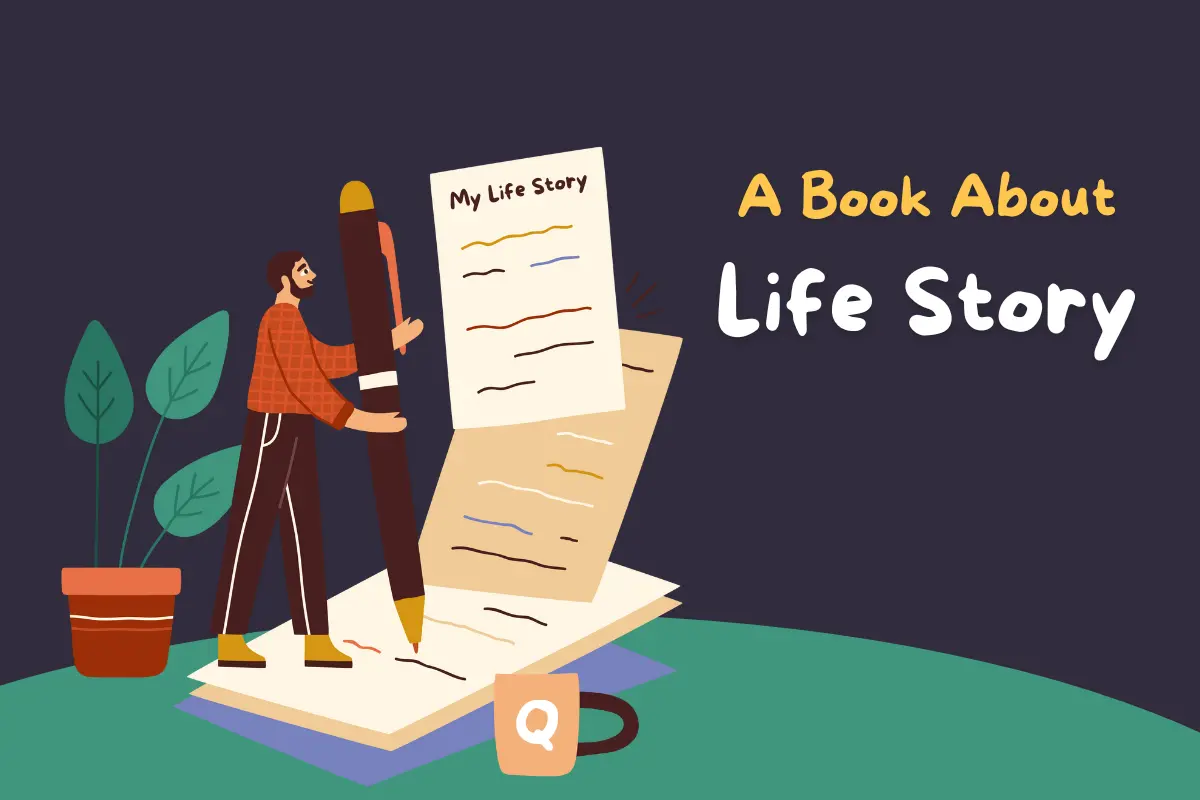
How to Write a Book About Your Life: 8 Powerful Tips with Examples
Everyone indeed has a unique story to tell, and some people have a life story worth sharing with others. But How to Write a Book About Your Life? If you’re one of those people who have considered writing an autobiography or memoir but are still trying to figure out where
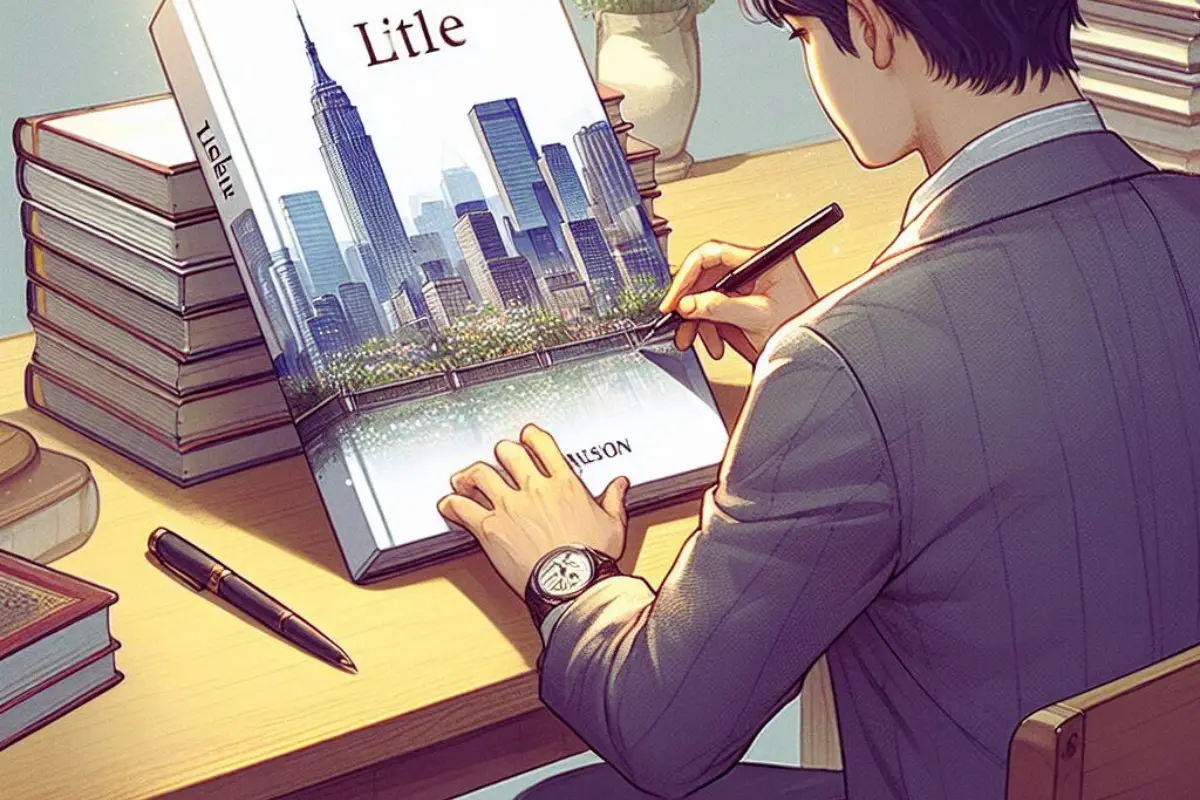
How to Write a Book Title in 8 Steps With Examples
You have penned a book, then. Best wishes! Do you mean the difficult part is over? Kind of. Before you publish your book, you still need to do some more brainstorming. The next step is to learn how to develop a book title that draws potential readers in and encourages

How to Write a Book Like a Pro in 2024
Deciding to start writing a book can be intimidating, especially if you’re a beginner. It can paralyze you When you’re unsure where to begin writing a book. Starting and finishing a book requires grit, but we believe that with the right tips and tools, anyone can do it. You have
Report this article
Let us know if you notice any incorrect information about this article or if it was copied from others. We will take action against this article ASAP.
- Profile Page
- Edit Profile
- Add New Post
Read our Content Writing Guide .
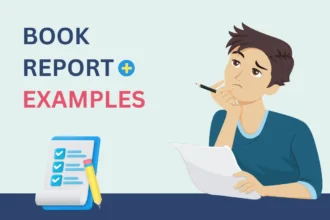
Printable Book Report Outlines and Examples
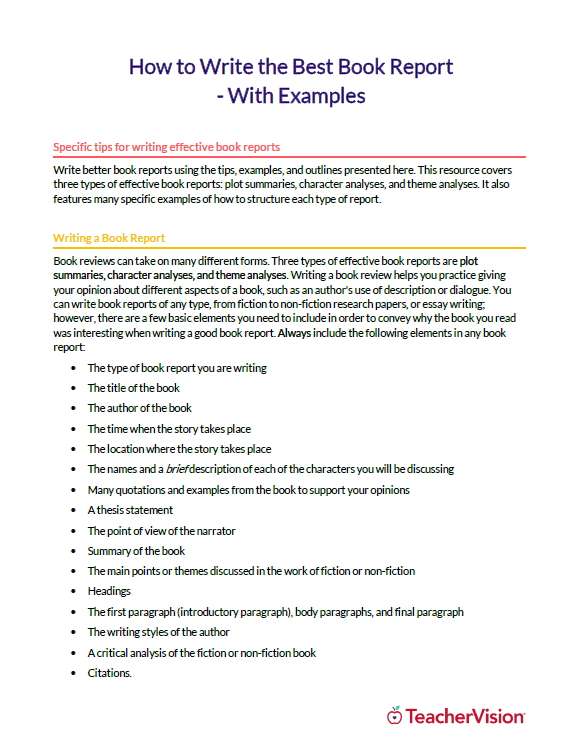
| Add to Folder | |
|---|---|
| creative writing | |
| children's book | |
| activities | |
| classroom tools | |
| language arts and writing | |
| vocabulary |
Assigning a book report as part of your reading or writing curriculum? Print and share this quick reference for how to write a book report - including all of the necessary elements, plus examples and outlines.
Looking for fiction and nonfiction titles to assign for book study, reader's theater, or literature circles? Visit our Literature Teaching Guides Hub to find thousands of book guides for all grades.

Featured Middle School Resources

Related Resources
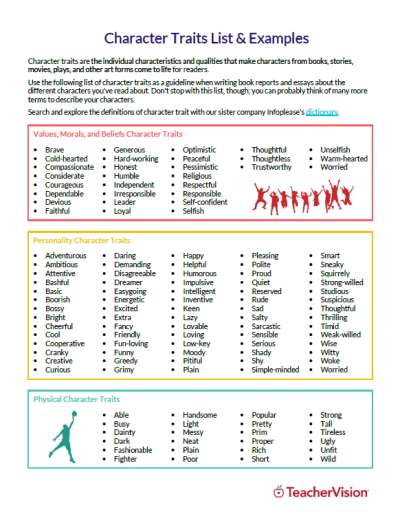
About the author

TeacherVision Editorial Staff
The TeacherVision editorial team is comprised of teachers, experts, and content professionals dedicated to bringing you the most accurate and relevant information in the teaching space.


Book Report Writing for Students
Report generator.

Writing a report is normal for students in elementary, high school and even for college. Although there are many different kinds of reports that will be asked by the teachers to be submitted by the students, there will always be that one kind of report that is common all throughout your entire school life, and that is a book report.
- Financial Report Examples
- Examples of Business Report
In elementary, you are typically given a specific format to follow so that it will be easier for the teacher to track as to whether the student is following the instructions or not. This format is also useful in helping the students with how they should organize the structure of their book report, from beginning till end. There are many ways of preparing your report. But, it is best if you follow these steps listed below as it may make your life a lot easier. You may also see the report writing examples to give you a better idea.
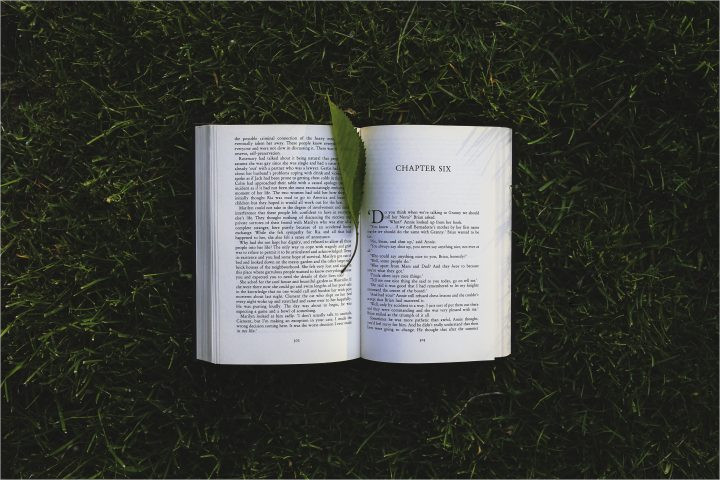
How to Write a Book Report
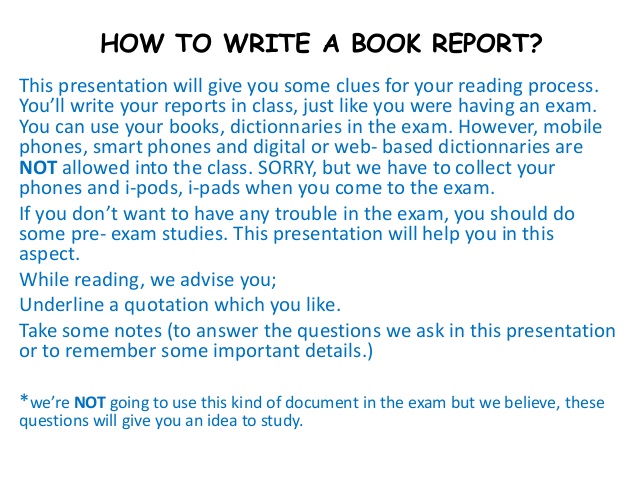
Size: 77 KB
Researching and Outlining Your Report
1. follow the requirements of your assignment..
Even though you will be exercising your own creativity in this book report, keep in mind that there are still instructions that should still have to be followed. If there are any clarifications or questions that you would like to raise to your teacher before beginning the assignment, it would be the perfect time to do so. You may also see free report examples .
- One of the things that you would need to clarify with your instructor is whether citations and page numbers are necessary items to be added in the book report.
- Try to ask your instructor on how much of the book report should be dedicated to the summary of the story. After all, most book reports are direct summaries with only a few opinions mixed in. You may also see incident reports .
2. Read the Entire Book.
What’s the point of writing a book report if you know nothing about the book itself? If you are more visual than imaginative, I would suggest you watch an adapted screenplay of the said book in order to cut down the “boringness” you might feel when you read it. But, keep in mind that movies (no matter how well-told) will always leave out some details or scenes that are found in the novelization. But then again, it is entirely up to your discretion. You may also see monthly reports .
- If you have the ability to read without getting bored, then I would suggest you read the whole thing in one go to keep the momentum going. If you need a break or need to eat, then do so while reading if it is something impossible to put down even for a second.
- Do not even think about skimming the book. Capture the moment of the scenes being offered to you. Read about every detail and allow your imagination to take flight. You may also see activity reports .
- Last but never the least, allow yourself to never read book summaries online. They can never be trusted. You will never know what they might have left out. It is better if you commit time to reading the whole thing than being a killjoy.
3. Take Careful Notes when Reading.
If there is a specific plot twist that gets to you, write it down. If there is a scene that created a huge impact, write it down. If there is a character that you can relate to, write it down. Write down what you like. Write down what you hate. Take notes while you read them. If you do not want your momentum to be ruined, you can always go back to it when you are done. You may also see formal reports .
- When you are finished with your outline, go back through it to see if it makes sense. Reorganize and restructure the whole outline if you have to. Do not forget that this is just a guide for you, and it can be changed.
- Outlining does take a bit of time, but it will save you time in the proofreading stage. You may also see book reports .
4. Create an Outline.
An outline does not have to be too complicated. It can even only be a couple of one-liners from the story so as to give you the gist of what you need to include in that certain area. Indicate what each paragraph will discuss and the details from the work that you’ll include. Outlines can change from time to time. You may also see short reports .
Intermix Examples and Quotations from the Text.
As you construct your outline, try to pair any general points of the summary with specific details from the book. This will show your teacher that not only have you read the book, you understand it. Vary your examples and keep your quotations brief. You may also see expense reports .
Don’t Try to Cover Everything.
This is probably both impossible and improbable for two reasons. First, if you attempt to cover everything in the story, people might as well just read your book report instead of buying the book itself since the plot and everything else is already explained. And second, there is a tendency that you might leave out some important details in the process, even if you have covered everything. This is just a summary. You may also see service reports .
For example, you’ll likely need to focus primarily on discussing the most important characters or the characters that appear most frequently in the text.
My Book Report Sample 1

Size: 76 KB Download
Writing the Body of Your Report
1. open with an informative intro paragraph.
Start strong and end strong. First impression matters, so make it count. If you are still in elementary, then it is best not to try too hard at making an attention-grabbing sentence. But, if you are in college or high school, you might be able to think of something. But it is important to include the author’s name and the book title in the first paragraph. You may also see management reports .
- Try not to take up too much space with your introduction. It should be more than two and generally less than ten sentences long.
2. Describe the Book’s Setting
This is a great way to start the body of your paper because it will set the stage for everything else that you’ll discuss in your report. Describe the locations mentioned in the book so that your teacher will know exactly what you are referring to. You may also see status reports .
- Add color and life to the summary. If the place was smelled like the stench of death and decay, by all means, add it there.
3. Include a General Plot Summary
This is where you need to describe the exact outcome of the book in less than two paragraphs. The plot summary should mention all major events that took place and how each event impacted the characters. You may also see performance reports .
4. Introduce Any Main Characters
The book revolves around its characters (both protagonists and antagonists). Make sure when you are describing your characters, give every detail on how they look like, their actions and the skills they possess. You may also see investigation reports .
5. Examine Any Main Themes or Arguments in Your Body Paragraphs
Look for the ‘big ideas’ as you are reading. In a fiction work, pay attention to the character’s actions and how they follow certain patterns if they do. In a nonfiction work, look for the author’s primary thesis statement or argument. What are they trying to prove or suggest?
- For example, you might write, “The author argues that travel gives you a new perspective. That is why her main characters all seem happier and more grounded after visiting new places.”You may also see recruitment reports .
- For a fiction work, watch to see if the author is using the story to pass along a certain moral or lesson. For example, a book about a fictional underdog athlete could be used to encourage readers to take chances to pursue their dreams. You may also see medical reports .
6. Comment on the Writing Style and Tone.
Different writers and authors have different personalities and have different writing styles. If you think that the author was sort of informal or too casual when he wrote the book, note that down. Language is considered a vital aspect of writing a book, depending on who your audience is as well. You may also see consulting reports .
Book Report Sample Format 3

Size: 147 KB Download
Finishing Up Your Report
1. write a concise conclusion.
Start strong and end strong. When everything else is forgotten, at least the readers have something they can remember from your summary. Include a few quick sentences summarizing the entire book. You can also make a final statement about whether you’d suggest the book to other readers and why. You may also see visit reports .
- Don’t introduce any new thoughts in this final paragraph. Save the space for your recap.
2. Proofread Your Paper.
Double check the content of your paper to make sure everything is intact. Typos, grammatical errors, punctuation marks. You can also try to read your paper out loud so that you may be able to identify some points that you are missing. You may also see sales reports .
3. Polish Your Final Report.
Once you’ve made the necessary corrections, print out a clean version of your report. Read through it slowly and carefully. Look for any typos or minor errors. Compare your report to the guide sheet to make sure that you’ve followed all of your teacher’s directions. You may also see project reports .
Writing a book report does not have to be too complicated. It can even be as simple as the ones found above. Keep in mind that the simpler and more colorful your book report is, the better it is. You may also see employee reports .
Text prompt
- Instructive
- Professional
Generate a report on the impact of technology in the classroom on student learning outcomes
Prepare a report analyzing the trends in student participation in sports and arts programs over the last five years at your school.
How to Write a Great Book Report
Hero Images / Getty Images
- M.Ed., Education Administration, University of Georgia
- B.A., History, Armstrong State University
One assignment has lasted the test of time, uniting generations of students in a common learning exercise: book reports. While many students dread these assignments, book reports can help students learn how to interpret texts and gain a broader understanding of the world around them. Well-written books can open your eyes to new experiences, people, places, and life situations that you may have never thought about before. In turn, a book report is a tool that allows you, the reader, to demonstrate that you have understood all the nuances of the text you just read.
What's a Book Report?
In the broadest terms, a book report describes and summarizes a work of fiction or nonfiction . It sometimes — but not always — includes a personal evaluation of the text. In general, regardless of grade level, a book report will include an introductory paragraph that shares the title of the book and its author. Students will often develop their own opinions about the underlying meaning of the texts through developing thesis statements , typically presented in the opening of a book report, and then using examples from the text and interpretations to support those statements.
Before You Start Writing
A good book report will address a specific question or point of view and back up this topic with specific examples, in the form of symbols and themes. These steps will help you identify and incorporate those important elements. It shouldn't be too hard to do, provided you're prepared, and you can expect to spend, on average, 3-4 days working on the assignment. Check out these tips to ensure you're successful:
- Have an objective in mind. This is the main point you want to present or the question you plan to answer in your report.
- Keep supplies on hand when you read. This is very important. Keep sticky-note flags, pen, and paper nearby as you read. If you're reading an eBook , make sure you know how to use the annotation function of your app/program.
- Read the book. It seems obvious, but too many students try to take a shortcut and simply read summaries or watch movies, but you often miss important details that can make or break your book report.
- Pay attention to detail. Keep an eye out for clues that the author has provided in the form of symbolism . These will indicate some important point that supports the overall theme. For instance, a spot of blood on the floor, a quick glance, a nervous habit, an impulsive action, a repetitive action... These are worth noting.
- Use your sticky flags to mark pages. When you run into clues or interesting passages, mark the page by placing the sticky note at the beginning of the relevant line.
- Look for themes. As you read, you should begin to see an emerging theme. On a notepad, write down some notes on how you came to determine the theme.
- Develop a rough outline. By the time you finish reading the book , you will have recorded several possible themes or approaches to your objective. Review your notes and find points that you can back up with good examples (symbols).
Your Book Report Introduction
The start of your book report provides an opportunity to make a solid introduction to the material and your own personal assessment of the work. You should try to write a strong introductory paragraph that grabs your reader's attention. Somewhere in your first paragraph , you should also state the book's title and the author's name.
High school-level papers should include publication information as well as brief statements about the book's angle, the genre, the theme , and a hint about the writer's feelings in the introduction.
First Paragraph Example: Middle School Level
" The Red Badge of Courage ", by Stephen Crane, is a book about a young man growing up during the Civil War. Henry Fleming is the main character of the book. As Henry watches and experiences the tragic events of the war, he grows up and changes his attitudes about life.
First Paragraph Example: High School Level
Can you identify one experience that changed your entire view of the world around you? Henry Fleming, the main character in "The Red Badge of Courage", begins his life-changing adventure as a naive young man, eager to experience the glory of war. He soon faces the truth about life, war, and his own self-identity on the battlefield, however. "The Red Badge of Courage", by Stephen Crane, is a coming of age novel published by D. Appleton and Company in 1895, about thirty years after the Civil War ended. In this book, the author reveals the ugliness of war and examines its relationship to the pain of growing up.
The Body of the Book Report
Before you get started on the body of the report, take a few minutes to jot down some helpful information by considering the following points.
- Did you enjoy the book?
- Was it well written?
- What was the genre?
- (fiction) Which characters play important roles that relate to the overall theme?
- Did you notice reoccurring symbols?
- Is this book a part of a series?
- (nonfiction) Can you identify the writer's thesis?
- What is the writing style?
- Did you notice a tone?
- Was there an obvious slant or bias?
In the body of your book report, you will use your notes to guide you through an extended summary of the book. You will weave your own thoughts and impressions into the plot summary . As you review the text, you'll want to focus on key moments in the storyline and relate them to the perceived theme of the book, and how the characters and setting all bring the details together. You'll want to be sure that you discuss the plot, any examples of conflict that you encounter, and how the story resolves itself. It can be helpful to use strong quotes from the book to enhance your writing.
The Conclusion
As you lead to your final paragraph, consider some additional impressions and opinions:
- Was the ending satisfactory (for fiction)?
- Was the thesis supported by strong evidence (for nonfiction)?
- What interesting or notable facts do you know about the author?
- Would you recommend this book?
Conclude your report with a paragraph or two that covers these additional points. Some teachers prefer that you re-state the name and author of the book in the concluding paragraph. As always, consult your specific assignment guide or ask your teacher if you have questions about what is expected of you.
- How to Start a Book Report
- How to Find the Theme of a Book or Short Story
- 10 Steps to Writing a Successful Book Report
- Understanding Point of View in Literature
- Overused and Tired Words
- How to Write a Character Analysis
- Conflict in Literature
- Symbols and Motifs in Literature
- How to Write a Response Paper
- What Is Expository Writing?
- 501 Topic Suggestions for Writing Essays and Speeches
- How to Write a Great Process Essay
- Make Your Paragraphs Flow to Improve Writing
- Examples of Great Introductory Paragraphs
- Writing a History Book Review
- How to Write a Good Thesis Statement
- Grades 6-12
- School Leaders
Get Your Free 21st Century Timeline Poster ✨
Free Book Report Templates: Printables for Grades 3-5 for Fiction or Nonfiction Books
Take a new spin on your book report assignment. 📚😍
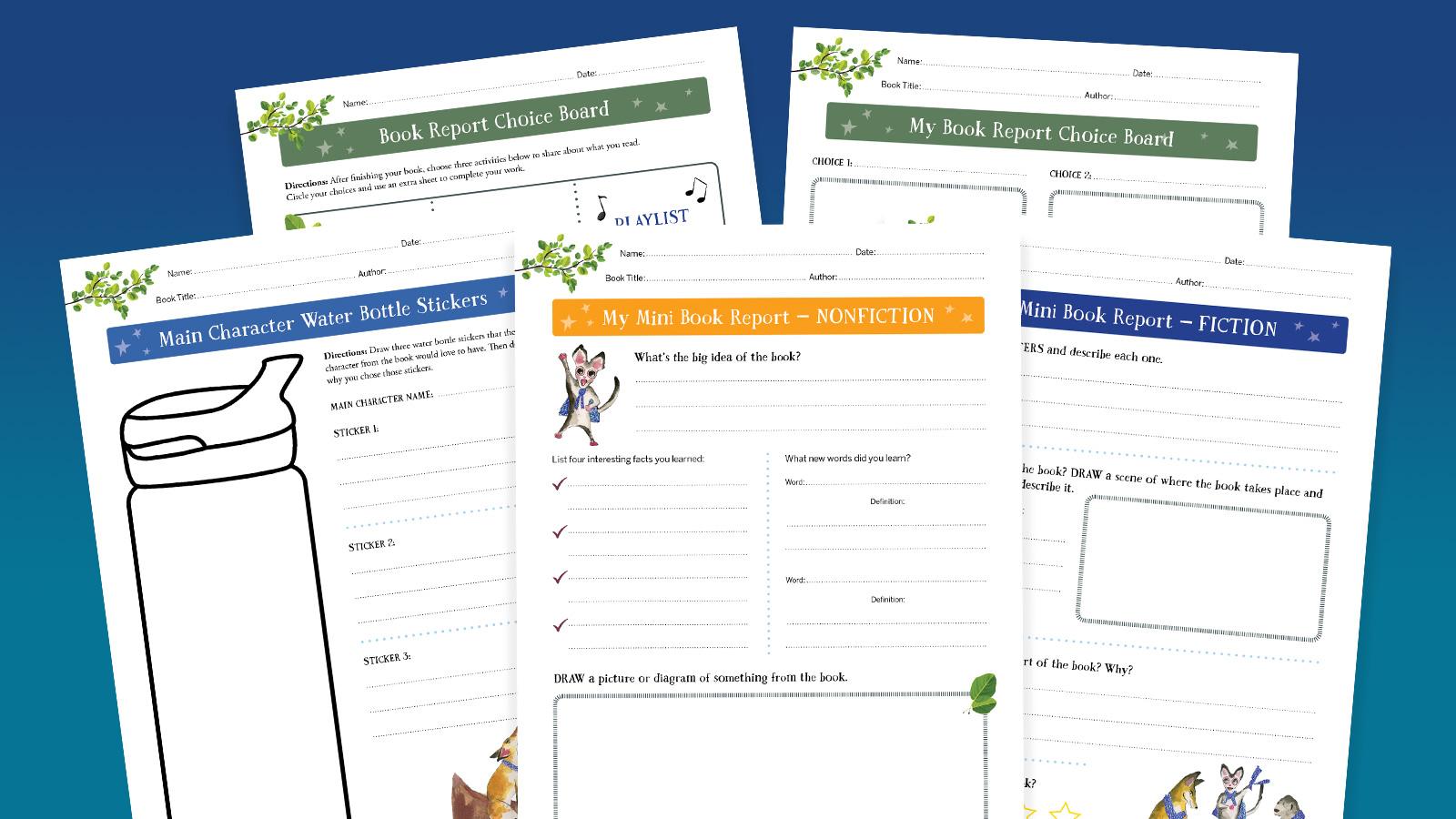
The Nocturnals are fun-filled animal adventure books with companion nonfiction for elementary school classrooms. Check out The Nocturnals World , a resource hub with free turnkey printable activities and educator guides, and browse The Nocturnals bookstore!
Building lifelong readers is one of the most important things we can do in our classrooms. The benefits of reading are wide-ranging, from improving vocabulary skills to boosting cognitive development, concentration skills, and curiosity for learning. So, how do we get young learners excited about reading and sharing what they’ve learned? Check out our free book report template printables .
Four different activities are ready to print to help you take a new spin on your next book report assignment for fiction or nonfiction books. Students will love filling in their mini book report one-pagers or making their selections from the choice board to share details about what they read.
Worksheets Included:
My mini book report—fiction and nonfiction.
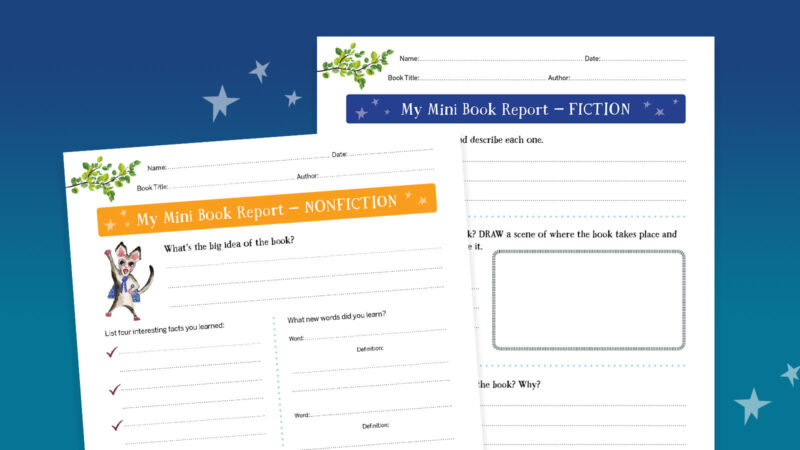
These book report one-pagers are a great way for students to reflect on their readings as they complete different sections of the worksheet. There’s a version for both fiction and nonfiction.
Book Report Choice Board
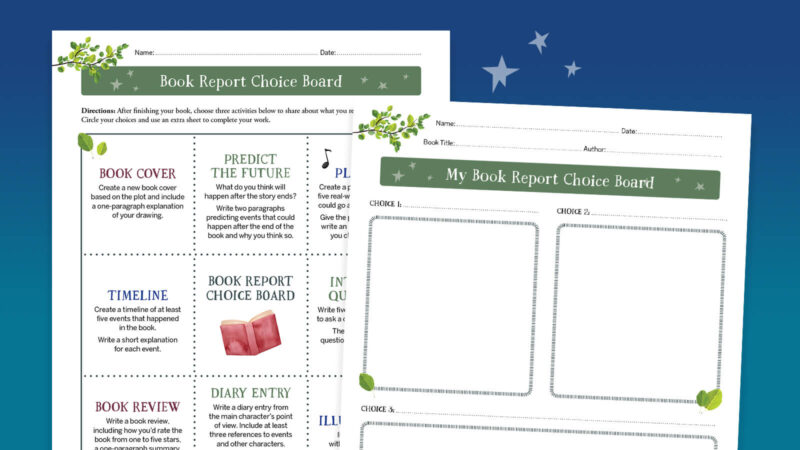
Give students choices on how they want to complete their book report assignment. This choice board offers eight fun options, from designing a comic to creating a playlist or writing interview questions, so students can let their creativity guide them.
Designing Water Bottle Stickers
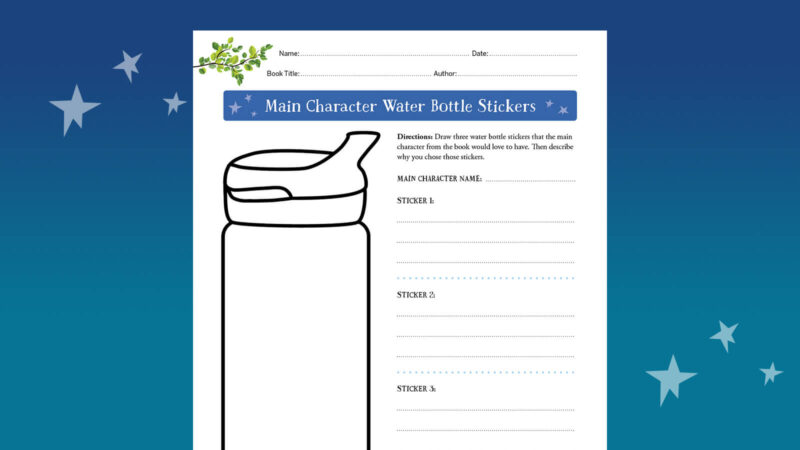
Students are obsessed with stickers. In this unique activity, students will design water bottle stickers that the main character of the book would love to have, along with a short description of their choices.
Give students fun-filled books to choose from
Animal adventure books from The Nocturnals are the perfect way to get your upper elementary students excited about reading. Paired with nonfiction companion texts that explore nocturnal animal facts, this series is great for hi-lo readers. Visit The Nocturnals World for more free printable activities and educator guides.
You Might Also Like
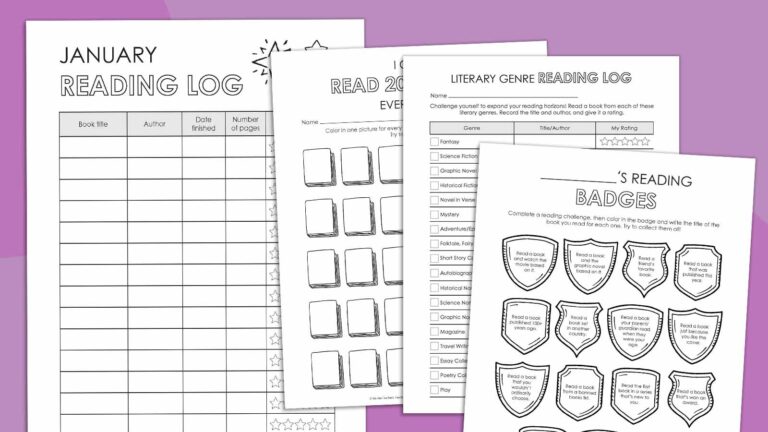
Free Reading Log Printable Bundle To Track Student Achievement
So many options for every age! Continue Reading
Copyright © 2024. All rights reserved. 5335 Gate Parkway, Jacksonville, FL 32256
- TemplateLab
Book Report Templates
30 book report templates & reading worksheets.
Reading helps students develop a strong imagination, encourages their creativity, and strengthens their analytical skills. Teachers assign a lot of book reports to ensure that students read lots of books, especially at that critical early age when they are still trying to master the written word. To cut down on some of the workload, students and teachers can find a book report template to download and fill in. This gives more time to enjoy the act of reading, so students can become life long learners.
Table of Contents
- 1 Book Report Templates
- 2.1 Why Provide A Book Report Form
- 2.2 Sections Of A Simple Book Report
- 2.3 Sections Of A Multi-Page Report
- 3 Sample Book Reports
- 4 Difference Between The Book Report Types
- 5.1 What To Do Once You’ve Written The Report
- 6 Book Report Examples
- 7 Tips for Teachers
- 8 Tips for Students
What Is A Book Report
A book report is typically given as an assignment to students in elementary and middle school. Students fill out a form answering basic questions about the book they were assigned to read. Turning in the report serves as proof to the teacher that the student read the book and, hopefully, got something out of it.
These reports may ask students to detail what the book was about, the names of the main characters, what the theme of the book is, and where the events are set. Some reports may ask specific questions about events or characters to ensure that the students read the book all the way through. The report can also help students understand the book better by asking them to think about its meaning and the plot.
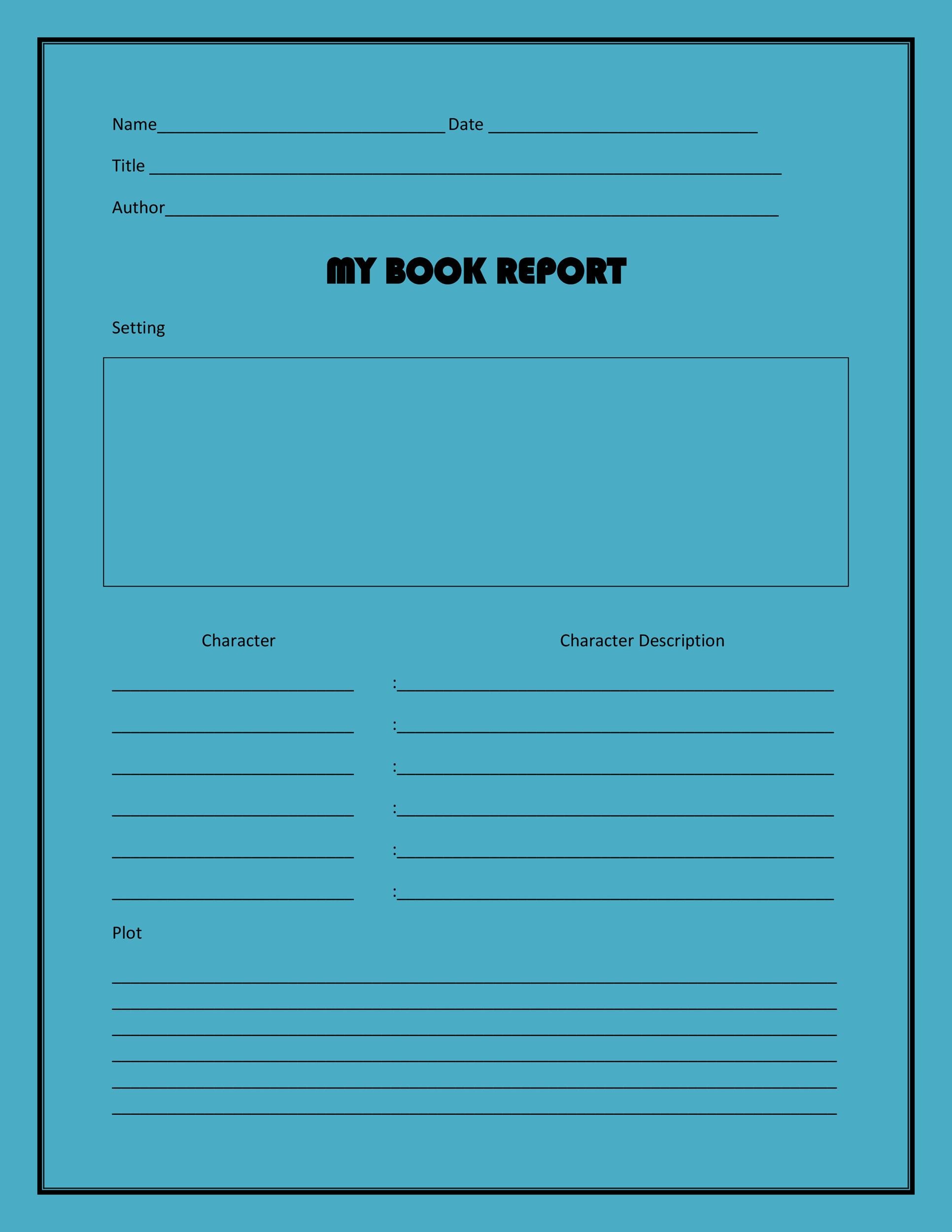
Reading Worksheets
Teachers may also hand out worksheets for students to complete in class or as homework. These are usually limited to the earlier grades when students are still learning to read. Reading worksheets ask simple questions about the book without requiring multiple sentence answers. These questions may ask students to name a favorite character, or mention the main conflict in a few words.
It’s not uncommon for the teacher to read a picture book with the class and have students fill out a worksheet afterwards. If the classroom has a bookshelf, there may also be a ‘Reading Time’ when students pick out a book to read. When they finish, the students fill out the worksheet and submit it to their teacher.
Why Provide A Book Report Form
Book report forms are a popular choice of assignment for elementary school classes. These forms make it simple for students to complete the report by filling out the worksheet. These sheets can be generic with standard questions, or teachers may create a unique sheet with questions specific to each different book that is assigned.
These forms also help introduce students to the idea of a book report format and show them what kind of information may be expected on longer, multi-page reports that they are expected to complete in the higher grades. A form is also easier to grade , especially for teachers who have a large classroom and more assignments to go over than usual.
Sections Of A Simple Book Report
A simple book report features a few sections that ask students to answer questions in paragraph format. These each ask students to detail a different element of the book. All book report forms will ask for the title, author name, and the illustrator’s name, if it is a picture book. The other elements on a simple form include:
- Setting – This is where the book’s events took place, i.e. New York.
- Characters – A list of who the main characters are and their names.
- Plot – A basic overview of the major events in the book.
- Your impressions – Whether you like the book or not, and why.
A simple form may also just ask the students to describe the beginning, middle, and end events of the book in three questions. Students may also be expected to identify the climax, which is the most intense point of the book where the main character’s problems are resolved or made worse. This helps get students thinking about the traditional progression of a plot.
Sections Of A Multi-Page Report
Eventually, teachers transition students to writing a multi-page book report. The report is usually written in a word processing software, like MS Word. Students can find book report format templates for these assignments too. These longer reports are written out in paragraph form. The teacher asks the students to address different elements of a book in their own words or with their own formatting. A simple way to organize these reports is to divide them into three basic sections, the introduction, main body, and conclusion. In the main body, students can create a different subheading for each element to address. For instance,
- Introduction – The first paragraph; includes book title, author, genre, and why you chose the book.
- Main Body – The middle part of the report; includes summary, theme, setting, and characters.
- Conclusion – A short summary of the book report and opinion of the book.
Sample Book Reports
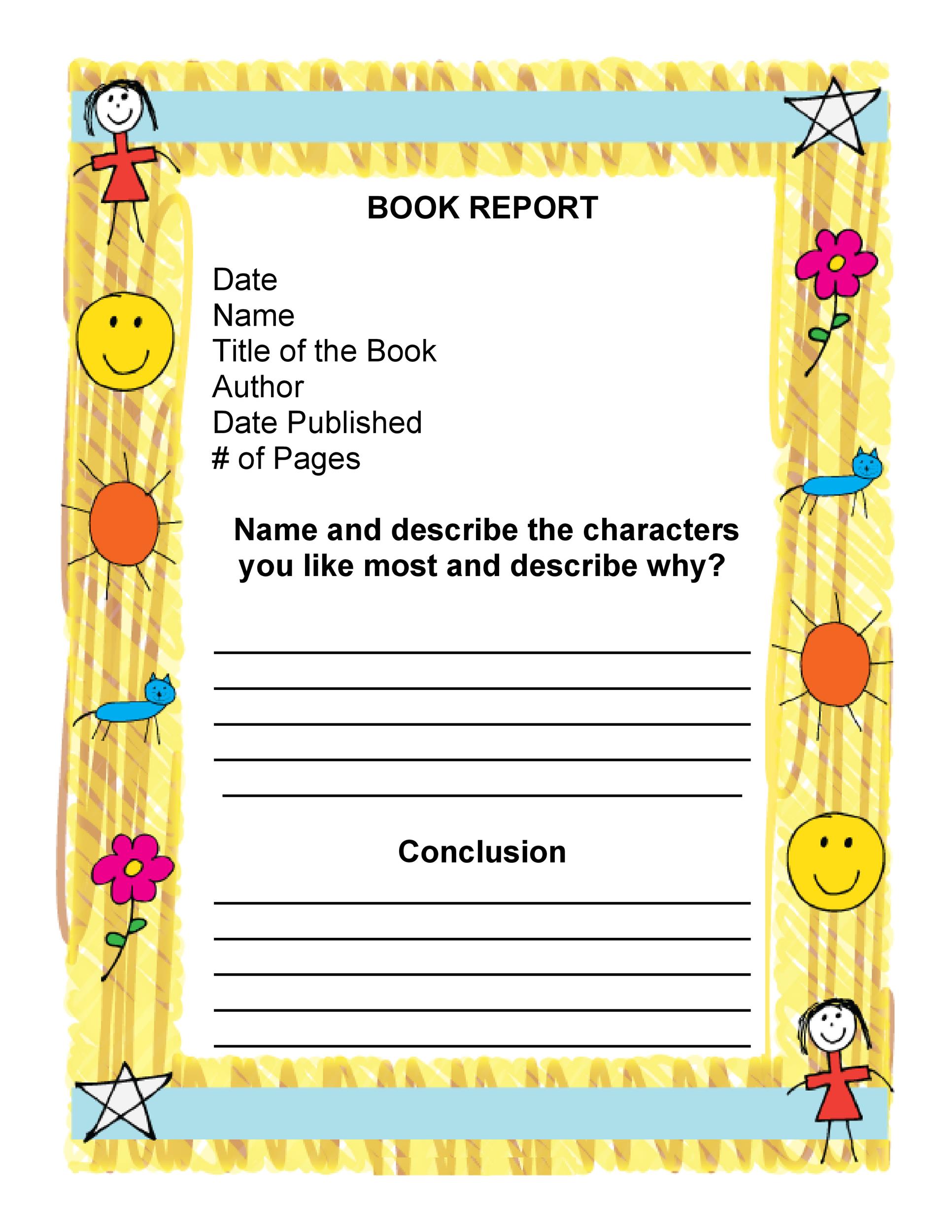
Difference Between The Book Report Types
The short book report form is handed out by the teacher and can be completed in one night like a homework assignment. A multi-page report is created by the student and may take more than one night to finish.
Short templates are available in lots of fun book report ideas suitable for young children. They have questions with a few lines to hand write the answers in a few short sentences. Some templates may include activities to make them more interesting to students, such as having them draw out a scene from the book or re-write the ending.
Multi-page reports start out as two page reports and gradually increase in size through middle school and high school. Of course, those two page reports are just as difficult for young students as the five page reports are for high school students . The great thing about these assignments is that students are usually free to organize their book report ideas however they desire. They can create bold sub-headers for the main body of the report. Students can write about the theme, characters, and setting separately. Or they can leave out the headers and devote their report to a specific element, such as the book theme. This allows students to weave information about characters and setting into the report where they are most relevant to the theme. The former works well for short chapter books, and the latter is better for books that may feature multiple themes.
Ideas for Different Kinds of Book Reports
There is more than one way to complete a book report. Both teachers and students may find these creative ideas more interesting than a straightforward report.
Write a review of the book. Create the report in the form of a newspaper or blog review. Summarize the book without giving away the plot or the ending. Talk about what made you like it or, if you hated it. Feel free to give the book a thumbs up or down rating at the end.
Do a diary. Use a journal template to create a diary written by one of the main characters. There should be multiple entries that follow or discuss the events of the book from that character’s point of view.
Interview one of the characters. Create an imaginary interview with one of the characters in the book. Ask them questions about where they come from, why the character did something important to the plot, and what the character thinks about the outcome of the events in the book.
Write a newspaper article. Create an imaginary newspaper article detailing one of the major events in the book, such as a theft or an important discovery. Make sure to answer the who, what, where, when, and why of these events in your article.
What To Do Once You’ve Written The Report
When students finish writing out their book reports, they have completed what is called the “First Draft” or “Rough Draft”. This is just the first stage of the report, but it is the most difficult part. Finishing up that report in the following steps is a lot easier.
Read and mark the report. Read through the book report from beginning to end to get a feel for it overall. Get a brightly colored pen to mark any spelling or punctuation errors you find in the report. Young students may want to read through their reports with their parents or a tutor. Sometimes, teachers actually make students submit a rough draft of their reports for points before the final report is due. The teacher reviews the draft, makes edits, and suggestions for changing the report before final submission.
Make edits to the report. Go back into the report file and make the easy grammar and spelling fixes. Take a look at your teacher’s suggestions or the ideas you wrote down for things to change in the report. Create a plan to make those additions or changes. Make the changes to the report. Don’t forget to save your file as a separate document. For instance, save your rough draft as, Report1.doc, and this updated version as, Report2.doc.
Review the report. Print out a fresh copy of the report. Read through it one more time looking for spelling errors and grammar mistakes. Keep an eye out for spots where the text doesn’t make sense. This can sometimes happen when you add new content to a report. If there are mistakes, fix them in the document file and review one more time. Your final draft is ready to print out when you can no longer find any mistakes.
Book Report Examples
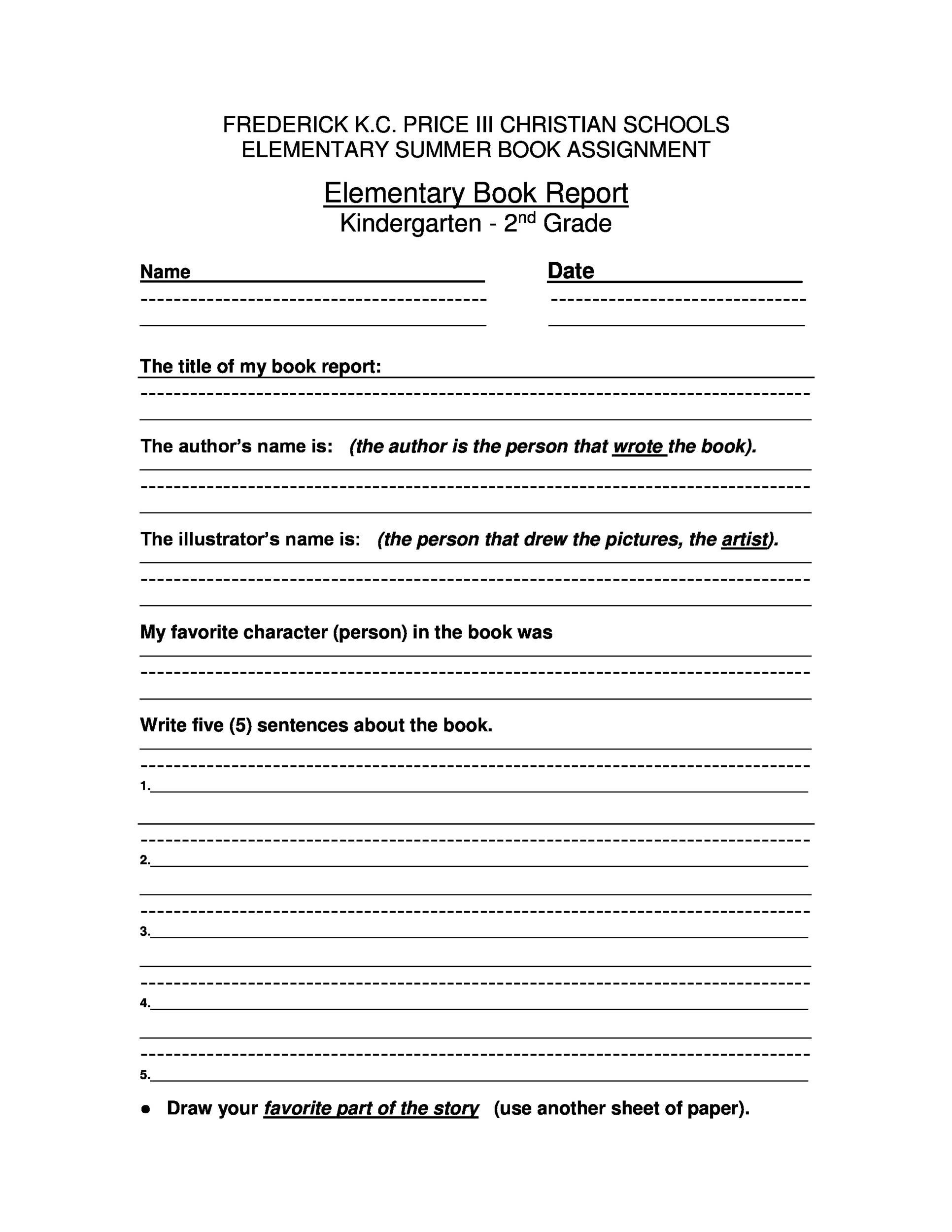
Tips for Teachers
Book reports are a big part of the curriculum. That doesn’t mean they have to be a lot of work for the students or the teacher. Make assigning these reports less of a hassle with these tips.
- Assign one book for the entire class to read. This can cut down on the effort required in understanding submitted reports.
- Pick out a short book report template to use. There is no need to use valuable time in creating one from scratch.
- Print out more copies of the form than are needed. Some students may lose theirs and need an extra form.
- Make reminder announcements when a due date approaches. Remind students at least twice before a book report due date.
- Keep the word count requirement low. Teachers also have to spend more time reviewing longer reports.
- Consider creative alternatives to some written reports. When your curriculum includes a lot of book reports, give students the option of turning in a drawing, diorama, or another project as a break.
Tips for Students
Being assigned a book report to complete can seem like a daunting task, especially if if you have never written a multi-page report. Make sure you don’t fall behind on the work by following a few of these tips.
- Make up a reading schedule to complete the book well in advance of the report being due. Use a calendar to remind yourself.
- Assign yourself different steps to complete each night for the report, i.e. make an outline, write 200 words, or revising
- Ask the teacher for help with ideas if you can’t figure out how to get started.
- Look for examples of completed reports to see how they are structured.
Book reports vary in their length and complexity. Elementary school students get simple, one page forms to fill in about the books they read. Those in middle school and high school usually have to write multiple page reports. Nearly all reports require students to talk about the plot, theme, characters, and how they liked the book. Both students and teachers can find a lot of templates to use. Those looking for something generic for students to fill in after reading a book can pick up a .pdf or .jpg form. Those who want more control over the look and wording of the template should download a .doc file.
More Templates
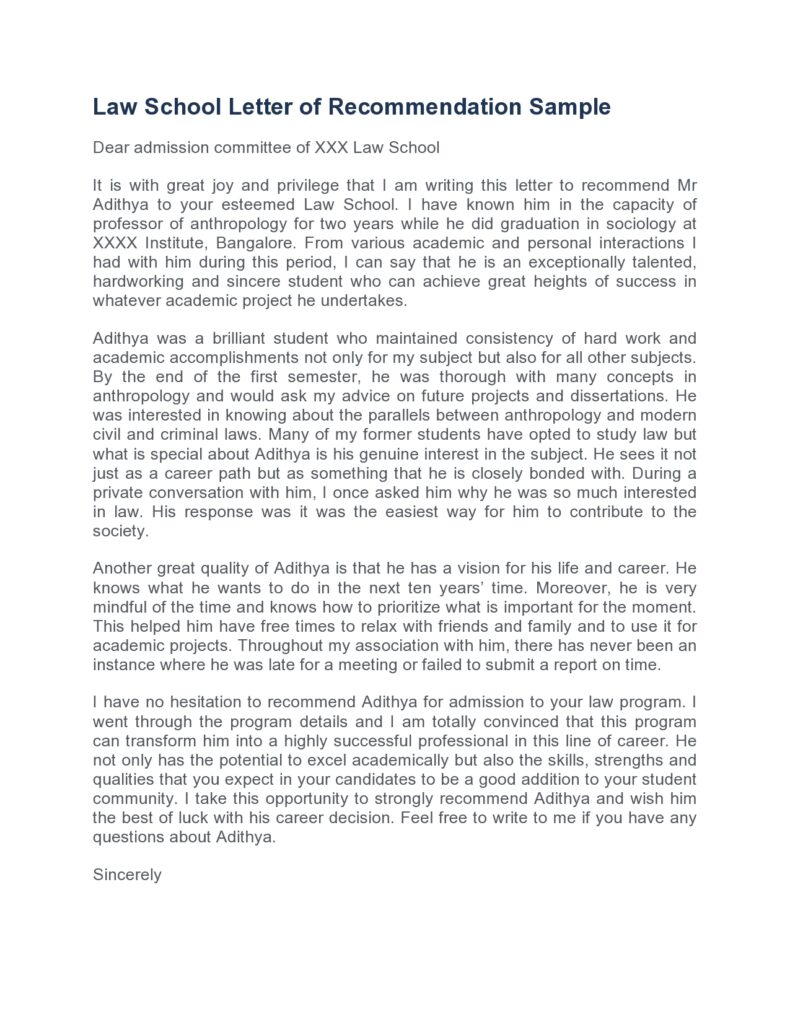
Law School Letters Of Recommendation
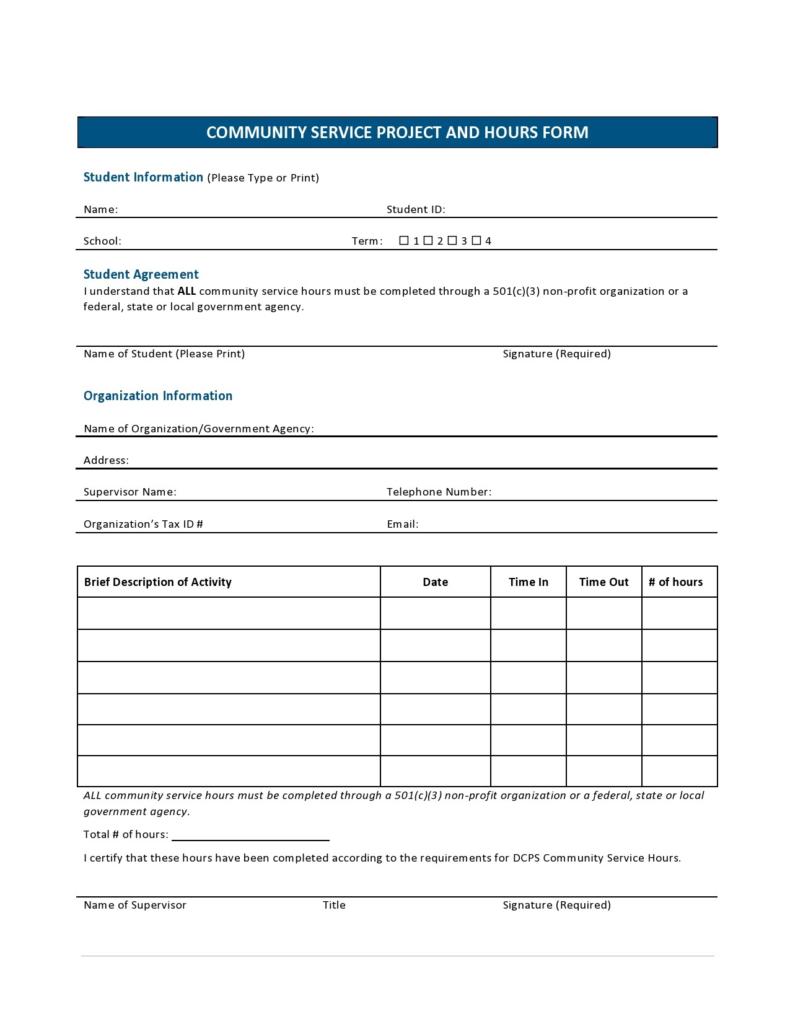
Community Service Forms
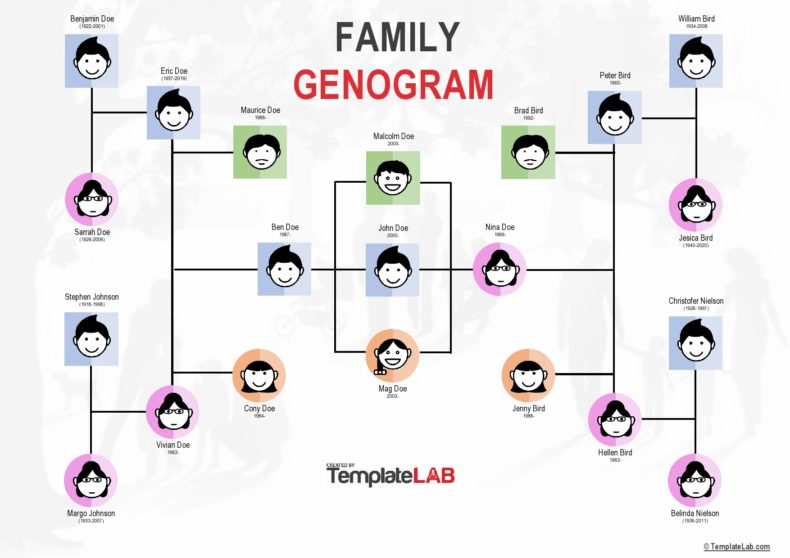
Genogram Templates
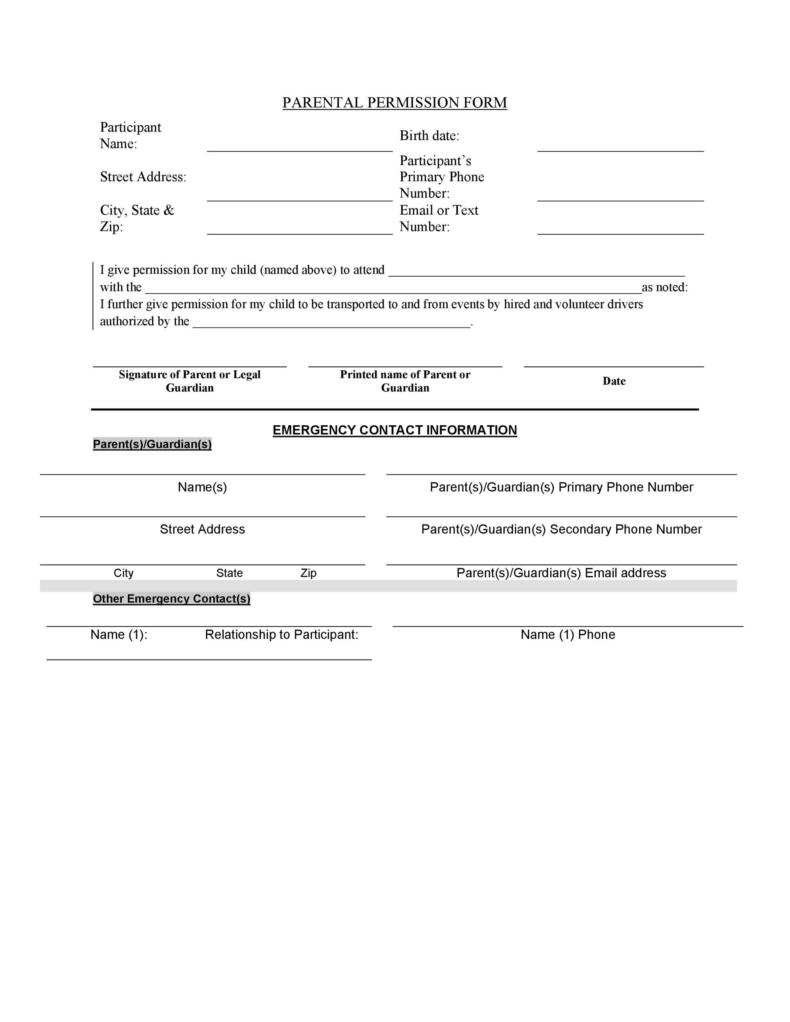
Permission Slip Templates
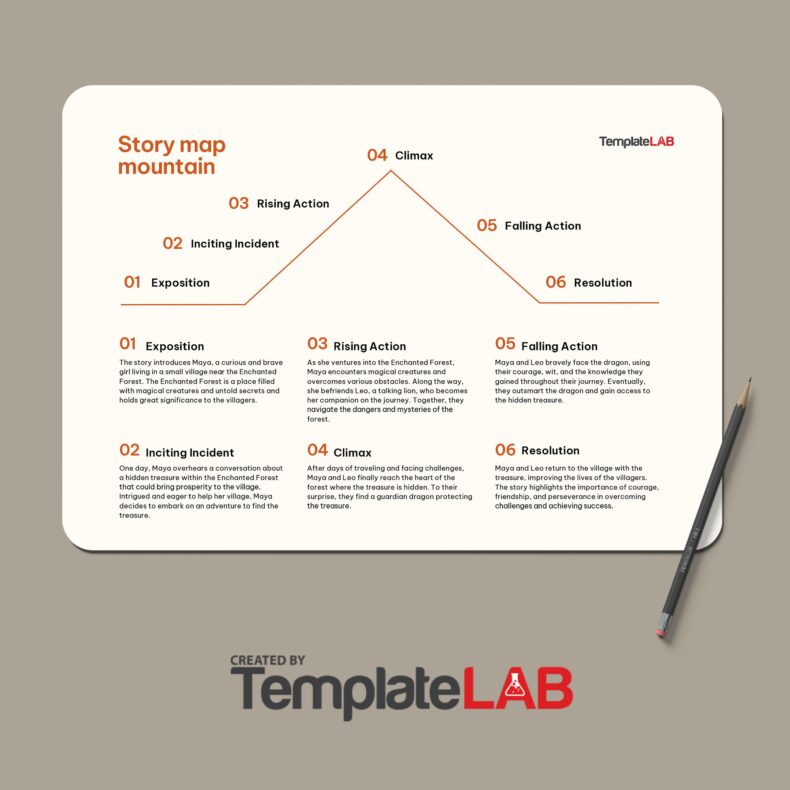
Story Map Templates

Essay Outline Templates
Book Report

What is a Book Report & How to Write a Perfect One
Published on: Jan 26, 2022
Last updated on: Jul 23, 2024

Share this article
Writing a book report is a terrifying experience for many students. The terror begins with reading and understanding what you're reading but then continues as your thoughts become paper in front of you.
Have you ever been assigned a book report and thought, ‘Ugh! This is going to be terrible?’ Well, we're here to help.
Below you can find a helpful guide to understand how to write a perfect report. Here we have also provided some sample book reports and a free book report template for your help.
On This Page On This Page -->
What is a Book Report?
A book report is an informative piece of writing that summarizes the novel and presents some brief analysis on its main elements like plot, setting, characters.
This could either be a work of fiction or nonfiction, with a tone covering everything from serious to humorous.
A book review is not the same as a book report.
Although they may look similar, one requires in-depth analysis and an objective point of view, while the other is more descriptive and subjective.
Some course instructors may ask students to add relevant themes of the book and plot elements into their book reports. But, on a very basic level, a book report is an extremely simple form of review for any given text - no matter what its genre or author.
How does a book report writing benefit you?
Writing a good report will help students to improve their analytical and communication skills. They also get the opportunity to practice expressing themselves through creative or critical thought about the different aspects of books they read.
Assessing the Book Before Writing the Review
Before delving into the content of a book, it's essential to gather some key information. Begin by noting the following details:
- Author: Who authored the book? Are you familiar with any other works by this author?
- Genre: What category does the book fall into - fiction, nonfiction, biography, etc.?
- Which audience would find this type of book appealing? Is this your typical genre preference? Do you enjoy reading books within this genre?
- Title: How does the title impact you? Does it pique your interest? Does it align well with the book's content?
- Pictures/Book Jacket/Cover/Printing: Analyze the book jacket or cover. What does it convey? Is it an accurate representation of the book? Did it generate excitement for you to read it? Are there any illustrations or images within the book? If so, what type are they, and do they captivate your interest?

Paper Due? Why Suffer? That's our Job!
Book Report Outline
Writing a book report becomes more manageable when you follow a structured outline. Here's an outline you can use as a guideline for your book report:
|
How to Write a Book Report?
Writing a book report involves several key steps that can help you effectively communicate your understanding and analysis of a book. Here's a guide on how to write a book report:
Introduction
- Begin with an engaging introductory paragraph that includes the book's title, author, and publication information.
- Provide a brief overview of the book's genre and main theme.
- Include any initial reactions or expectations you had before reading the book.
- Summarize the main plot or central idea of the book without giving away major spoilers.
- Highlight key events, conflicts, and characters that drive the narrative.
- Focus on the most significant aspects of the story and avoid excessive details.
Analysis and Evaluation
- Analyze the author's writing style, storytelling techniques, and use of literary devices.
- Discuss the book's strengths and weaknesses, supporting your statements with examples from the text.
- Evaluate how effectively the author conveys their message and engages the reader.
- Consider the book's impact on you personally and its relevance to broader themes or issues.
Themes and Messages
- Identify the main themes or messages explored in the book.
- Discuss how these themes are developed throughout the narrative.
- Provide specific examples or quotes to support your analysis.
Character Analysis
- Analyze the main characters in the book, their development, and their relationships.
- Discuss their motivations, personalities, and how they contribute to the story.
- Use examples and quotes to illustrate your points.
- Summarize your main points and overall assessment of the book.
- Offer your personal opinion on the book, highlighting its strengths and weaknesses.
- Reflect on the impact the book had on you and who you would recommend it to.
Formatting and Proofreading
- Structure your book report into paragraphs with clear topic sentences.
- Check for spelling, grammar, and punctuation errors.
- Ensure your report is well-organized and follows a logical flow.
- Citations may be required if you quote or reference specific passages from the book.
Remember, a book report is not just a summary; it also involves critical analysis and interpretation.
By following these steps, you can create a comprehensive and insightful book report that effectively conveys your understanding.
Book Report Examples
Before you head into the writing process of your book report, it's a great idea to take some time and look at examples of other people's book reports.
In this way, you'll see how others have written their own work in an engaging manner that will inspire creativity on your part as well.
Book Report Sample
Book Report on Harry Potter
Book Report on Matilda
Book Report on Pride and Prejudice
Book Report for Kids
Book Report MLA Format
Book Report Worksheet
High School Book Report Template
Non-Fiction Book Report Template
Book Report Template 4th Grade
3rd Grade Book Report Template
Book Report Ideas
Picking a book for your report can be an intimidating task. You don't have any idea which books to read or what the professor will prefer, but there are some ideas of different subjects you could write about:
- To Kill a Mockingbird by Harper Lee
- The Catcher in the Rye by J.D. Salinger
- The Fault in Our Stars book report
- Animal Farm by George Orwell
- The Great Gatsby by F. Scott Fitzgerald
- Brave New World by Aldous Huxley
- Hunger Games book report
- A Tale of Two Cities by Charles Dickens
- Kite Runner by Khaled Hosseini
- Charlotte's webbook report
If you are still not sure about how to write a book report that will help you earn an A, then our essay writer AI is the perfect solution for you. Consider taking professional essay writing assistance from one of our experienced writers who specialize in this area.
No matter if you need help with your college essay, book review, book report, or full-length research paper, we provide essay writing service for students . Contact our expert essay writing service today to get the best assistance with all your academic tasks!
Frequently Asked Questions
What are the main parts of a book report.
The main parts of a book report are the bibliography, characters, setting, themes, and plot. These four elements form a descriptive book report. However, most reports that you will read in high school or college are expository-based, meaning they explore an idea rather than discuss it.
Are book reports essays?
A book report is, quite simply, an essay about a book. A book report is a type of essay that students are asked to write by their teachers. Different formats for this writing assignment may be used, but the most common one is expository style (i.e., telling about something).
How long should a book report be?
Your book report should not exceed two double-spaced pages, and it should be somewhere between 600 and 800 words in length.
What is a thesis in a book report?
After a brief introduction of your topic, you state your point of view on the topic. This sentence is the thesis statement and serves as an overview of what will be discussed in this paper.
Caleb S. (Literature, Marketing)
Caleb S. has extensive experience in writing and holds a Masters from Oxford University. He takes great satisfaction in helping students exceed their academic goals. Caleb always puts the needs of his clients first and is dedicated to providing quality service.
Paper Due? Why Suffer? That’s our Job!

Legal & Policies
- Privacy Policy
- Cookies Policy
- Terms of Use
- Refunds & Cancellations
- Our Writers
- Success Stories
- Our Guarantees
- Affiliate Program
- Referral Program
- AI Essay Writer
Disclaimer: All client orders are completed by our team of highly qualified human writers. The essays and papers provided by us are not to be used for submission but rather as learning models only.
- BookWidgets Teacher Blog

15 Creative and digital book report ideas that will get your students excited to read

Not all students are excited to read a book. So how can you make reading a book more engaging and fun? This is a huge challenge for most teachers, so I hope I can help you out!
Here’s what you’ll find in this blog post (click on the title if you want to jump to the section directly)
5 tips to get your students excited about reading
- 15 creative and digital book report lesson plans (free & ready to use!)
- The complete collection of book report lesson ideas in one assignment (your students get to choose!)
Instructions on how to use these digital book report lesson activities
Before you dive into the book reports, you have to get your students excited about reading first. In this previous post about reading, I’ve listed 10 tips that will encourage your students to read . I’ve come up with 5 more amazing tips! Here we go:
1. Use AR apps

Here are a few apps with amazing storylines and AR books.
- Wonderscope , for example, is an excellent storytelling tool. It uses augmented reality to transform ordinary places into real-time stories. Students also learn to read with the app. They ask questions to the characters in the story and listen to the characters’ answers.
- The Ghostkeeper’s journal and field guide : This book is an immersive adventure for readers aged 10 and up, offering several AR experiences to enhance the storyline. These are accessed via a mobile app “ Ghost-o-Matic ”.
- Bookful creates an engaging reading experience and brings stories and characters in books to life. The app holds the world’s largest 3D/AR library with hundreds of titles from leading publishers and brands such as: The Tale of Peter Rabbit, DK’s Encyclopedia, and children’s favorites such as Barbie, My Little Pony, Thomas & Friends, Transformers, and The Smurfs.
2. Escape lessons

Here are 3 fun ready-to-use escape lessons to spark your students’ joy of reading:
- A Halloween Murder : Let your students investigate the murder of the victim: Brat Spook. When they find the murderer, they get their “inspector” badge. Let them look for evidence in the murder scene, talk to suspects, analyze lab results, and so on!
- Finding Rudolph : Save Christmas by helping Santa find back Rudolph. Students go through different challenges, talk to eye-witnesses, and follow Rudolph through a winter maze, so Santa can deliver all the presents to the children.
- Easter Bunny Substitute : Can your students find a good Easter Bunny replacement? In the last breakout game for the classroom, the Easter Bunny is hurt, so your students need to interview the possible applicants and take tests to replace the Easter Bunny themselves. If they succeed in the challenges, they get an Easter Bunny substitute badge.
3. Storytelling

If you bring cultural elements into your lessons by telling a story, your students will be more eager to learn. Storytelling makes students want to “live the story”. And they do this by reading it. If your story is strong enough, your students will love learning and reading. They will even remember the lesson content better.
Here’s a fun & ready-to-use example: The life of William Shakespeare
4. First chapters

5. Books & sleepovers

You can even add different parts to your sleepover. For example, let students read their favorite passage in a book of choice out loud, and 1 hour before bedtime, all your students take their book and read in silence. Or how about creating cozy themed corners? Fantasy, science fiction, detectives,… When your students are reading in themed corners, they get the full experience. They can even dress up as a character in their book whilst reading.
15 Creative and digital book report lesson plans
Step 1: Get your students excited about reading. ✅ Step 2: make sure they don’t lose their interest when you’re announcing the book report assignment! ☑️ This part can be demotivating.
As the lower grade students often still get fun book report assignments, the higher grade students often get a dull worksheet where they have to describe the characters and give a summary. Change up your book report assignments with these creative, free & ready-to-use lesson ideas.
Take a look at all these ready-to-use and free digital book report activities. They’re all made with BookWidgets . You can even make exercises like these yourself in your own BookWidgets account.
Keep on reading to find out how to use these exercises in your lessons.
How did your students experience the book? Let them fill the glasses with drawings of the storyline/the book. The glasses represent the view of the students. Students can get really creative and use the toolbar at the bottom to draw and type.
You can ask your students to present their book report artworks to the other students as well. This way, your students can explain what’s on their drawing.
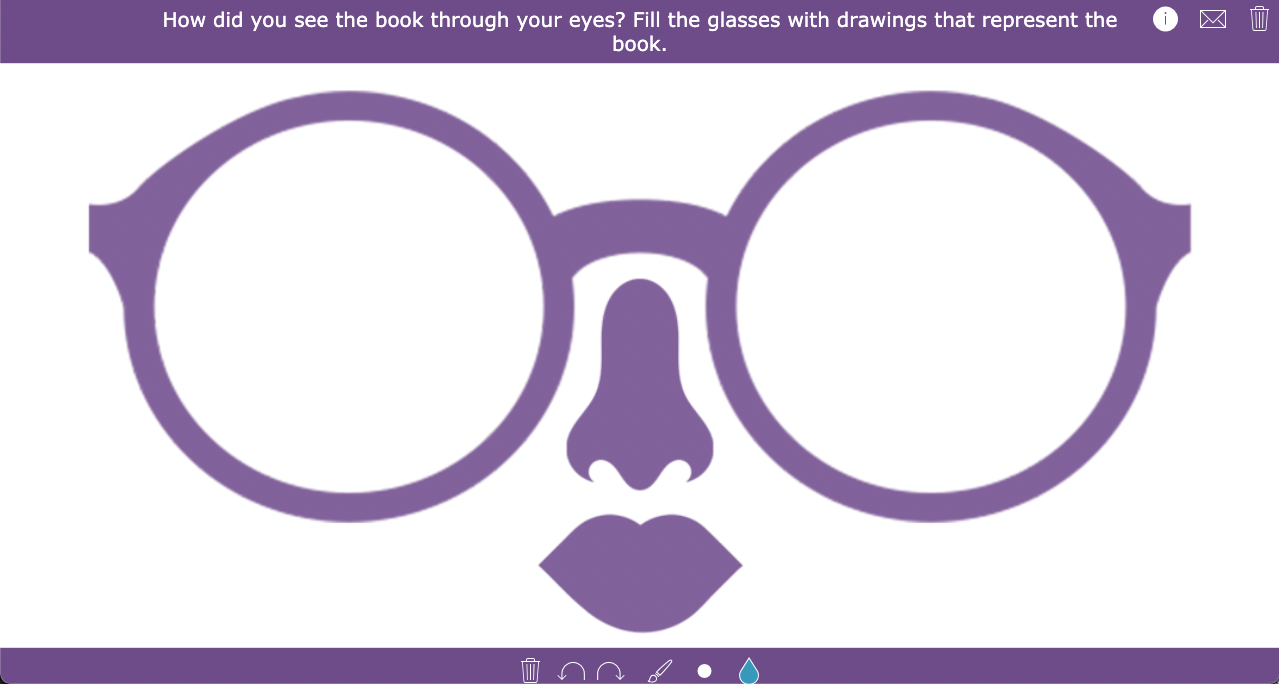
2. Bookworm
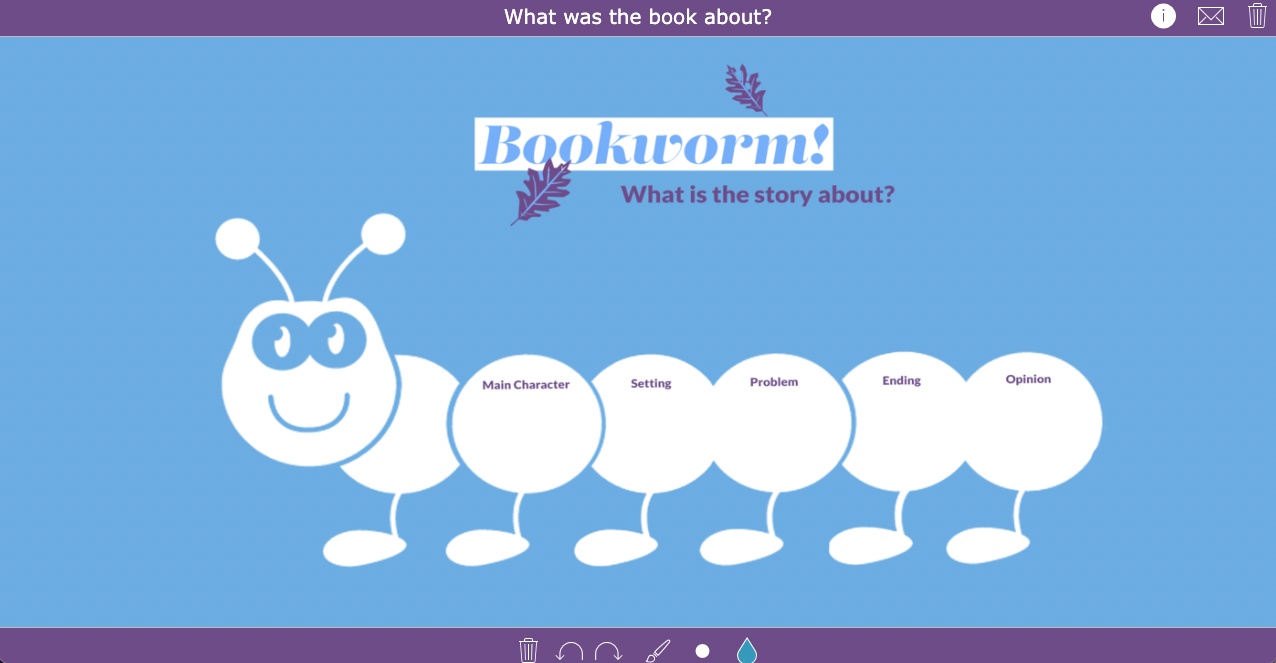
3. Timeline
This interactive book report asks your students to create a timeline of the story. When did what happen, chronologically? The have to add the biggest events in the story to the timeline.
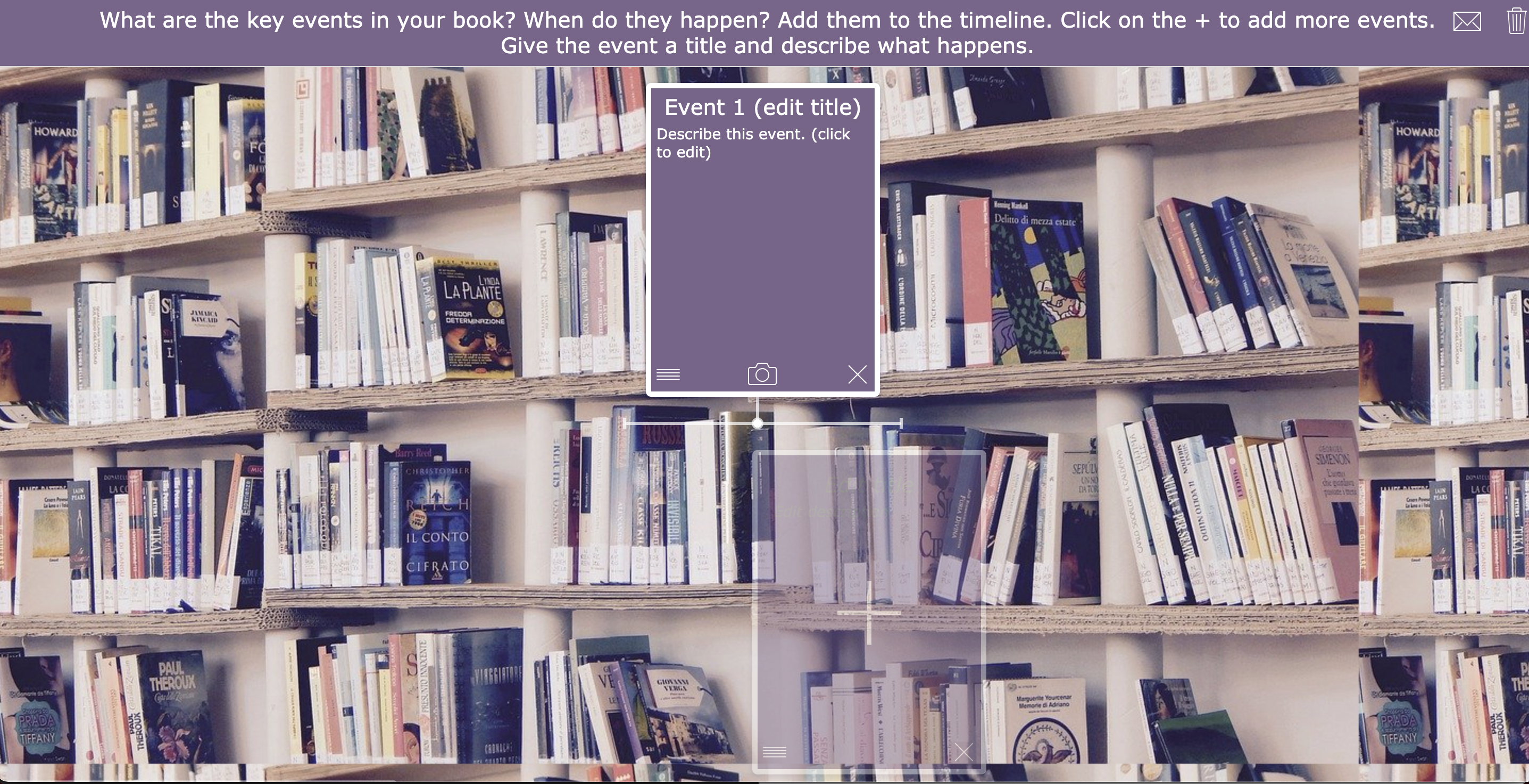
4. Comic book
In this book report exercise, your students have to write a comic book based upon the book they’ve just read. When they click on the “start” icon, they can choose fitting text balloons to go with their story.
Here are three other fun websites that let students create comic books: Storyboard That , Comic Life , and Toonytool . They already give you creative templates and drawings. This is a bit easier for students. This way, they don’t have to start from scratch.
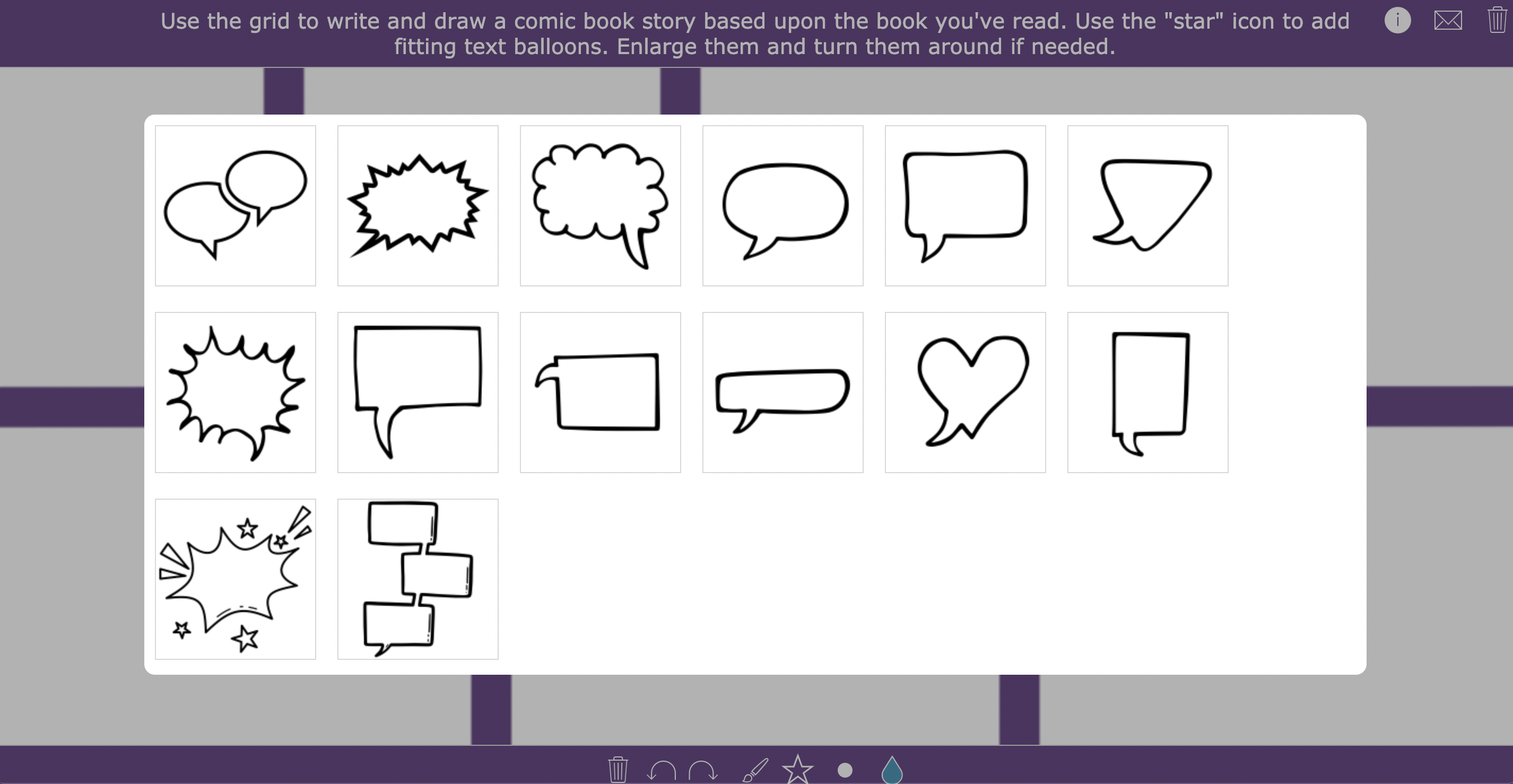
5. Character portrait
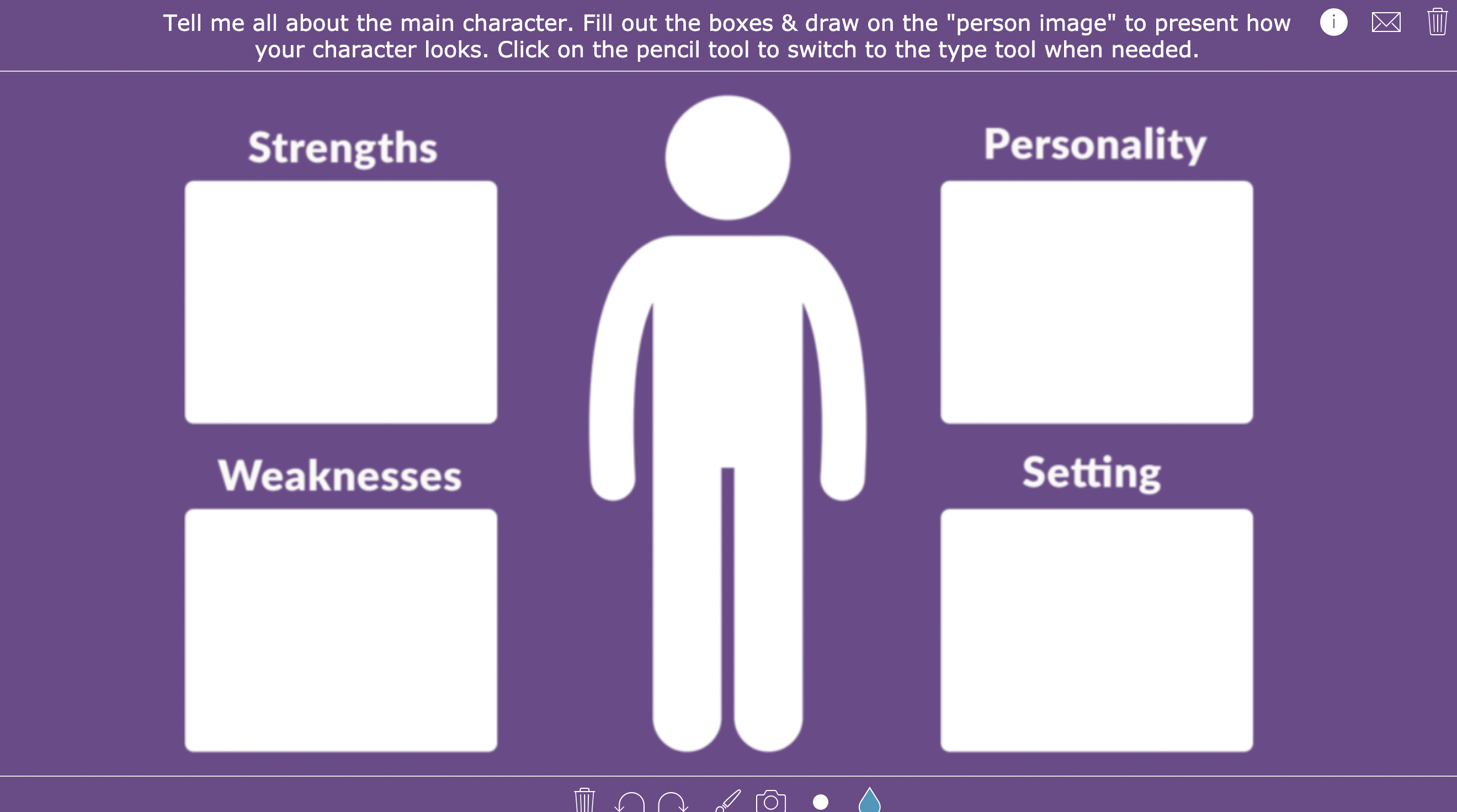
6. Randomness task
Just… add a little spice. I’ve turned the ordinary book report task, where students have to describe characters, the setting, plot, etc., into an exciting one. Your students don’t know yet what they’ll have to describe. They spin the randomness wheel and their task appears. The fun thing about this one is that all of your students will write a different book report.
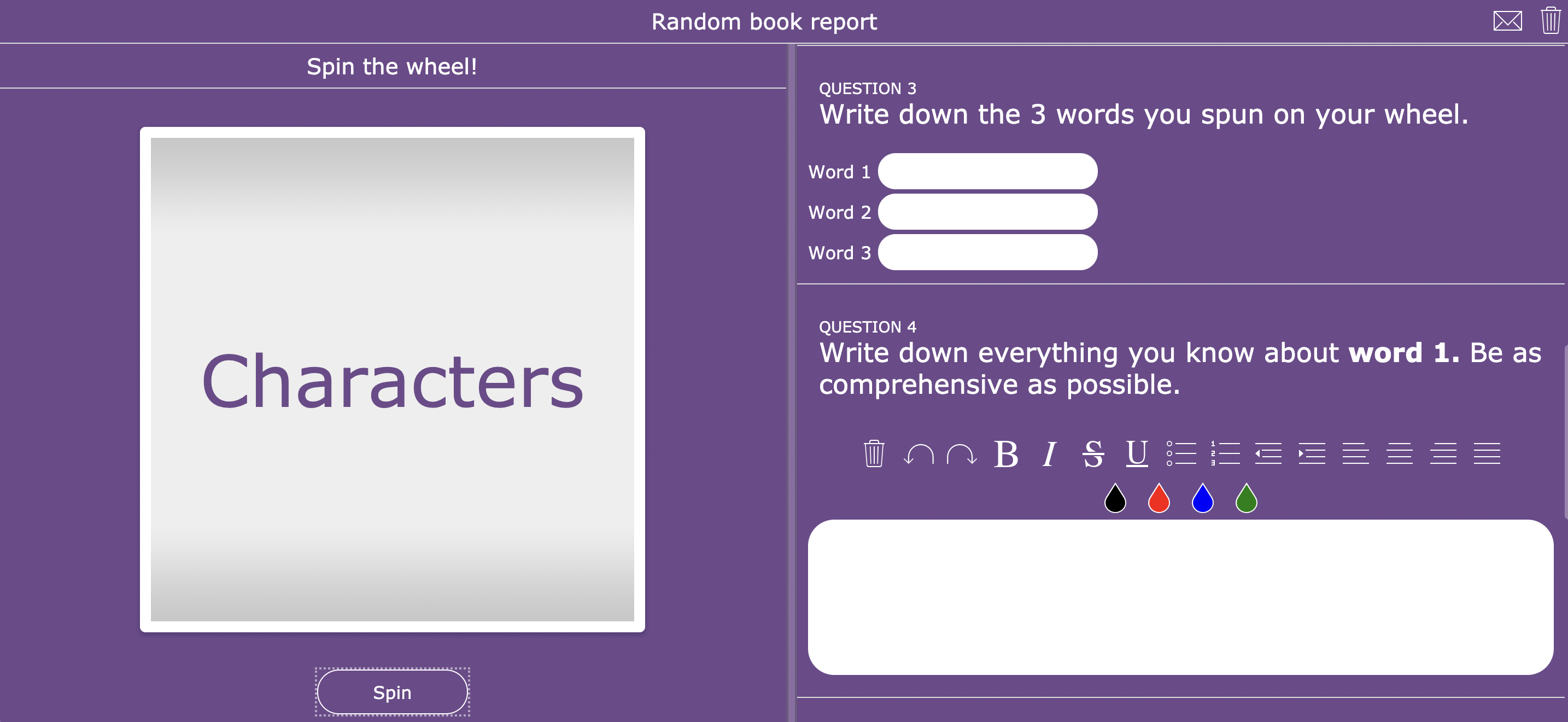
7. Book cover
Here, students get to be creative and invent their own book cover (front and back) of the book they just read. Or maybe just a cover for of a piece of text you’ve read out loud. They can use the whiteboard tools: pencil, type tool, switch colors, add images, etc.
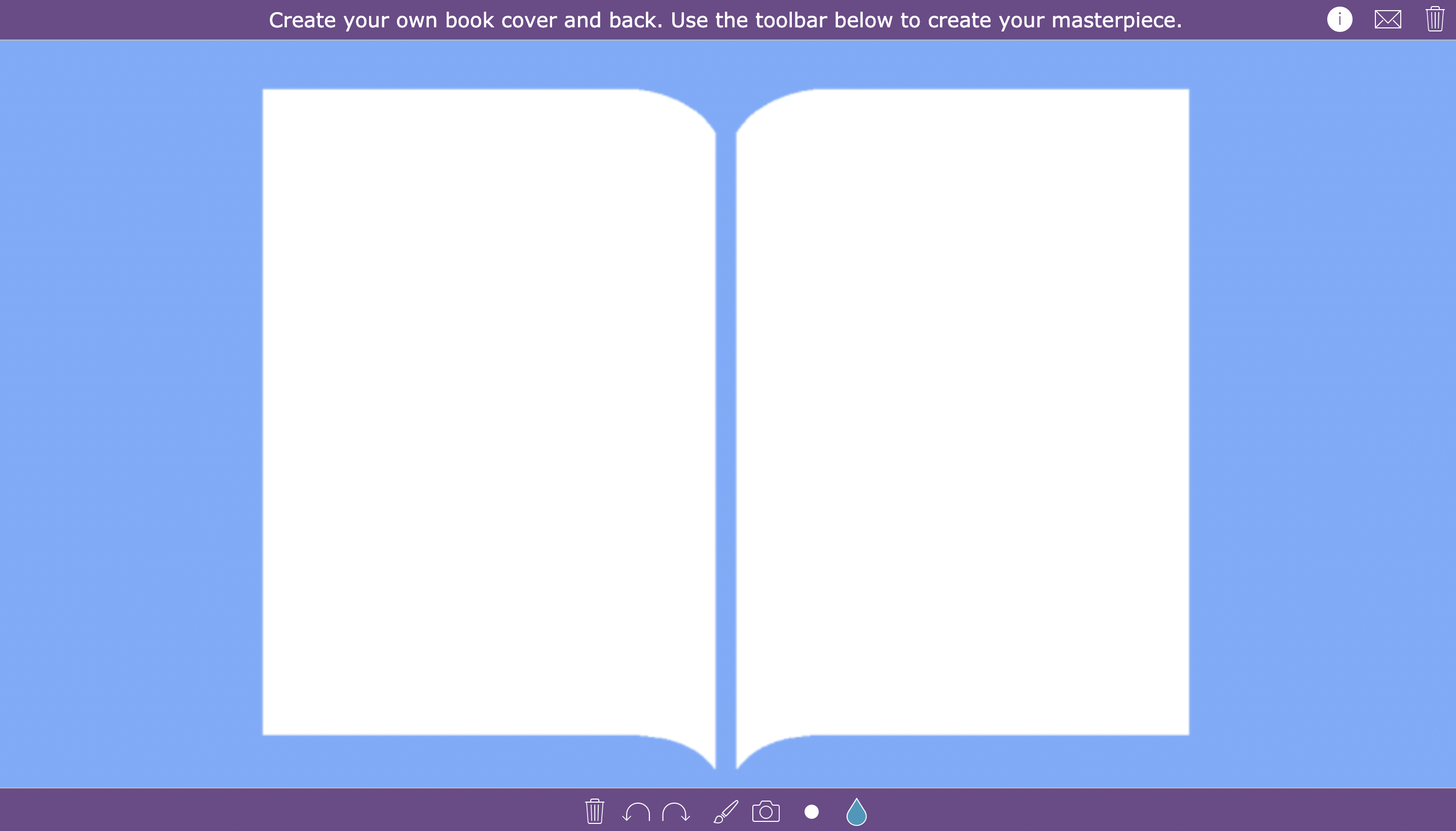
8. Character family tree
This digital mind map exercise allows your students to add boxes with text and connect them to each other. This is perfect for a book report activity focusing on the characters in their book.
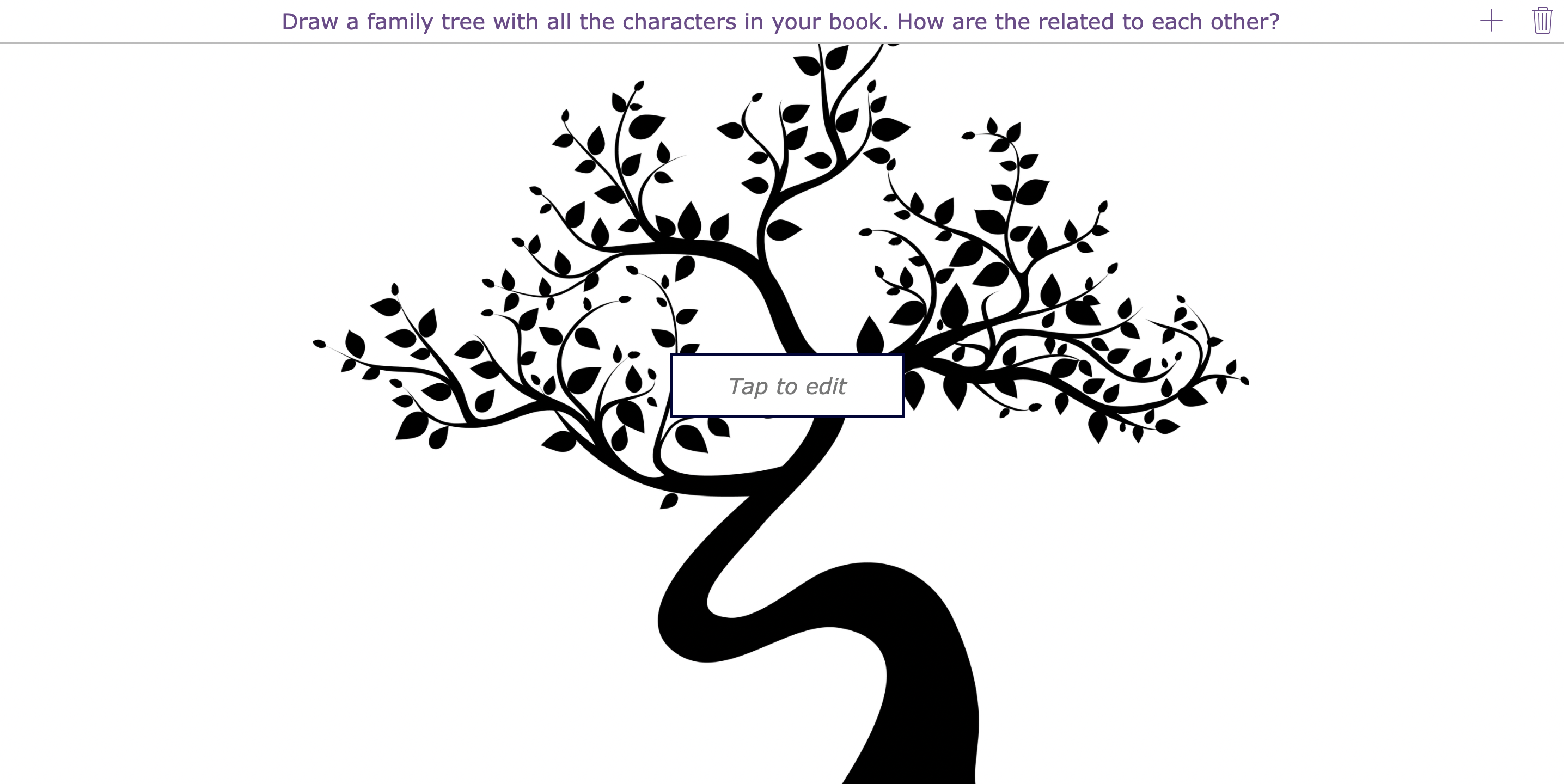
9. Facebook Profile
Modern days call for modern book report lesson ideas. Image the main character having a Facebook profile. What would be on it? That’s exactly what your students have to figure out here. Create a Facebook profile about the main character.
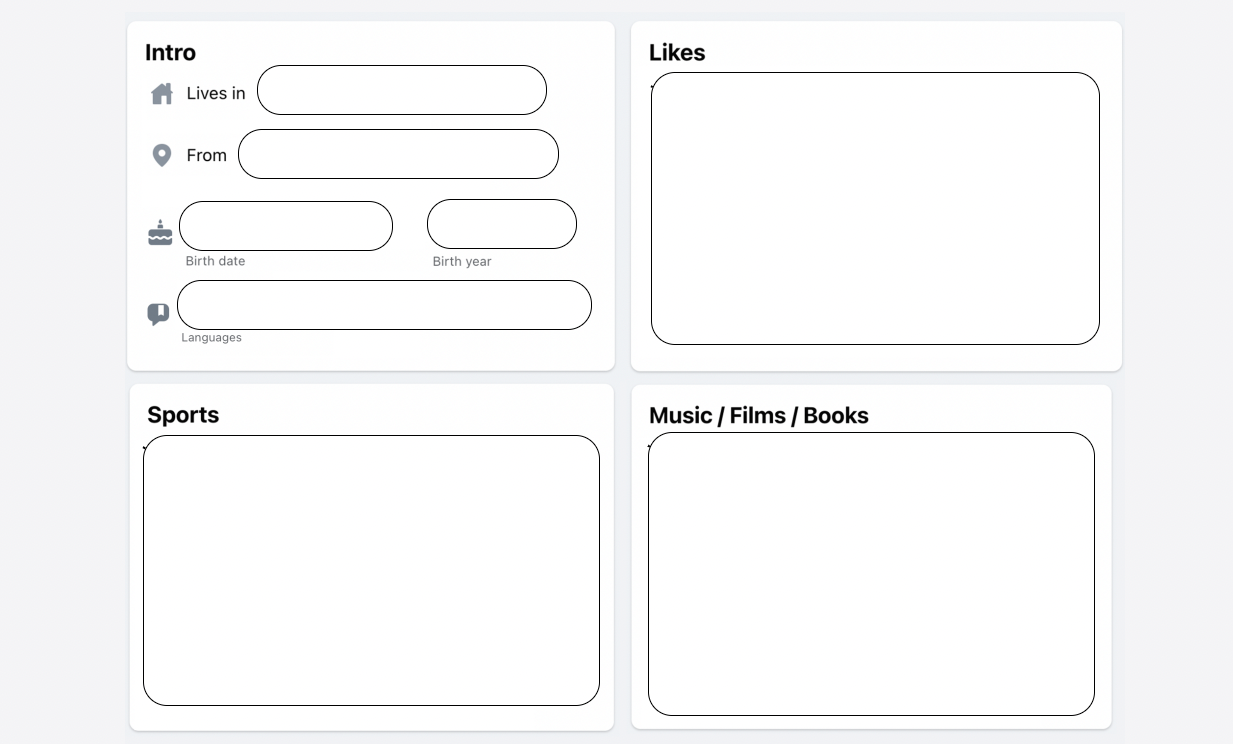
10. Book Collage
Here, students have to add 10 pictures or images that have to do with the book. They can do so by clicking on the photo icon and adding images into their collage.
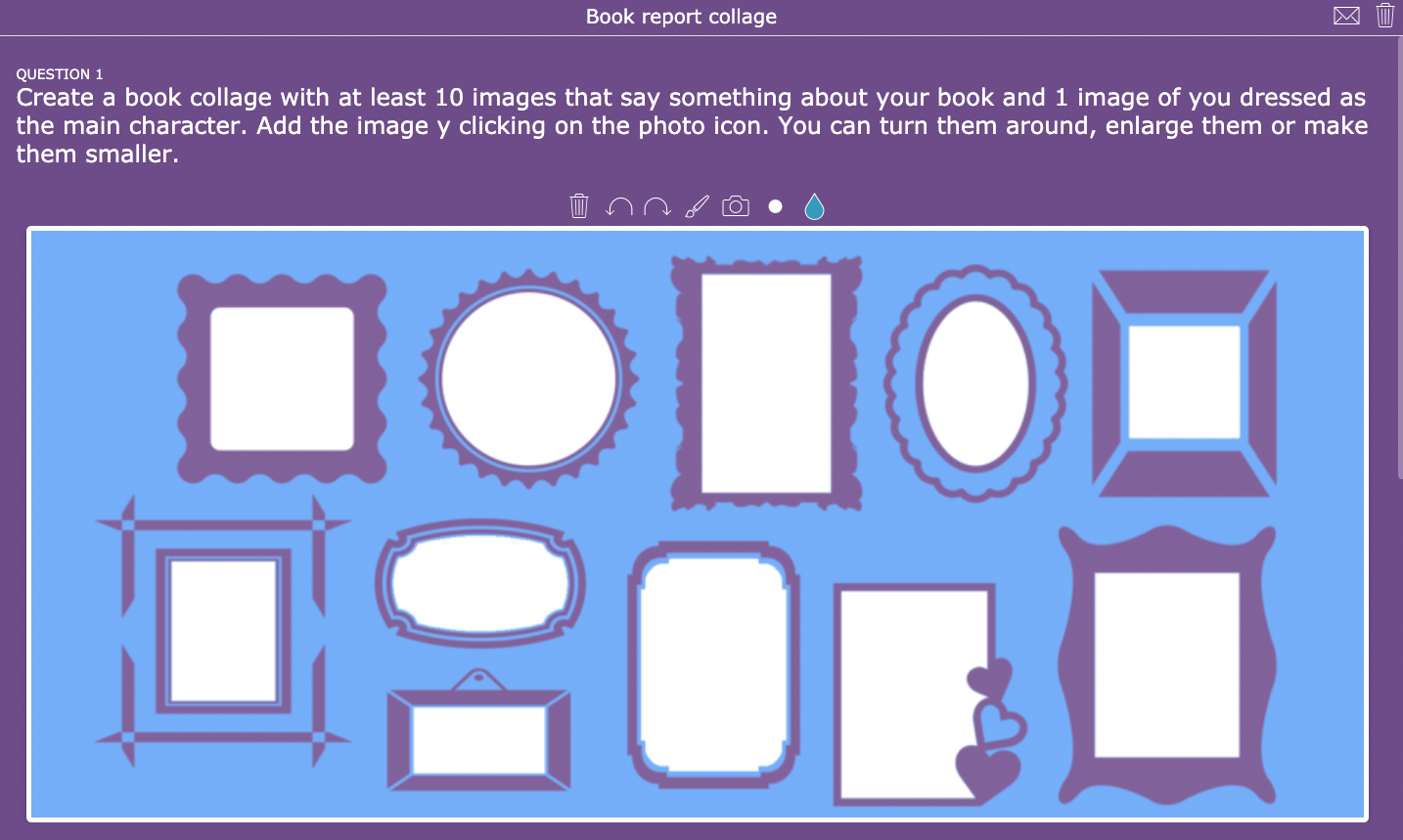
11. Mirror selfie
In this creative book report, students have to dress up like the character in their book, including holding 3 attributes that refer to the personality of the main character. They have to take a picture or mirror selfie of themselves dressed up, and add that picture to the whiteboard. You can ask them to come forward and present their images and explain why they’ve chosen those specific attributes.
The fun thing about all of these exercises is that they work on smartphones as well. So in this case, students can just open the exercise on their smartphones, take a mirror selfie with their phones and add it to the mirror in the digital whiteboard exercise.
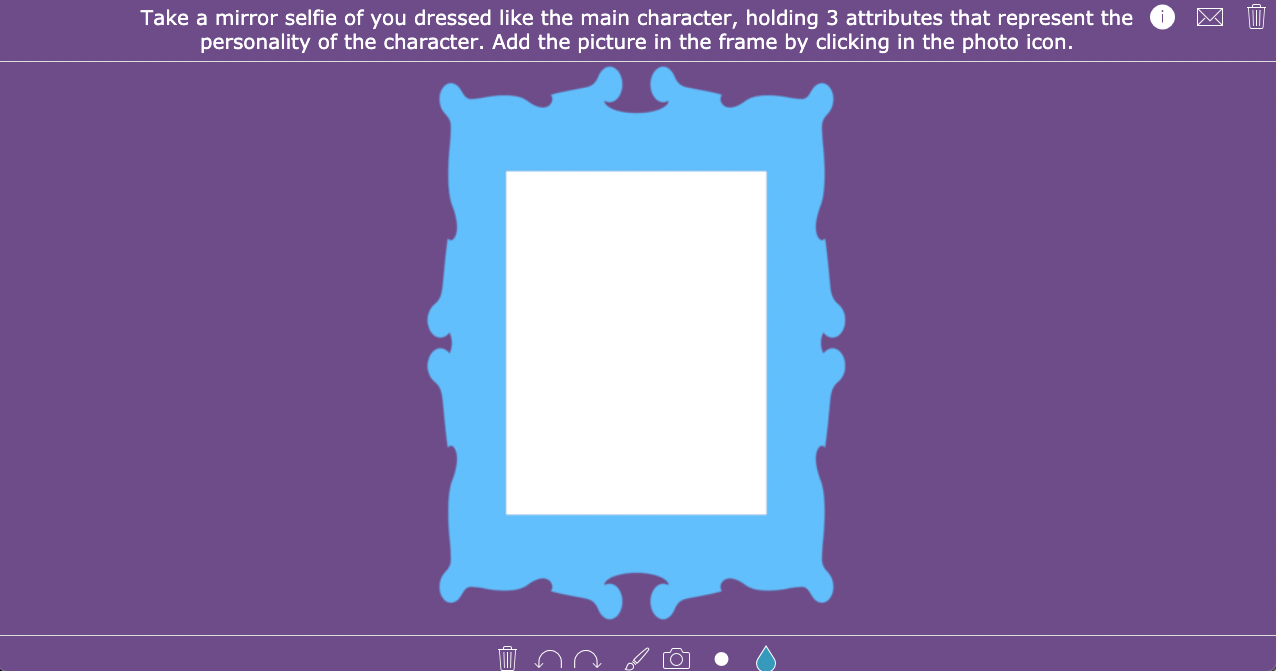
12. Email to the author
Your students have the chance to write a friendly email or letter to the author of the book they just read. Students have to share:
- their opinion;
- the character in the book they liked most, and why;
- their favorite part of the book and why;
- questions that they have about the book.
If you have an email address of the author, ask your students to submit their works to you, the teacher, first. After having given feedback on their letters, they can make some changes and send it over to the author.
If you have the author’s postal address, it’s much more fun to write a classic letter.
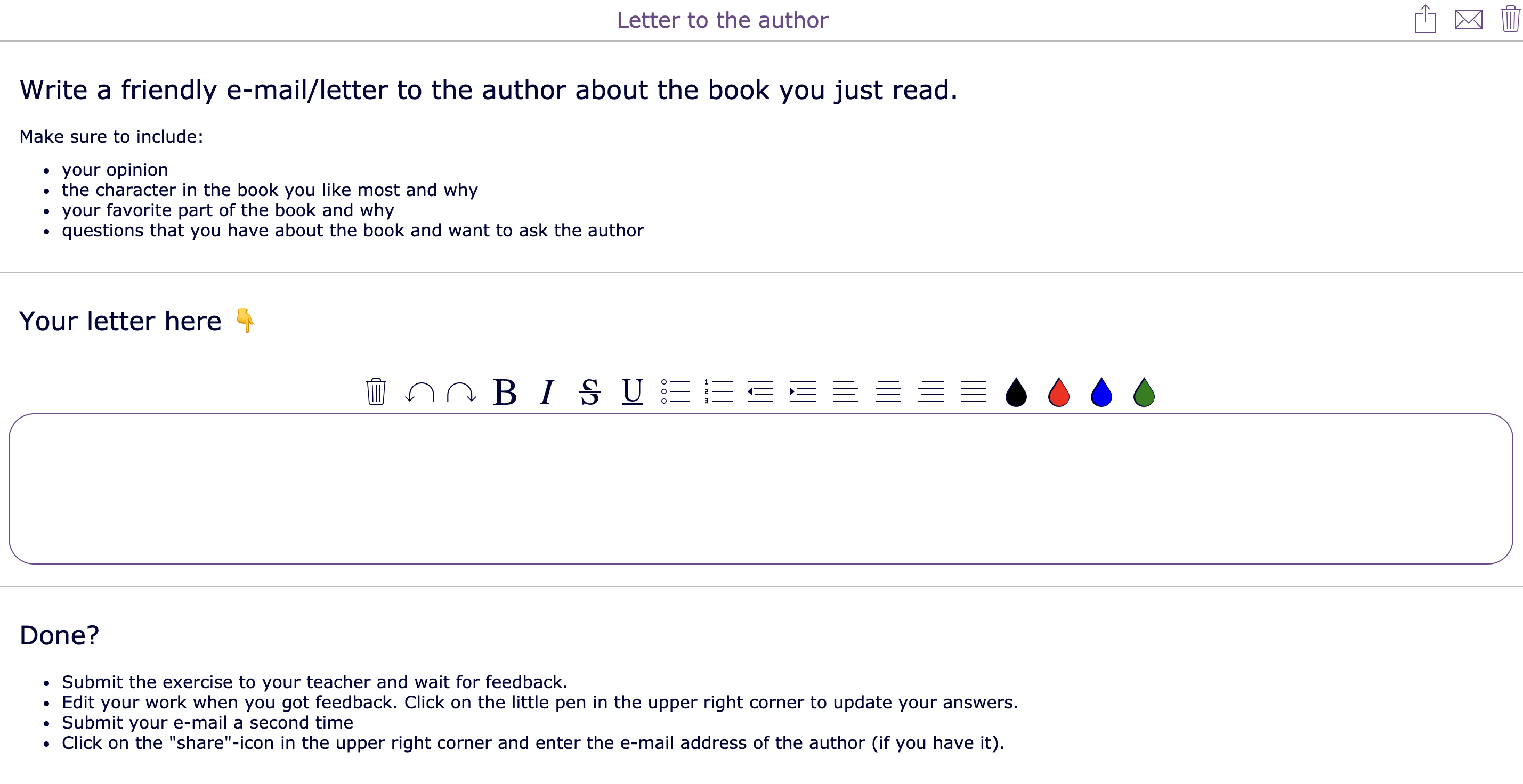
13. Conversation between characters
There is something called a “texting thumb” or a “smartphone pinky”. This shows that students like to send texts. A lot of them. So why not include it in your book report lesson plan? In this digital book report, students have to invent a conversation between two characters in their book.
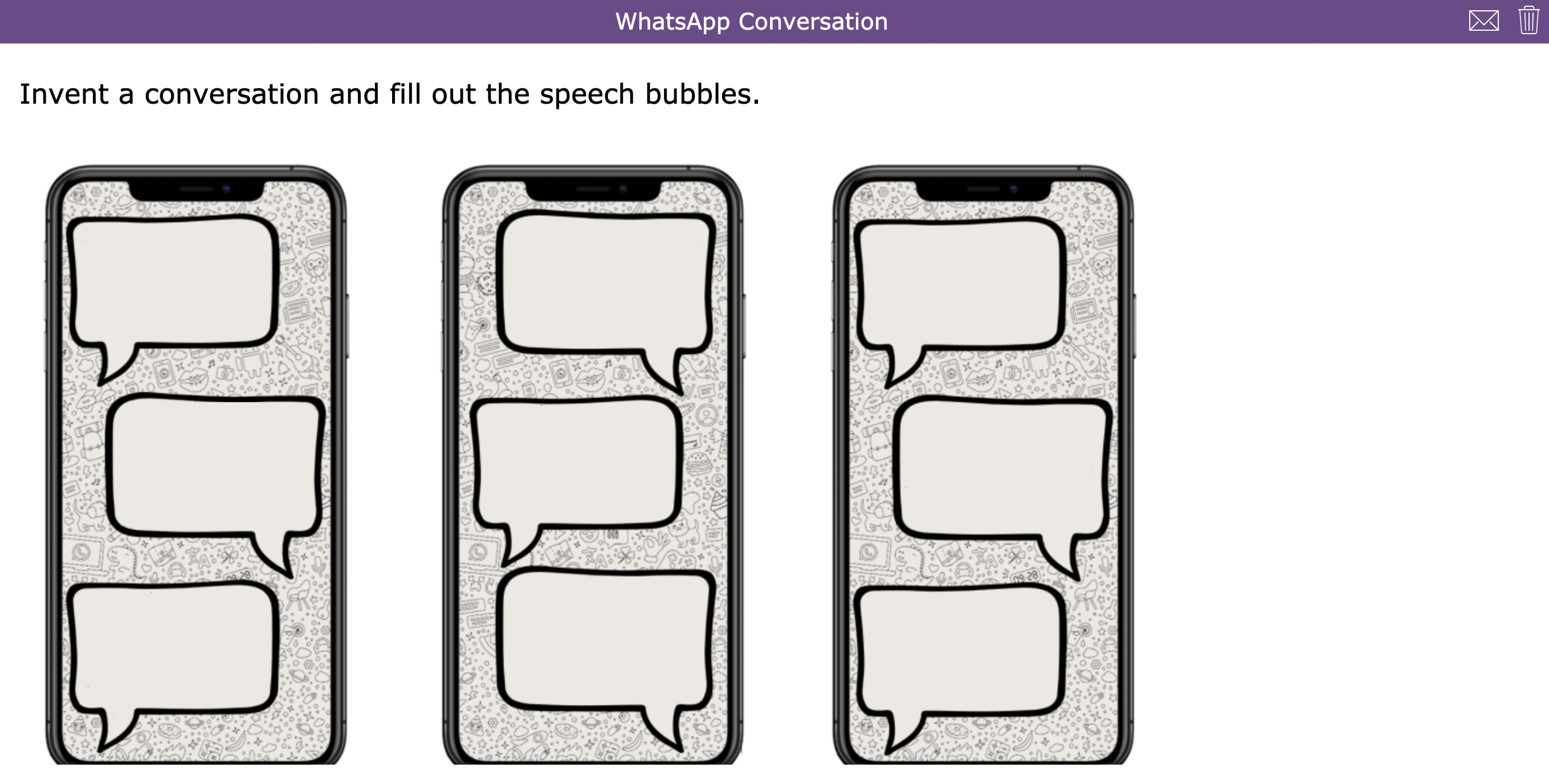
14. Movie vs. Book
A lot of books have a movie version too. If your students choose a book that also has a movie, it’s interesting to let your students make a comparison. With this book report exercise, you’re also sure your students actually read the book instead of just watching the movie and write a summary of the movie and not the book.
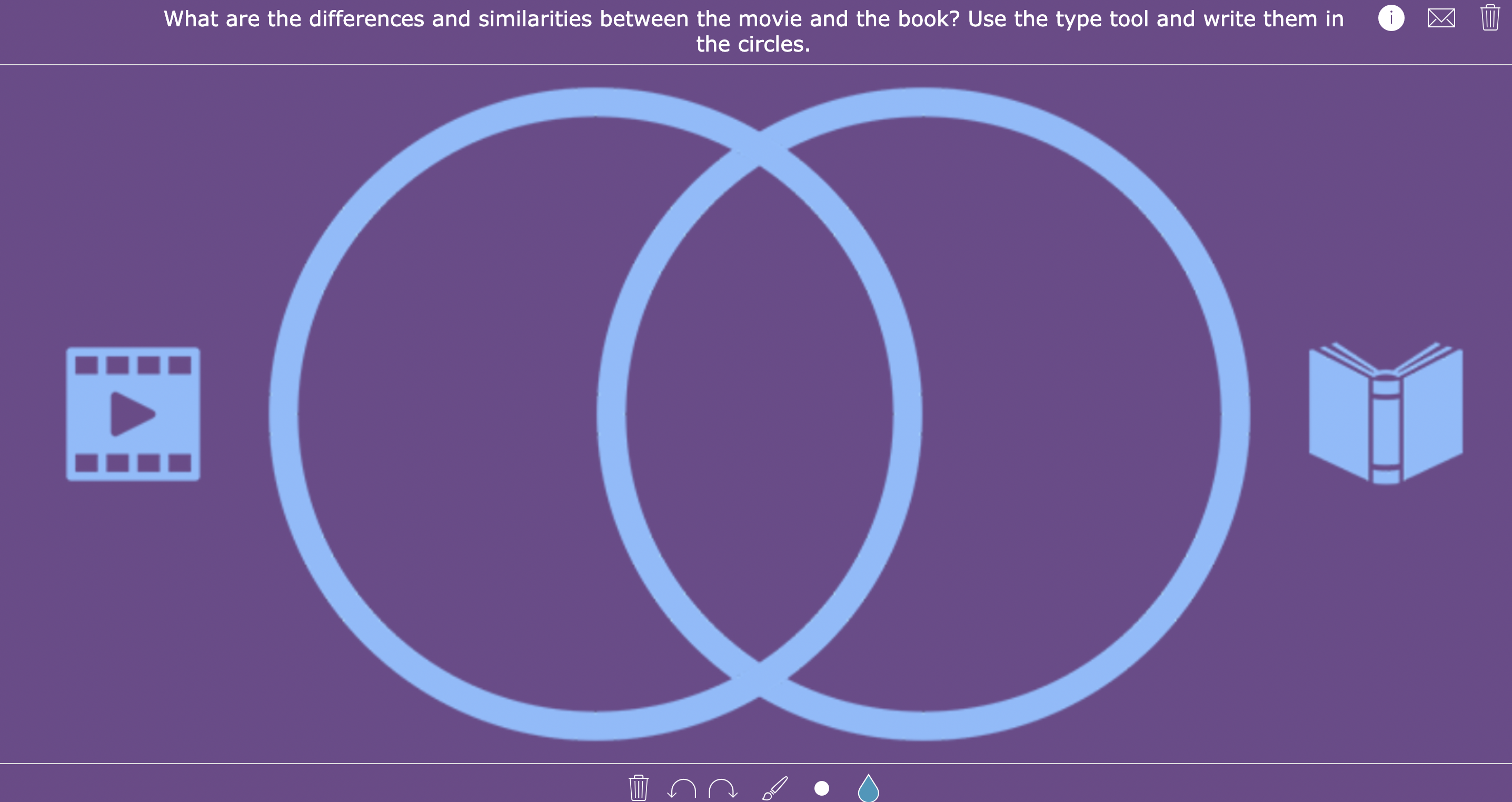
15. Emoji summary
The last exercise is also one students can relate to. Nowadays, we use emojis after almost every sentence when we’re communicating with friends. Emojis also have a strong meaning and can be used to express feelings or say something without actually saying it.
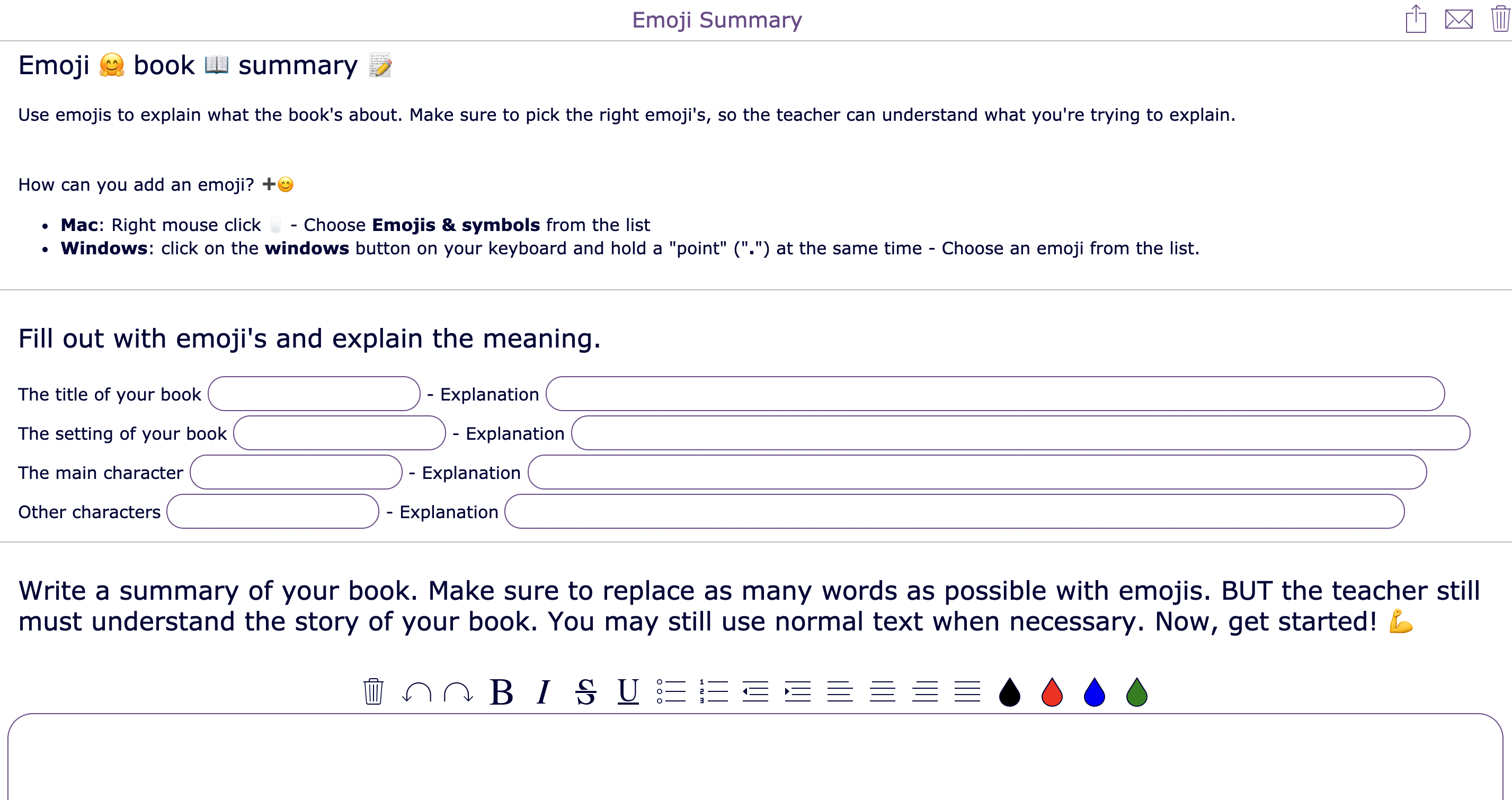
The complete collection of book report lesson ideas in one assignment
All these book report exercises are so much fun and yet they don’t take up a lot of time. Perhaps they just ask your students to only describe a certain part about the book. Cue… the planner widget.
With this type of BookWidgets activity, you can combine several lessons into one. You can let your students take matters into their own hands and choose which book report activities they’d like to finish.
It’s actually pretty easy. Your students read the instructions in the instructions widget and then start adding at least three book report activities to their planner. They finish the activities, submit them to their teacher, check off their planner, and that’s it!
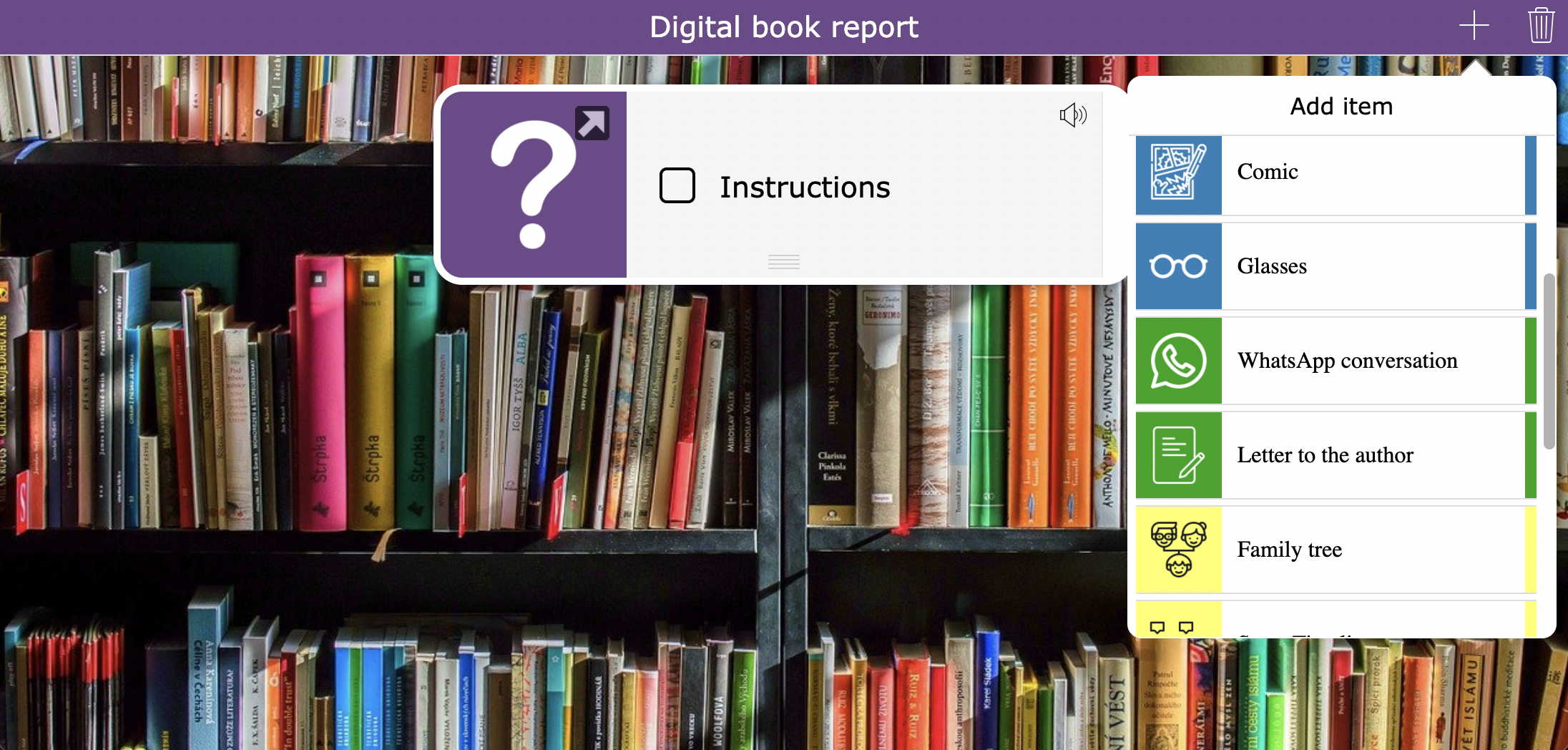
Above, you can find the 15 ready-to-use book report activities. You can use these lesson examples for free. Since they’re all made with BookWidgets, I’ve listed them in this BookWidgets group . Here’s what you need to do:
- Click on this link . It will immediately bring you to the group with all of the book report activities. If you don’t have a BookWidgets account yet, you’ll have to sign up first for free .
- Duplicate all the book report activities. Click on the settings wheel , select all widgets , click on the settings wheel again, choose duplicate selected widgets . Choose where you want to save the activities in your BookWidgets account.
- Go to your saved book report lessons. You can now click on the black dropdown arrow next to the ‘Show’ button of a particular exercise and select Edit . You can make some changes to this activity (if you want). If it’s perfect for you, click on Share in the upper right corner.
- Share this link with your students. When they click on it, they can fill it out. A lot of the book report examples above have been made with BookWidgets’ Whiteboard widget, in which students can use the tool menu at the bottom to switch tools (draw, type,…), and to switch colors. When done, they can submit the book reports to you by clicking on the envelope in the upper right corner.
- As a teacher, you go to “Grades & reporting” in BookWidgets to find your students’ answers.
Of course, now that you’ve got your own BookWidgets account, you can also create book report activities or other assignments yourself!
Attention! Once your free trial runs out, you’ll only be able to use the widgets you’ve already finished/shared with students. While your BookWidgets account will still work and you’ll still get your students’ results with the free BookWidgets version, you won’t be able to duplicate widgets nor create new widgets yourself anymore.
So that’s it! I hope these lesson ideas are useful for your classroom or at least give you lots of new ideas for your book report lessons! You can even create ones yourself!
Create your first digital book report with BookWidgets
Have fun, share this with fellow teachers and keep on rocking your classroom!
Join hundreds of thousands of subscribers, and get the best content on technology in education.
BookWidgets enables teachers to create fun and interactive lessons for tablets, smartphones, and computers.


COMMENTS
What is a book report? A book report is a written summary of a book's content and your analysis of it. It includes an introduction, plot summary, analysis, and conclusion. A book report is typically assigned to students in middle or high school, but it can also be assigned in college. Book reports are typically 250-500 words long.
2. Identify the main elements of the book. Scrutinize the book's primary components, including its main themes, characters, setting, and plot. These elements will form the basis of your report. 3. Formulate a thesis statement. Compose a thesis statement that encapsulates your personal perspective about the book.
Here are 42 creative book report ideas designed to make reading more meaningful for kids. MiddleWeb. 1. Concrete Found Poem. This clever activity is basically a shape poem made up of words, phrases, and whole sentences found in the books students read.
Steps: Title and Author: Include the book's title and the author's name. Plot Summary: Provide a detailed summary with major plot points. Character Analysis: Discuss the main and secondary characters, their development, and relationships. Theme Analysis: Identify and explore the main themes with examples from the text.
With this 6-8th grade template, students write a two-sentence summary, important quotes and whether they recommend the book and why. 6th - 8th Grade Book Report Activity #2. Students explain, in two sentences, what the text is about, identify three important events in the text, and choose one quote they think is most important and then analyze ...
The body paragraphs of your book report accomplish several goals: they describe the plot, delve more deeply into the characters and themes that make the book unique, and include quotations and examples from the book. Below are some resources to help you succeed in summarizing and analyzing your chosen text.
Writing the Report. To structure the book reports, Barile recommends eight sections of analysis that will "require students to provide evidence of their choices and reasoning, which helps them think more deeply about what they have read.". For each section, students should give examples from the book to back up their analysis.
Note: A book report is usually assigned to students from secondary schools to colleges. As per book report format, book reports are typically 500-1000 words long. ... Starting with book report examples, let's look at a book report example on The Diary of a Young Girl by Anne Frank.
Include the title and author in your intro, then summarize the plot, main characters, and setting of the book. Analyze the author's writing style, as well as the main themes and arguments of the book. Include quotes and examples to support your statements. Part 1.
A book report is an essay in which students explain and support their thoughts and views on a story, novel, or any other literary work. ... Include quotations, examples, and supporting evidence in the body paragraphs. The body paragraphs are where you can include quotations, examples, and supporting evidence that bring your book report together
Step 2. Once you have finished reading the book and have taken thorough notes, it is time to start organizing your thoughts. Create an outline to structure your report like the one in the example above. Make sure you over all the necessary components.
They are similar to book reviews but focus more on a summary of the work than an evaluation of it. Book reports commonly describe what happens in a work; their focus is primarily on giving an account of the major plot, characters, thesis, and/or main idea of the work. Most often, book reports are a K-12 assignment and range from 250 to 500 words.
1. Write the introduction. The opening is the most significant element of your report because it introduces and presents the topics that will be covered in greater detail. As a result, the introduction paragraph should include both an attention-grabbing hook statement and a thesis statement that sums up everything. 2.
Recording emotional flags: Emotional flags are merely points in the book that bring about emotion. Sometimes, the smaller the better. For example, for an assignment for The Red Badge of Courage, the teacher might ask students to address whether they believe Henry, the main character, is a hero.In this book, Henry sees lots of blood (emotional symbol) and death (emotional symbol) and this ...
For each word (i.e. somebod y), write the story element. For example: Somebody = the aliens, wanted = underpants, but = mom came outside to get laundry, so then = they zoomed back to space. Put this all together and you have a short and sweet summary: The aliens wanted underpants but the mom came outside to get the laundry so they zoomed back ...
The TeacherVision editorial team is comprised of teachers, experts, and content professionals dedicated to bringing you the most accurate and relevant information in the teaching space. View TeacherVision's profile. Assigning a book report? Print and share this set of book report elements, outlines, and examples with your students.
2. Describe the Book's Setting. This is a great way to start the body of your paper because it will set the stage for everything else that you'll discuss in your report. Describe the locations mentioned in the book so that your teacher will know exactly what you are referring to. You may also see status reports.
The start of your book report provides an opportunity to make a solid introduction to the material and your own personal assessment of the work. You should try to write a strong introductory paragraph that grabs your reader's attention. Somewhere in your first paragraph, you should also state the book's title and the author's name.
Four different activities are ready to print to help you take a new spin on your next book report assignment for fiction or nonfiction books. Students will love filling in their mini book report one-pagers or making their selections from the choice board to share details about what they read. Get My Book Report Template Printables.
Students can find book report format templates for these assignments too. These longer reports are written out in paragraph form. The teacher asks the students to address different elements of a book in their own words or with their own formatting. ... Book Report Examples. Download 107 KB #23. Download 75 KB #24. Download 189 KB #25. Download ...
Because students learn the story elements relatively early in their school life, this book report project template makes a great review activity. Using the template, students will identify the story's author, illustrator, characters, setting, problem, and solution. Download template. 4. Book Report Vocabulary Squares.
Here's an outline you can use as a guideline for your book report: I. Introduction. A. Introduce the book with the title, author, and publication information. B. Provide a brief overview of the book's genre and main theme. C. State your purpose for writing the report and any initial expectations you had. II.
Students can get really creative and use the toolbar at the bottom to draw and type. You can ask your students to present their book report artworks to the other students as well. This way, your students can explain what's on their drawing. Click to open. 2. Bookworm. This is a quick exit ticket for book reviews.